Zebra Technologies MC2180 Mobile Computer User Manual
Zebra Technologies Corporation Mobile Computer
Contents
- 1. User Manual
- 2. User Manual (Statements)
User Manual
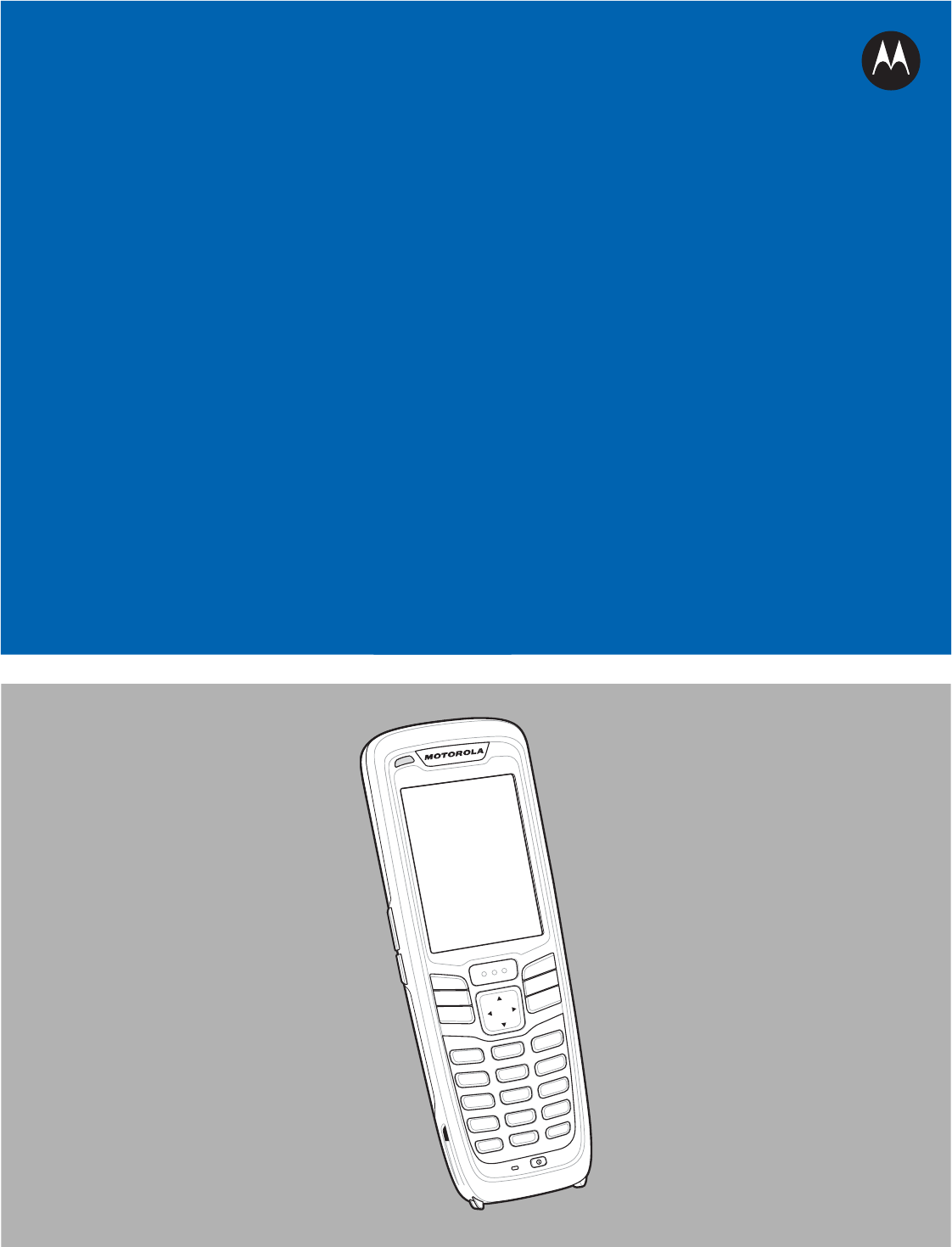
MC21XX SERIES
MOBILE COMPUTER
USER GUIDE
LIM
IMINARY
IM
PRELIM
ELI
ELI
ELI
EL
EL
L
L
L
L
L
PRELIMINARY

MC21XX SERIES MOBILE COMPUTER
USER GUIDE
72E-155020-01
Rev. 101411
October 2011
Y
PRELIMINARY
O
O
CO
USE
7
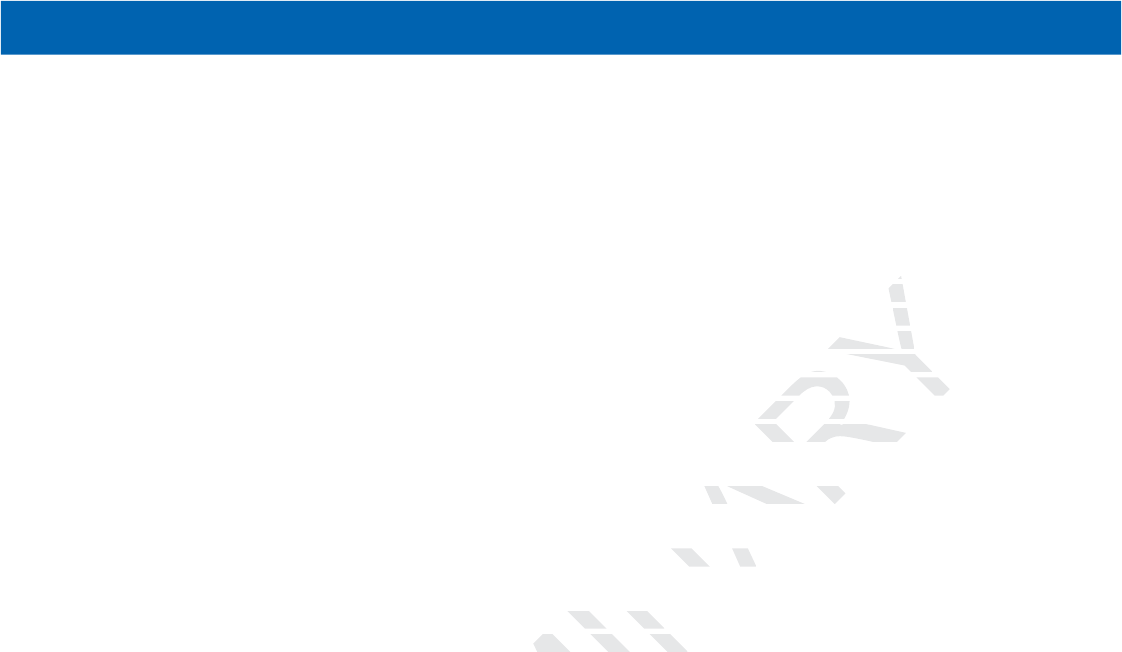
ii MC21XX Series User Guide
No part of this publication may be reproduced or used in any form, or by any electrical or mechanical means,
without permission in writing from Motorola. This includes electronic or mechanical means, such as
photocopying, recording, or information storage and retrieval systems. The material in this manual is subject to
change without notice.
The software is provided strictly on an “as is” basis. All software, including firmware, furnished to the user is on
a licensed basis. Motorola grants to the user a non-transferable and non-exclusive license to use each
software and firmware program delivered hereunder (licensed program). Except as noted below, such license
may not be assigned, sublicensed, or otherwise transferred by the user without prior written consent of
Motorola. No right to copy a licensed program in whole or in part is granted, except as permitted under
copyright law. The user shall not modify, merge, or incorporate any form or portion of a licensed program with
other program material, create a derivative work from a licensed program, or use a licensed program in a
network without written permission from Motorola. The user agrees to maintain Motorola’s copyright notice on
the licensed programs delivered hereunder, and to include the same on any authorized copies it makes, in
whole or in part. The user agrees not to decompile, disassemble, decode, or reverse engineer any licensed
program delivered to the user or any portion thereof.
Motorola reserves the right to make changes to any software or product to improve reliability, function, or
design.
Motorola does not assume any product liability arising out of, or in connection with, the application or use of
any product, circuit, or application described herein.
No license is granted, either expressly or by implication, estoppel, or otherwise under any Motorola, Inc.,
intellectual property rights. An implied license only exists for equipment, circuits, and subsystems contained in
Motorola products.
RY
en cons
n c
permitted un
itte
of a licensed progr
of a license
a licensed program in
a licensed prog
Motorola’s copyright
Motorola’s copyrigh
authorized copies it m
authorized
MINAR
, or reverse engineer
r reverse enginee
roduct to improve relia
uct to improve reli
of, or in connection w
connectio
ation, estoppel, or otheon, estoppel
PRELIMIN
y exists for equipmeny exists for equipme
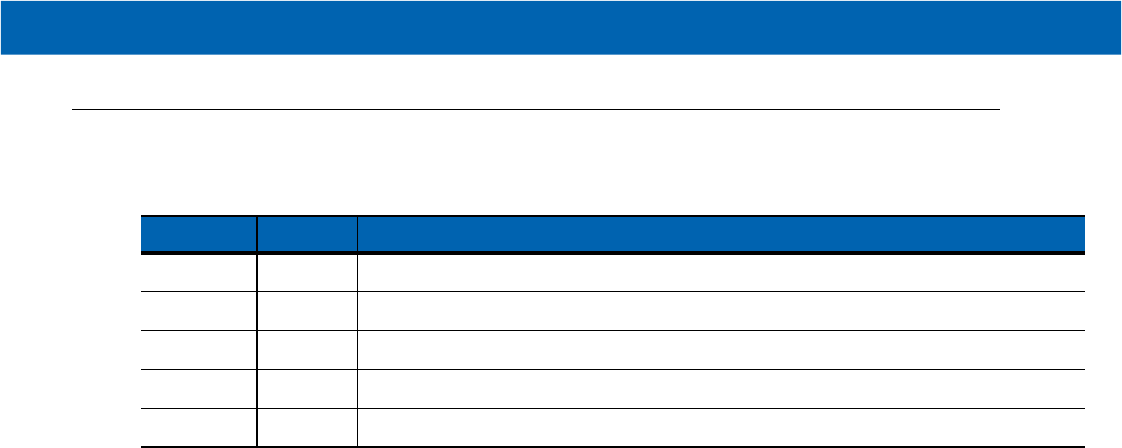
iii
Revision History
Changes to the original guide are listed below:
Change Date Description
RY
Y
Y
RY
ARY
RY
PRELIMINAR
AR

iv MC21XX Series User Guide
PRELIMINARY

TABLE OF CONTENTS
Revision History .............................................................................................................................. iii
About This Guide
Introduction ..................................................................................................................................... i
Documentation Set ................................................................................................................... i
Configurations................................................................................................................................. ii
Software Versions..................................................................................................................... ii
Chapter Descriptions ...................................................................................................................... iii
Notational Conventions................................................................................................................... iii
Related Documents and Software .................................................................................................. iv
Service Information ......................................................................................................................... iv
Chapter 1: Getting Started
Introduction .................................................................................................................................... 1-1
Unpacking the Mobile Computer .................................................................................................... 1-1
Features ......................................................................................................................................... 1-2
Mobile Computer Startup ............................................................................................................... 1-3
Install microSD Card ................................................................................................................ 1-3
Install Main Battery .................................................................................................................. 1-4
Battery Charging ............................................................................................................................ 1-5
Spare Battery Charging ................................................................................................................. 1-7
Starting the MC21XX ..................................................................................................................... 1-7
Calibration Screen ................................................................................................................... 1-7
Main Battery Removal .................................................................................................................... 1-8
Turning Off the Radios ................................................................................................................... 1-9
WLAN Radio ............................................................................................................................ 1-9
Safe System Shutdown/Re-boot .................................................................................................... 1-9
Chapter 2: Operation
Introduction .................................................................................................................................... 2-1
Power Button ................................................................................................................................. 2-1
Windows CE Sample Applications Window ................................................................................... 2-1
RELIMINAR
ARY
AR
...............................
............................
..............................
........................
...............................
..........................
...............................
..............................
..........................................................
...............................
..............................
..............................
.........................
ware .......................................
........................................................
arted
rted
..............................
..............................
e Mobile Computer e Mobile Computer
PR
............................................................
Computer Startup ...Computer Startup ...
stall microSD Card stall microSD C
Install Main BatteryInstall Main Batter
P
ry Charging ...ry Char
attery Chatter
e MCe M

vi
MC21XX Series User
Guide
Windows CE Desktop .................................................................................................................... 2-2
Using the Keypad to Navigate Applications ................................................................................... 2-2
Key Combinations .................................................................................................................... 2-2
Selecting Items .................................................................................................................. 2-3
Adjusting the Volume ..................................................................................................................... 2-4
Adjusting the Screen Brightness .................................................................................................... 2-4
Windows CE Status Icons ............................................................................................................. 2-5
Battery Unknown Icon .............................................................................................................. 2-6
Start Button .............................................................................................................................. 2-6
Programs Menu ....................................................................................................................... 2-7
Control Panel ........................................................................................................................... 2-8
Keyboard Input Panel Button ................................................................................................... 2-9
Desktop Display Button ............................................................................................................ 2-9
Task Manager and Properties ....................................................................................................... 2-9
Task Manager .......................................................................................................................... 2-9
Properties ................................................................................................................................. 2-9
Stylus ............................................................................................................................................. 2-10
Entering Information ...................................................................................................................... 2-11
Entering Information Using Keypad ......................................................................................... 2-12
Entering Information Using the Keyboard Input Panel ............................................................. 2-12
Entering Data via the Bar Code Scanner ................................................................................. 2-12
Resetting the MC21XX .................................................................................................................. 2-12
Performing a Warm Boot ......................................................................................................... 2-12
Performing a Cold Boot ............................................................................................................ 2-13
Waking the MC21XX ..................................................................................................................... 2-13
Battery Health ................................................................................................................................ 2-14
Using the Keypad .......................................................................................................................... 2-15
Browser .......................................................................................................................................... 2-16
TEAM Express ............................................................................................................................... 2-17
Installation ................................................................................................................................ 2-17
Group Broadcast Communication Buttons ............................................................................... 2-17
Chapter 3: Data Capture
Introduction .................................................................................................................................... 3-1
Linear Imager ........................................................................................................................... 3-1
1D Laser Scanner .................................................................................................................... 3-1
2D Imaging ............................................................................................................................... 3-1
Operational Modes ............................................................................................................. 3-2
Scanning Considerations ............................................................................................................... 3-2
Laser Scanning and Linear Imaging .............................................................................................. 3-3
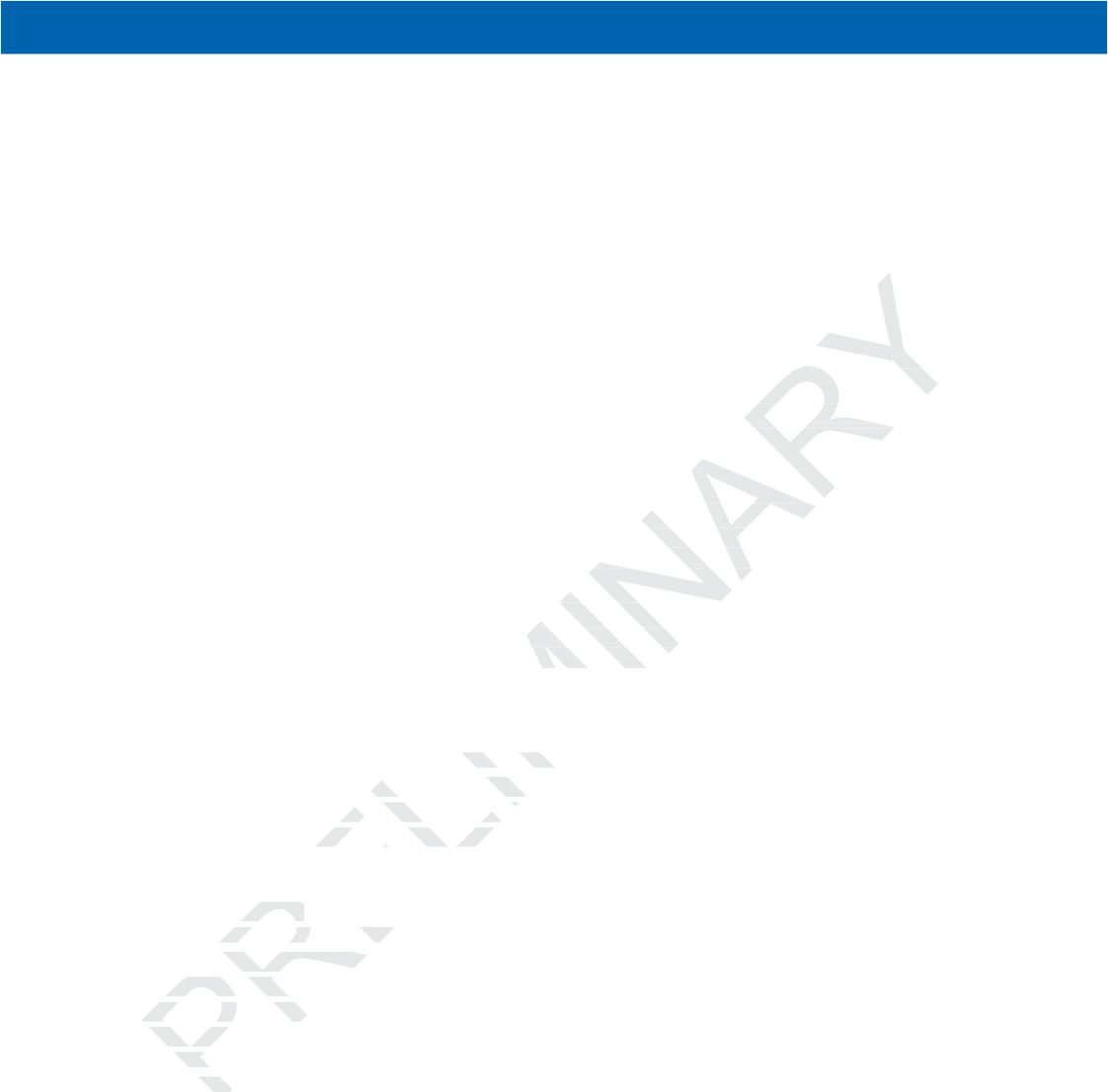
Table of Contents vii
Imager Scanning ...................................................................................................................... 3-4
DataWedge .................................................................................................................................... 3-5
Enable DataWedge .................................................................................................................. 3-5
Disable DataWedge ................................................................................................................. 3-5
Adjusting the Scan Beeper Volume ............................................................................................... 3-5
Using CtlPanel ......................................................................................................................... 3-5
Using DataWedge .................................................................................................................... 3-5
Chapter 4: Bluetooth
Introduction .................................................................................................................................... 4-1
Adaptive Frequency Hopping ......................................................................................................... 4-1
Security .......................................................................................................................................... 4-2
Bluetooth Configuration ................................................................................................................. 4-2
Bluetooth Power States ................................................................................................................. 4-3
Cold Boot ................................................................................................................................. 4-3
Warm Boot ......................................................................................................................... 4-3
Suspend ............................................................................................................................. 4-3
Resume .............................................................................................................................. 4-3
Using Microsoft Bluetooth Stack .................................................................................................... 4-4
Power Modes ........................................................................................................................... 4-4
Discovering Bluetooth Device(s) .............................................................................................. 4-4
Available Services .................................................................................................................... 4-5
Chapter 5: Wireless Applications
Introduction .................................................................................................................................... 5-1
Signal Strength Icon ....................................................................................................................... 5-3
Turning Off the Radio ..................................................................................................................... 5-3
Minimum Setup .............................................................................................................................. 5-3
Chapter 6: Accessories
Introduction .................................................................................................................................... 6-1
Single-slot USB Cradle .................................................................................................................. 6-3
Battery Charging ...................................................................................................................... 6-3
Four-slot Charge Only Cradle ........................................................................................................ 6-4
Battery Charging ...................................................................................................................... 6-4
Power LED ............................................................................................................................... 6-4
Four-slot Ethernet Cradle ............................................................................................................... 6-5
Battery Charging ...................................................................................................................... 6-5
LED Charge Indications ........................................................................................................... 6-5
Speed LED ............................................................................................................................... 6-6
Link LED .................................................................................................................................. 6-6
Four-slot Spare Battery Charger .................................................................................................... 6-7
Spare Battery Charging ........................................................................................................... 6-7
Modem Adapter Cable/Modem Dongle .......................................................................................... 6-8
Setup ........................................................................................................................................ 6-9
Connecting to the MC21XX ................................................................................................ 6-9
USB ActiveSync/Charge Cable ...................................................................................................... 6-11
Battery Charging and Operating Power ................................................................................... 6-11
.................
.................
.............
.....
...............................
..............................
.........................
.......................
......
...............................
........................
..............................
.....................
...............................
........................
..............................
..............................
...............................
.................
..............................
...........................
..............................................................
..............................................
...............................
...........................
PRELIMI
..............................
.......................
..............................
................
...............................
..............................
...............................
...............................
...............................
...............................
ssoriesssories
.............................
.............................
ot USB Cradle .......USB Cradle ......
PR
ttery Charging .......ttery Charging
r-slot Charge Only Cr-slot Charge Only
Battery ChargingBattery C
wer LED ...wer L
P
EtherEthe
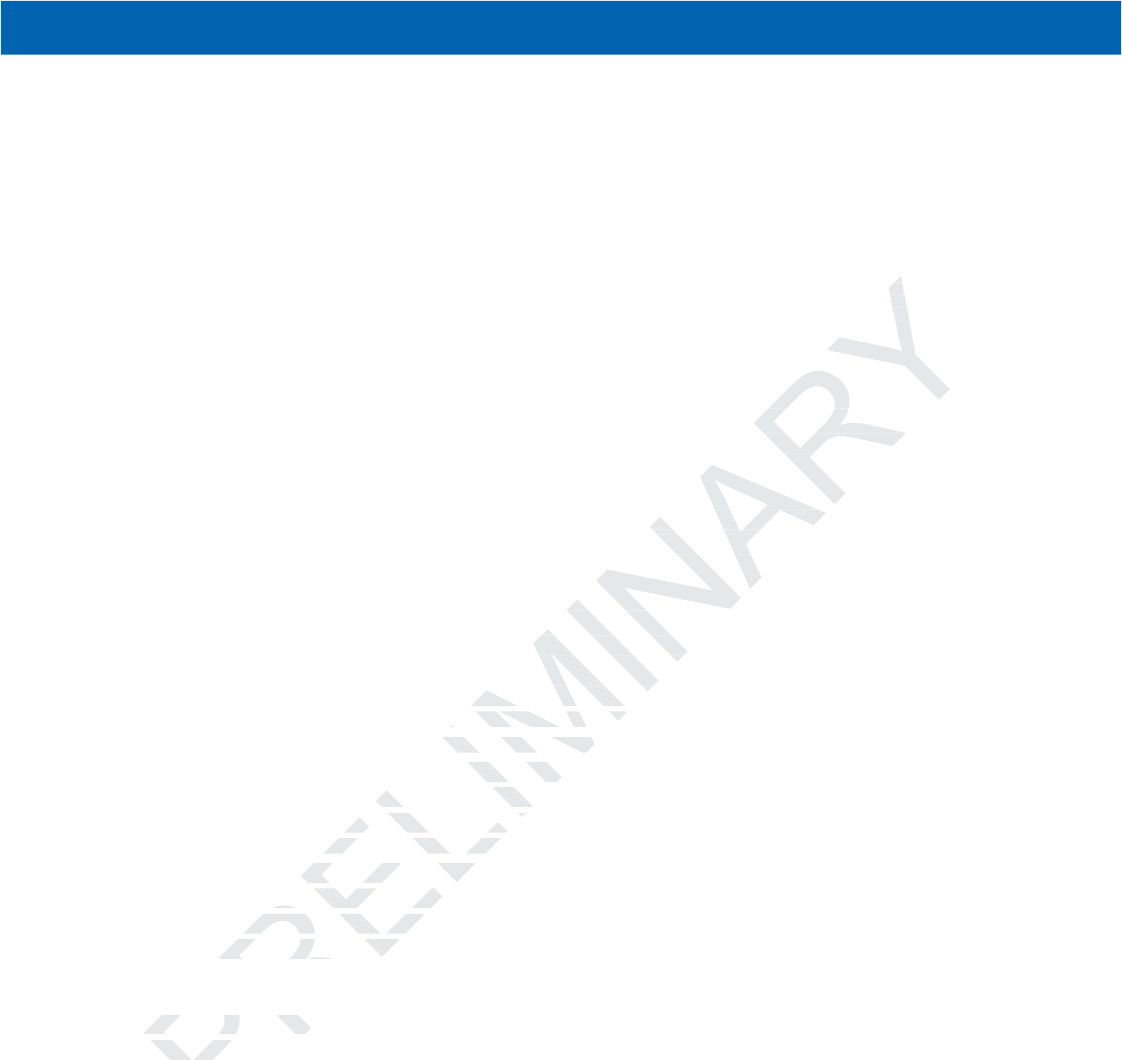
viii MC21XX Series User Guide
LED Charge Indications ........................................................................................................... 6-12
Holster ........................................................................................................................................... 6-13
Handstrap ...................................................................................................................................... 6-14
Installation ................................................................................................................................ 6-14
Removal ................................................................................................................................... 6-15
Lanyard .......................................................................................................................................... 6-16
Installation ................................................................................................................................ 6-16
Removal ................................................................................................................................... 6-16
Tether Installation .......................................................................................................................... 6-17
Chapter 7: Maintenance & Troubleshooting
Introduction .................................................................................................................................... 7-1
Maintaining the MC21XX ............................................................................................................... 7-1
Battery Safety Guidelines .............................................................................................................. 7-2
Cleaning ......................................................................................................................................... 7-3
Approved Cleanser Active Ingredients ..................................................................................... 7-3
Harmful Ingredients .................................................................................................................. 7-3
Cleaning Instructions ............................................................................................................... 7-3
Special Cleaning Notes ............................................................................................................ 7-3
Materials Required ................................................................................................................... 7-3
Cleaning the MC21XX ............................................................................................................. 7-4
Housing .............................................................................................................................. 7-4
Display ............................................................................................................................... 7-4
Scanner Exit Window ......................................................................................................... 7-4
Connector .......................................................................................................................... 7-4
Cleaning Cradle Connectors .................................................................................................... 7-4
Cleaning Frequency ................................................................................................................. 7-5
Troubleshooting ............................................................................................................................. 7-6
MC21XX ................................................................................................................................... 7-6
Single-slot USB Cradle ............................................................................................................ 7-8
Four-slot Charge Only Cradle .................................................................................................. 7-8
Four-slot Spare Battery Charger .............................................................................................. 7-9
USB ActiveSync/Charge Cable ................................................................................................ 7-9
Appendix A: Specifications
MC21XX and Accessory Technical Specifications ........................................................................ A-1
Appendix B: Keypad
Introduction .................................................................................................................................... B-1
27-Key Keypad ........................................................................................................................ B-1
Glossary
Index
.....
...
...
.................
...
....................
....................
..........
...............................
........................
...............................
.......................
...............................
........................
...............................
..............................
...............................
.................
...............................
............................
..............................................................
....................................................
...............................
...........................
...............................
.......................
RELIM
...............................
...............................
..............................
..............................
........................................................
...............................
................
...............................
..............................
...............................
...............................
..............................
..............................
adle ........................dle ........................
PRE
Only Cradle ..........Only Cradle ........
e Battery Charger .e Battery Charger .
Sync/Charge Cable
Sync/Charge Cable
A: SpecificationsA: Specifications
P
X and AccessoryX and Acc

ABOUT THIS GUIDE
Introduction
This guide provides information about using the MC21XX mobile computers and accessories.
Documentation Set
The documentation set for the MC21XX is divided into guides that provide information for specific user needs.
•
MC21XX Series Quick Start Guide - describes how to use the MC21XX.
•
MC21XX Series Mobile Computer User Guide - describes how to use the MC21XX.
•
MC21XX Series Mobile Computer Integrator Guide - describes how to set up the MC21XX and the
accessories.
•
Microsoft Applications for Windows Mobile 6.1 and CE 6.0 User Guide - describes how to use Microsoft
developed applications.
•
Application Guide for Motorola Enterprise Mobility Devices - describes how to use Motorola Enterprise
Mobility developed applications.
•
EMDK Help File - provides API information for writing applications.
NOTE Screens and windows pictured in this guide are samples and may differ from actual screens.
MINAR
ARY
AR
1XX mobile computer
1XX mobile compute
PRELIMI
C21XX is divided intodivided into
k Start Guidek Start G
- descrescr
Mobile Computer Use
Mobile Computer Us
es Mobile ComputerMobile Comput
s.
s.
soft Applications foroft Applications for
eloped applications.
loped applications.
Application Guide foApplication Guid
Mobility developed
Mobility developed
MDK Help FMDK
d in this guide are samphis guide are samp
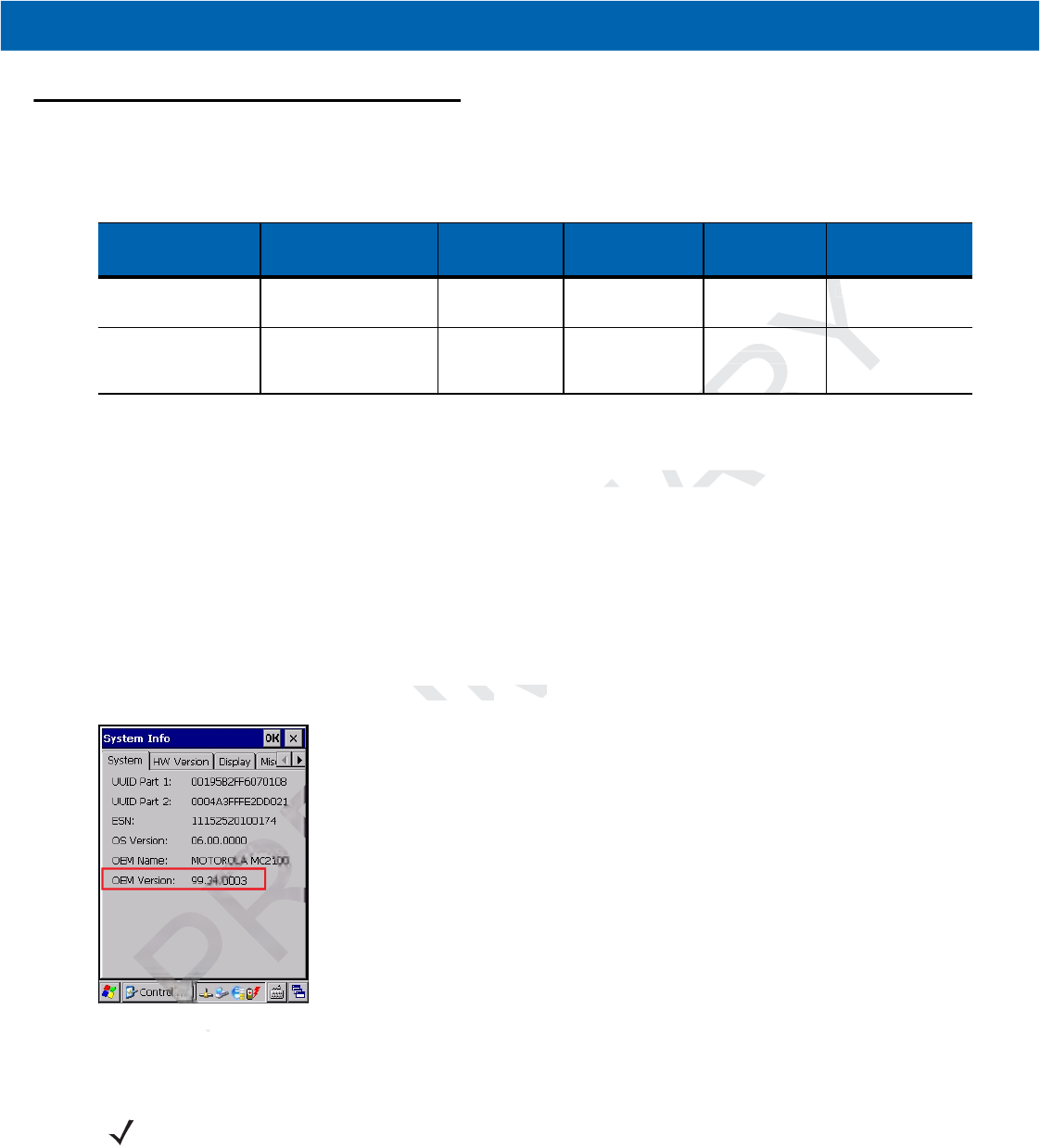
ii MC21XX Series User Guide
Configurations
This guide covers the following configurations:
Software Versions
This guide covers various software configurations and references are made to operating system or software
versions for:
•
OEM version
•
Fusion version.
OEM Version
To determine the OEM software version:
Tap Start > Settings > Control Panel > System Info icon > System tab.
Fusion Software
To determine the Fusion software version:
Tap Wireless Strength icon > Wireless Status > Versions.
Configuration Radios Display Memory Data
Capture
Operating
System
MC2100 None Color, no touch 128 MB RAM/
256 MB Flash
Linear imager
or 1D laser
Windows CE 6.0
MC2180 WLAN: 802.11 b/g/n
WPAN: Bluetooth
Color touch
screen
128 MB RAM/
256 MB Flash
Linear imager,
1D laser or 2D
imager
Windows CE 6.0
NOTE MC2180 only.
Y
Y
ger
er
e
Windo
W
ear imager,
ear im
D laser or 2D
D laser or
imager
imag
Windows
Wind
R
RY
Y
RY
RELIMINARY
es are made to operat
es are made to opera
>
System Info
ystem Info
icon >
on >
S
P
RY
R
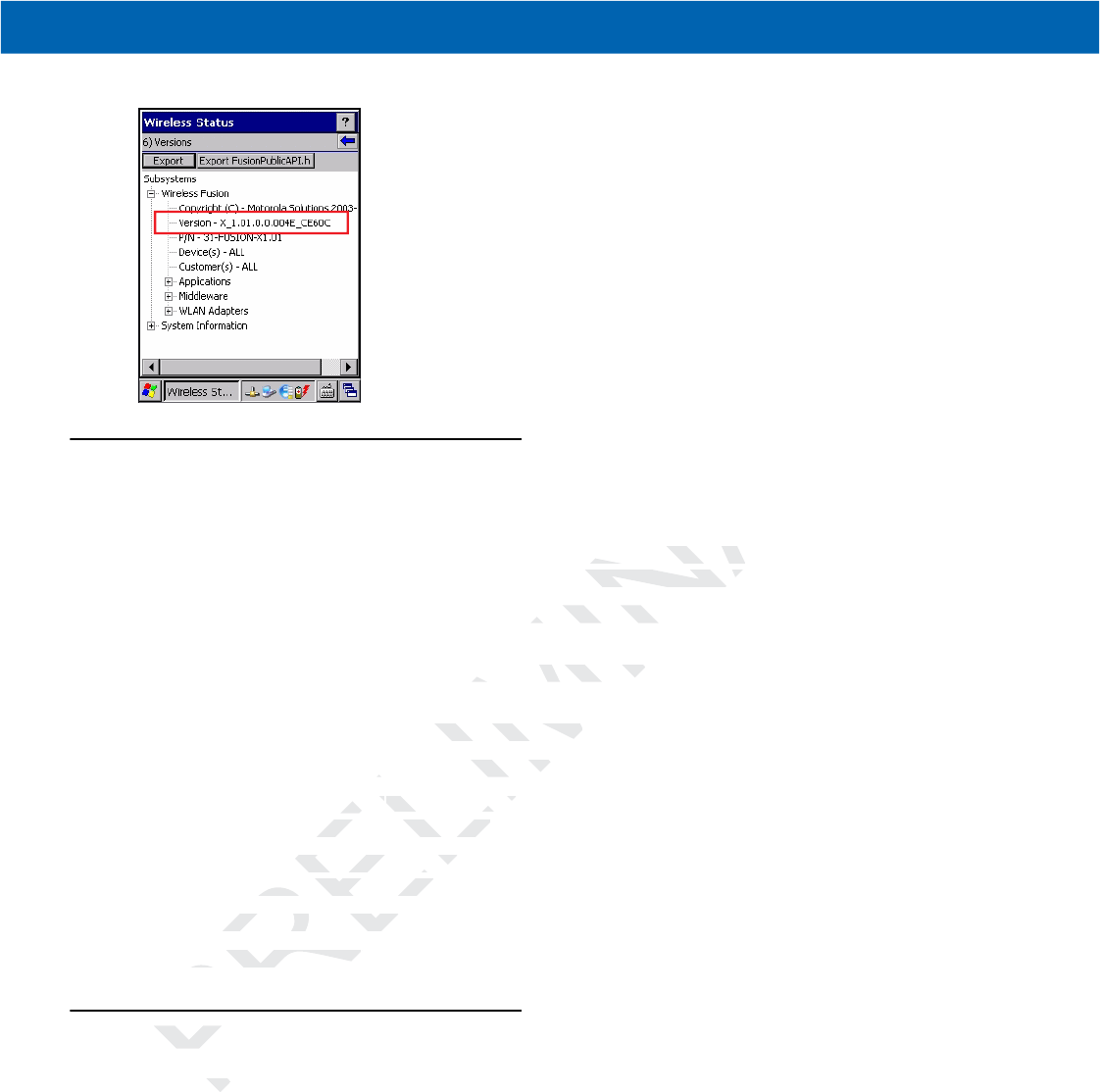
About This Guide iii
Chapter Descriptions
Topics covered in this guide are as follows:
•
Chapter 1, Getting Started, describes the MC21XX’s physical characteristics, how to install and charge
the batteries, remove and replace the handstrap and how to start the MC21XX for the first time.
•
Chapter 2, Operation, provides basic instructions for using the MC21XX and navigating the MC21XX
software.
•
Chapter 3, Data Capture provides instructions for using the MC21XX to capture data using the linear, 1D
laser or 2D imager.
•
Chapter 4, Bluetooth, explains how to perform Bluetooth functionality on the MC21XX
•
Chapter 5, Wireless Applications, explains how to use the Wireless applications on the MC21XX.
•
Chapter 6, Accessories, describes the accessories available for the MC21XX and how to use the
accessories to charge the MC21XX.
•
Chapter 7, Maintenance & Troubleshooting, includes instructions on cleaning and storing the MC21XX,
and provides troubleshooting solutions for potential problems during MC21XX operation.
•
Appendix A, Specifications, includes a table listing the technical specifications for the MC21XX.
•
Appendix B, Keypad, contains keypad descriptions and special character generation tables.
Notational Conventions
The following conventions are used in this document:
•
The term “mobile computer” refers to the Motorola MC21XX.
•
Italics are used to highlight the following:
•Chapters and sections in this and related documents
•Dialog box, window and screen names
•Drop-down list and list box names
•Check box and radio button names
•Icons on a screen.
PRELIMINARY
XX’s physical charact
XX’s physical char
rap and how to start t
p and how to start t
tructions for using the
tructions for usin
instructions for using
instructions for using
ains how to perform B
s how to perform B
pplicationsp
, explains hexplains h
sories
sories
, describes the a
, describes the a
charge the MC21XX.
charge the MC21XX.
Maintenance & TroubMaintenance & Troub
vides troubleshooting vides troubleshooting
endix A, Specificationendix A, Specification
Appendix B, Keypad
Appendix B, Keypad
PR
PR
onal Convenonal C
owinowi
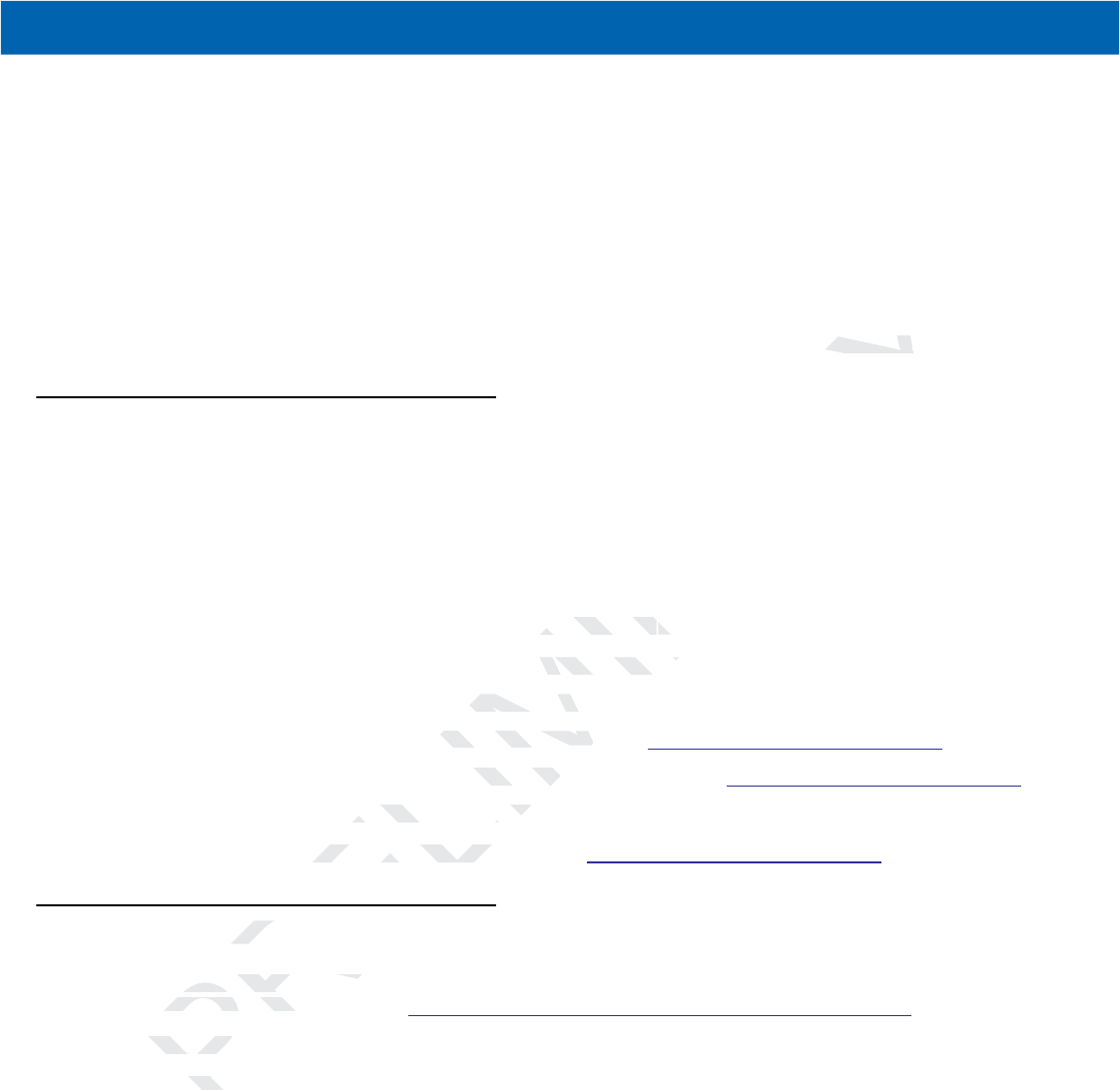
iv MC21XX Series User Guide
•
Bold text is used to highlight the following:
•Key names on a keypad
•Button names on a screen.
•
Bullets (•) indicate:
•Action items
•Lists of alternatives
•Lists of required steps that are not necessarily sequential.
•
Sequential lists (e.g., those that describe step-by-step procedures) appear as numbered lists.
Related Documents and Software
The following items provide more information about the MC21XX.
•
MC21XX Quick Start Guide, p/n 72-155017-xx
•
MC21XX Regulatory Guide, p/n 72-155018-xx
•
MC21XX Integrator Guide, p/n 72E-155021-xx
•
Application Guide for Motorola Enterprise Mobility Devices, p/n 72E-68901-xx
•
Microsoft®Applications for Mobile 6.1 and CE 6.0 User Guide, p/n 72E-108299-xx
•
Enterprise Mobility Developer Kit (EMDK) Help File
•
Windows CE Platform SDK for MC2100c50, available at: http://supportcentral.motorola.com
•
Enterprise Mobility Developer Kit for C (EMDK for C), available at: http://supportcentral.motorola.com
•
ActiveSync software, available at: http://www.microsoft.com.
For the latest version of this guide and all guides, go to: http://supportcentral.motorola.com
Service Information
If you have a problem with your equipment, contact Motorola Enterprise Mobility support for your region.
Contact information is available at: http://www.motorola.com/enterprisemobility/contactsupport.
When contacting Enterprise Mobility support, please have the following information available:
•
Serial number of the unit
•
Model number or product name
•
Software type and version number
Motorola responds to calls by email, telephone or fax within the time limits set forth in support agreements.
If your problem cannot be solved by Motorola Enterprise Mobility Support, you may need to return your
equipment for servicing and will be given specific directions. Motorola is not responsible for any damages
incurred during shipment if the approved shipping container is not used. Shipping the units improperly can
possibly void the warranty.
If you purchased your Enterprise Mobility business product from a Motorola business partner, contact that
business partner for support.
PRELIMINARY
numbered lists.
numbered
obility Devices
obility Devices
, p/n 72
, p
nd CE 6.0 User GuideE 6.0 User Guide
EMDK) Help File
MDK) Help File
MC2100c50,
MC2100c50,
availabl
availab
per Kit for C (EMDK foC (EMDK f
vailable at:
vailable
http://www
/www
this guide and all guidthis guide and all guid
RE
ationation
ve a problem with youve a problem with you
PR
ct information is availct information is
n contacting Entern contacting Enter
P
ial numbial nu
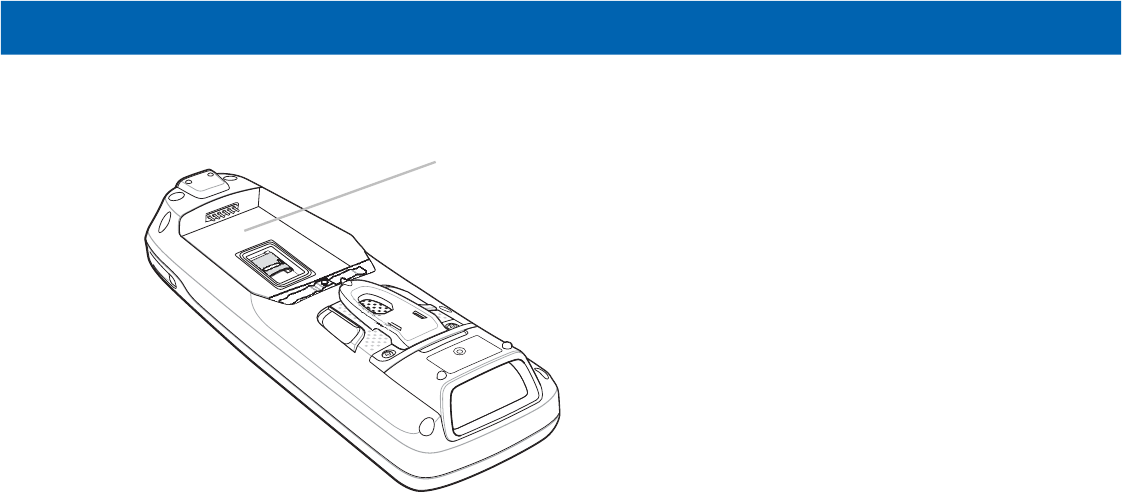
About This Guide v
Manufacturing Label Location
PRELIMINARY

vi MC21XX Series User Guide
PRELIMINARY

CHAPTER 1 GETTING STARTED
Introduction
This chapter describes the MC21XX physical characteristics, how to install and charge the battery, and how to
start the mobile computer for the first time.
Unpacking the Mobile Computer
Carefully remove all protective material from around the mobile computer and save the shipping container for
later storage and shipping. Verify that the equipment listed below is included:
•
Mobile computer
•
Mini stylus (touch screen configurations only)
•
Battery
•
Power supply
•
Regulatory Guide
•
Quick Start Guide.
Inspect the equipment for damage. If any equipment is missing or damaged, contact the Motorola Enterprise
Mobility Support immediately. See Service Information on page xvi for contact information.
NOTE AC line cord has to be ordered separately.
PRELIMINAR
ARY
AR
D
racteristics, how to in
racteristics, how to in
M
ter
ter
material from around rial from around
Verify that the equipmVerify that the equipm
ouch screen configuraouch screen configura
er supplyer supply
Regulatory Guidegulatory Guide
•
•
Quick Start Guide
Quick Start G
NOTEN
AC
P
P
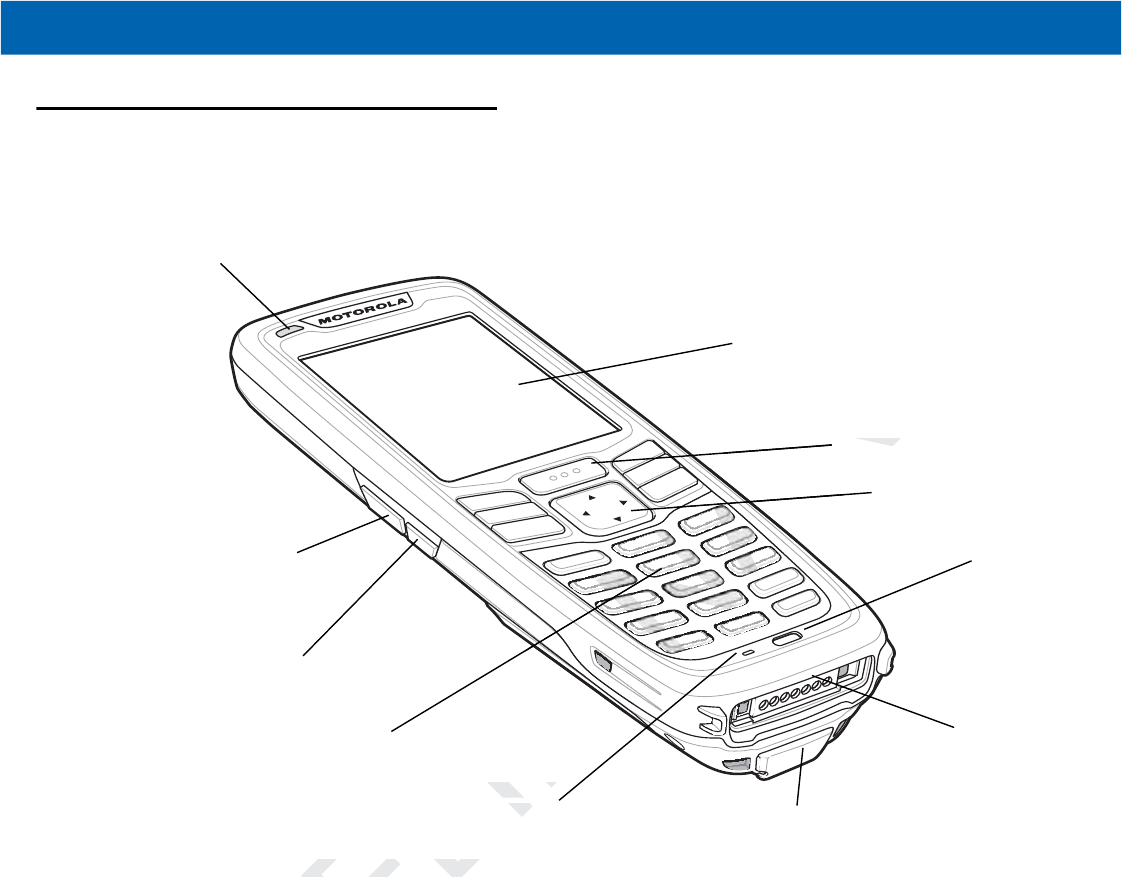
1 - 2 MC21XX Series User Guide
Features
The features of the MC21XX mobile computer are shown in Figure 1-1 and Figure 1-2.
Figure 1-1
MC21XX Mobile Computer (Front View)
Keypad
Display
Power
Scan Buttons
Microphone
MC2180 only
LED Indicator
I/O
Connector
Power Input Port
Volume Down Button
(Default) Programmable
MC2180 only
Volume Up Button
(Default) Programmable
MC2180 only
Navigation Pad
ARY
A
A
A
A
A
A
A
A
AR
Scan But
an But
PRELIMINAR
Mobile Computer (Fron
obile Computer (Fron
MINAR
MINAR
MINAR
MINAR
MINAR
MIN
M
MIN
MIN
MI
MI
M
M
MIN
MINAR
MIN
A
A
A
A
A
A
A
A
MIN
Microphone
crophone
MC2180 o80 o
AR
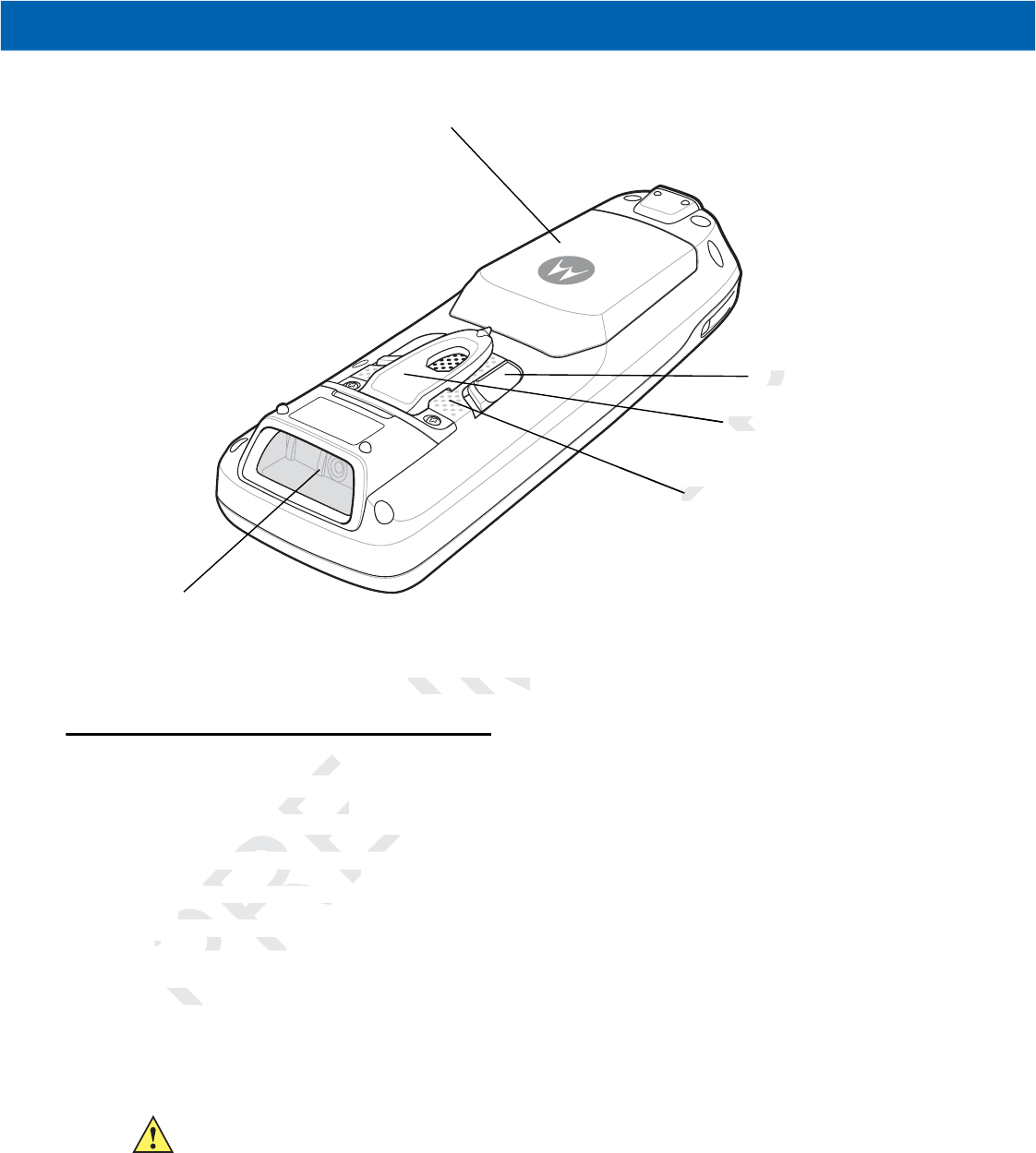
Getting Started 1 - 3
Figure 1-2
MC21XX Mobile Computer (Back View)
Mobile Computer Startup
To start using the MC21XX:
•
Install the microSD card (optional).
•
Install the main battery.
•
Charge the main battery and the backup battery.
•
Start the MC21XX.
Install microSD Card
The Secure Device (SD) card provides secondary non-volatile storage (the flash memory is slower than RAM).
The SD card holder is located under the battery.
Exit Window
Mini Stylus
Battery
Speaker
Battery Release Latch
CAUTION Follow proper Electro-Static Discharge (ESD) precautions to avoid damaging the microSD card.
Proper ESD precautions include, but are not limited to, working on an ESD mat and ensuring that the
operator is properly grounded.
Do not use the microSD card slot for any other accessories.
PRELIMINARY
puter (Back View)
uter (Back View)
LI
rtup
rtup
MC21XX:
MC21XX:
he microSD card (opt
he microSD card (opt
tall the main battery.tall the main battery.
Charge the main baCharge the main ba
••
Start the MC21Xrt the MC2
microSDmic
AR
Mini Stylus
Mini
Speaker
Spe
NA
R
Battery Release
atte
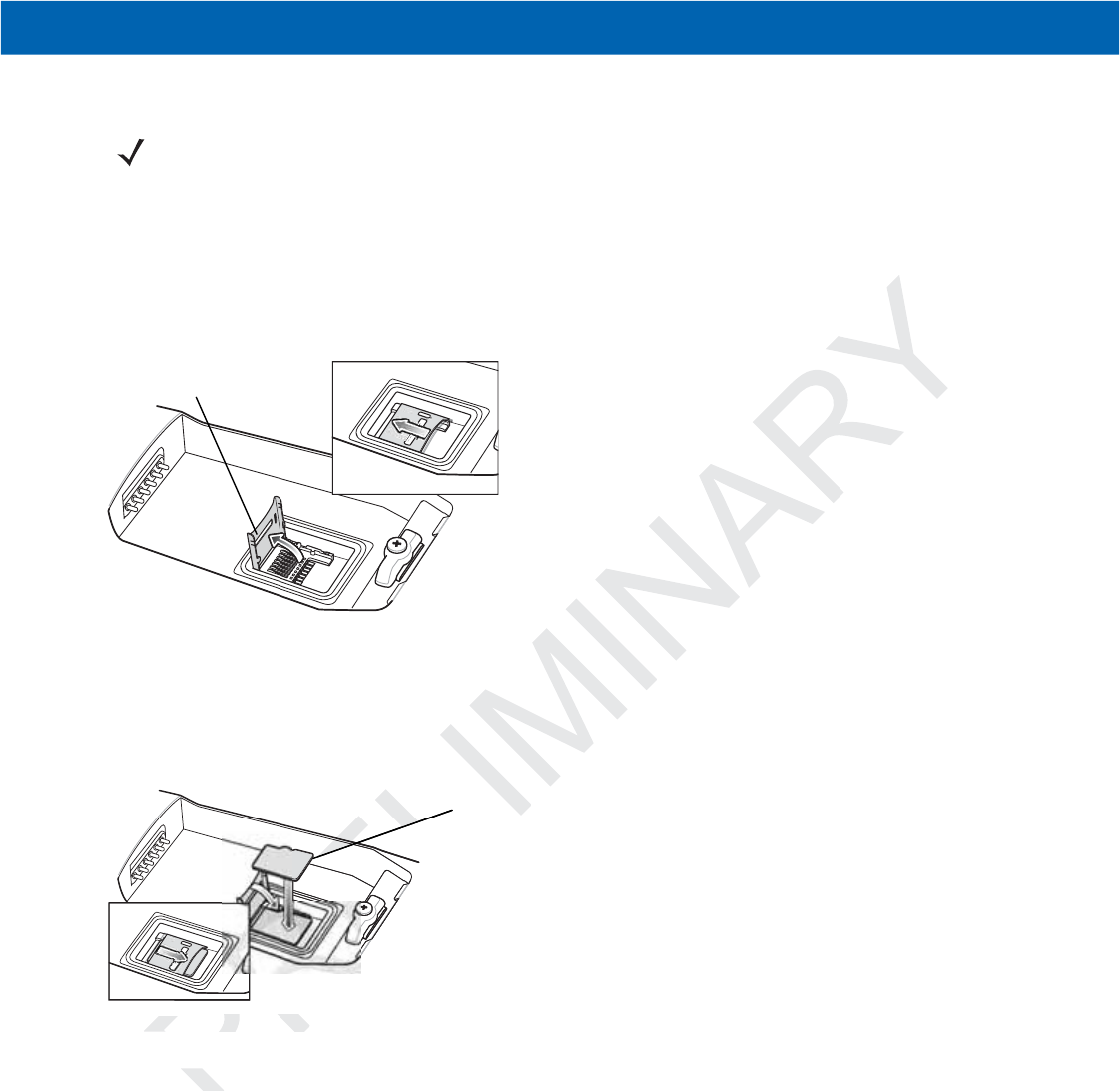
1 - 4 MC21XX Series User Guide
To insert the microSD card:
1. Place the MC21XX face-down on surface.
2. Slide the card holder door down to unlock.
3. Lift the microSD card holder door.
Figure 1-3
Inserting the microSD Card
4. Position the microSD card, with the contacts facing down, into the microSD holder.
5. Close microSD card door.
6. Slide the card holder up to lock.
Figure 1-4
Inserting the microSD Card
Install Main Battery
If the main battery is charged, the MC21XX can be used immediately. If the main battery is not charged, see
Battery Charging on page 1-5. To remove the main battery, see Main Battery Removal on page 1-8.
Insert the battery into the slot, bottom first and press the battery gently into the slot. The battery latches lock
the battery into place.
NOTE Select microSD cards with environmental and/or the write cycle performance specifications that meet or
exceed the application requirements.
microSD Card
microSD Card
tacts facing down, into
tacts facing down, int
k.
E
E
PRELI
re 1-4re 1-4
Inserting the mserting the
ain Batteain B
REL
EL
RE
E
REL
R
R
R
E
E
E
RE
RE
RE
RE
R
R
E
E
E
E
E
RE
E
E
RE
E
RE
R
RE
E
E
RE
R
RE
RE
RE
RE
RE
E
RE
RE
RE
RE
RE
RE
RE
RE
PR
PR
PR
PR
PR
P
PR
PR
PR
PR
PR
PR
ELI
microSD C
DC
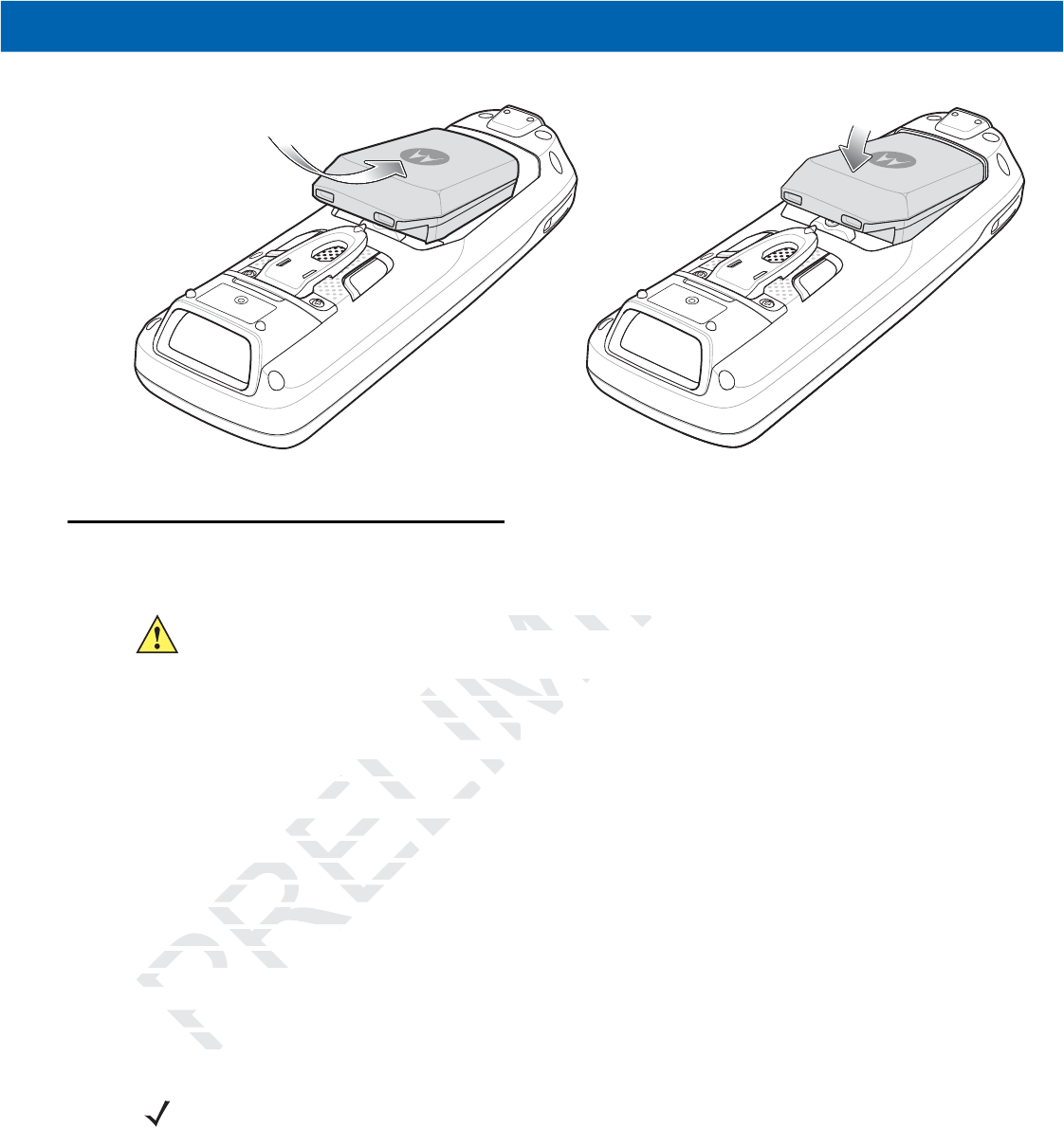
Getting Started 1 - 5
Figure 1-5
Insert Battery
Battery Charging
The main battery can be charged before insertion into the MC21XX or after it is installed. Use the Four-slot
Battery Charger to charge the main battery (out of the MC21XX) or the supplied power supply to charge the
main battery while it is installed in the MC21XX.
Before using the MC21XX for the first time, fully charge the main battery until the LED Indicator remains lit (see
Table 1-1 on page 1-6 for charge status indications). The battery fully charges in less than four hours.
The MC21XX is equipped with a memory backup battery which automatically charges from the main battery
whether or not the MC21XX is operating or is in suspend mode. The memory backup battery retains data in
memory for at least 30 minutes when the MC21XX’s main battery is removed or fully discharged. When the
MC21XX is used for the first time or after the memory backup battery has fully discharged, the memory backup
battery requires approximately 15 hours to fully charge. Do not remove the main battery from the MC21XX for
15 hours to ensure that the memory backup battery fully charges. If the main battery is removed from the
MC21XX or the main battery is fully discharged, the memory backup battery completely discharges in several
hours.
When the main battery reaches a very low battery state, the combination of main battery and backup battery
retains data in memory for at least 72 hours.
Batteries must be charged within the 0° to +40° C (32° to 104° F) ambient temperature range.
To charge the MC21XX using the supplied power supply:
CAUTION Ensure that you follow the guidelines for battery safety described in Battery Safety Guidelines on page
7-2.
NOTE Do not remove the main battery within the first 15 hours of use. If the main battery is removed before the
backup battery is fully charged, data may be lost.
MINARY
ARY
ARY
ARY
ARY
ARY
RY
RY
R
PRELIMI
efore insertion into thefore insertion into th
ain battery (out of the battery (out of the
ed in the MC21XX.
MC21XX.
X for the first time, fully
X for the first time, full
for charge status ind
for charge status ind
quipped with a memoquipped with a memo
the MC21XX is opera
MC21XX is oper
at least 30 minutes wh
at least 30 minutes wh
is used for the first timis used for the first tim
requires approximateequires approximate
ours to ensure that thours to ensure that th
MC21XX or the main bMC21XX or the ma
hours.hou
en the main en the
data i data
RY
R
uidelines for battery safe
elines for battery saf
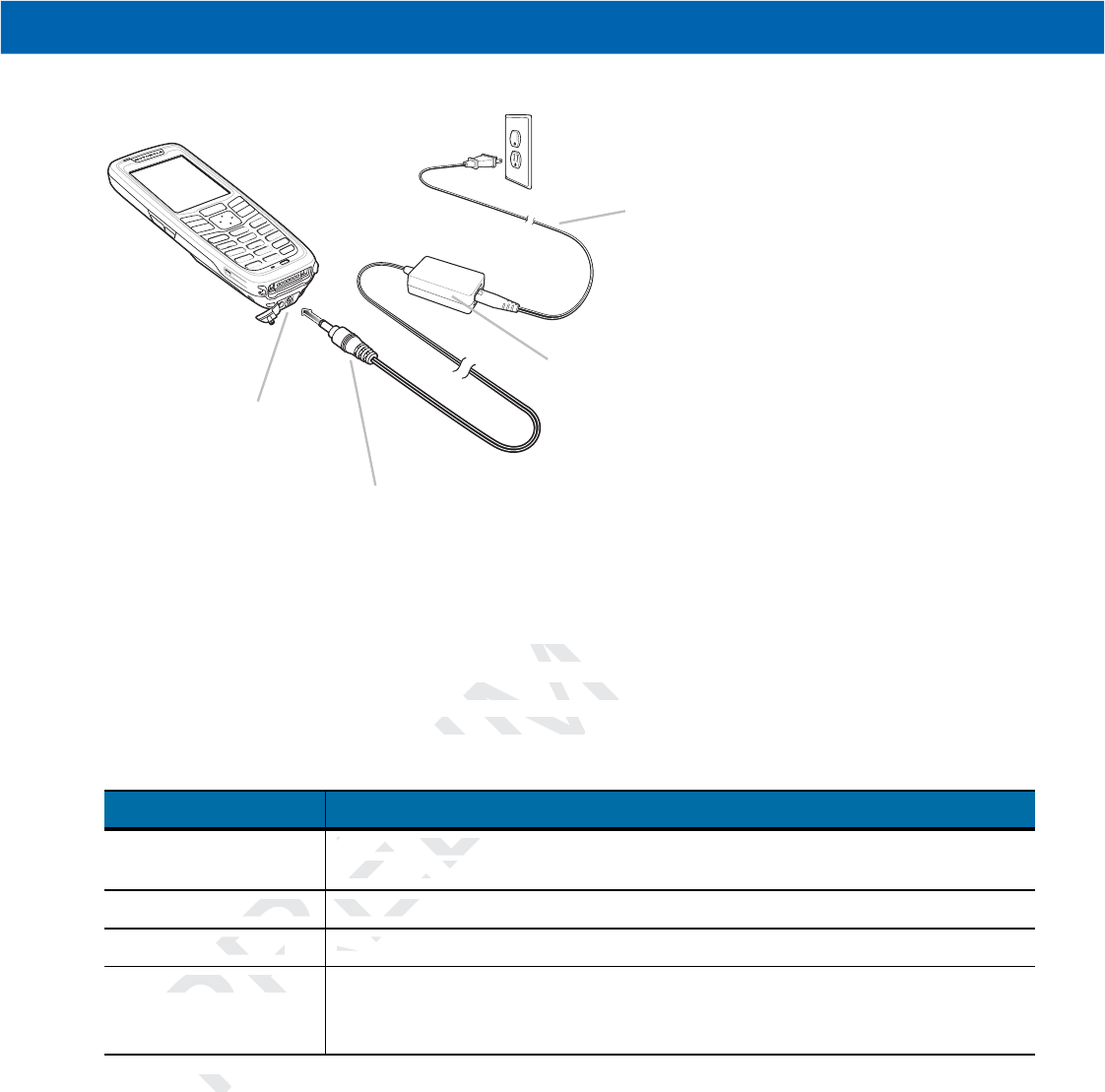
1 - 6 MC21XX Series User Guide
Figure 1-6
Charging Using Power Supply
1. Connect the AC Line Cord to the power supply.
2. Connect the AC plug to an AC outlet.
3. Lift the rubber plug covering the MC21XX power port.
4. Plug the power supply barrel jack into the power port on the bottom of the MC21XX.
The MC21XX starts to charge. The LED Indicator indicates the charging status.
The following accessories can also be used to charge the battery:
•
Cradle (and a power supply):
•Single-slot USB Cradle.
•
Cables (and a power supply):
•USB ActiveSync/Charge Cable.
•
Chargers (and a power supply):
•Four-slot Spare Battery Charger.
See Chapter 6, Accessories for charging instructions using the accessories.
Table 1-1
LED Indicators
LED Indication
Off
MC21XX
not placed correctly in the cradle; charge cable not connected correctly or
charger is not powered.
Fast Blinking Amber Error in charging. Check placement of the
MC21XX
.
Slow Blinking Amber
MC21XX
is charging.
Solid Amber Charging complete.
Note: When the battery is initially inserted in the
MC21XX
, the LED flashes once if
the battery power is low or the battery is not fully inserted.
Power Supply
Power Port
Barrel Jack
AC Line Cord
LIMINARY
power port.
wer port
the power port on the
the power port on t
e LED Indicator indica LED Indicator ind
ELI
REL
MC21XXMC21X
not placnot plac
charger is not pharger is not p
RE
RE
LI
EL
RE
Error in ch
Error in ch
RE
mber
mber
RE
RE
MC21MC21
PRE
ng Amberg Amber
RE
RE
RE
R
C
PR
AmberAmber
R
PR
P
ng accng a
P
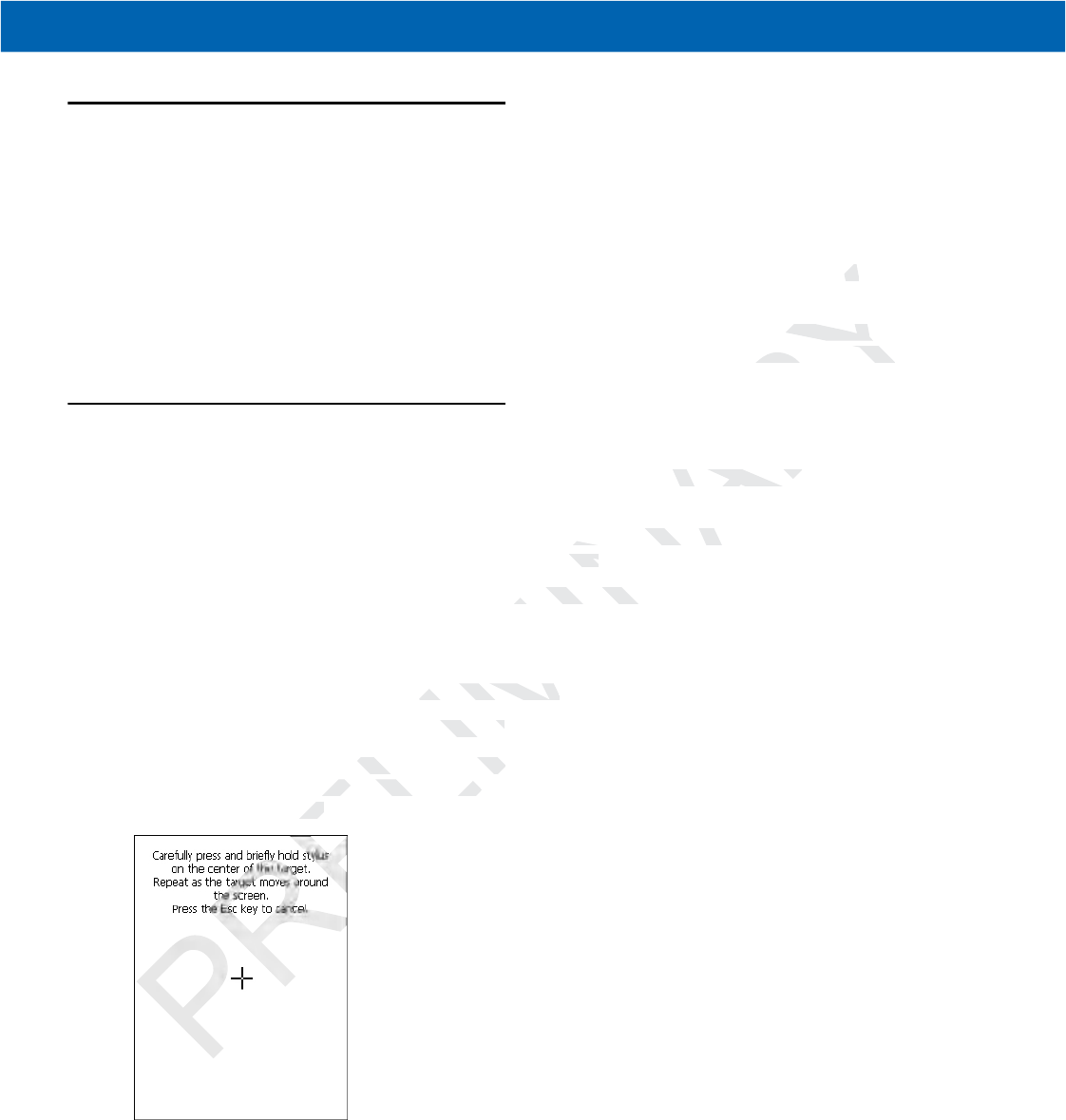
Getting Started 1 - 7
Spare Battery Charging
To charge a spare battery:
1. Connect the Four-slot Battery Charger to the appropriate power source. See Chapter 6, Accessories for
setup instructions.
2. Insert the spare battery, bottom first, into the spare battery charging slot and gently press down on the
battery to ensure proper contact.
The battery starts to charge automatically. The LED Indicator blinks amber to indicate the battery is charging.
See Chapter 6, Accessories for charging indications. The battery usually fully charges in less than four hours.
Starting the MC21XX
Press the Power button to turn on the MC21XX. If the MC21XX does not power on, perform a cold boot. See
Resetting the MC21XX on page 2-12.
When the MC21XX is powered on for the first time, it initializes. The Splash screen appears for a short period
of time. On the MC2180 the Calibration screen appears.
If the MC21XX does not power on, see Resetting the MC21XX on page 2-12.
Calibration Screen
Use the Calibration screen to align the touch screen:
1. Remove the stylus from the stylus holder.
2. Carefully press and briefly hold the stylus tip on the center of the Calibration screen target. Repeat the
procedure as the target moves and stops at different locations on the screen. This enters the new
calibration settings.
Figure 1-7
Calibration Screen
3. Once all of the new calibration settings are input, tap the screen or press the ENTER button to save the
new calibration settings. Press ESC to discard the new calibration settings.
RELIMINARY
y pres
pr
ndicate the battery is
dicate the b
y charges in less than
y charges in less
XX does not power on
oes not power on
nitializes. The
nitializes. The
Splash
Spla
pears.
ars.
ing the MC21XX on p
ing the MC21XX
the touch screen:
the touch screen:
he stylus holder.
s holder.
riefly hold the stylus tefly hold the stylus
arget moves and stop
arget moves and sto
ngs.
ngs.
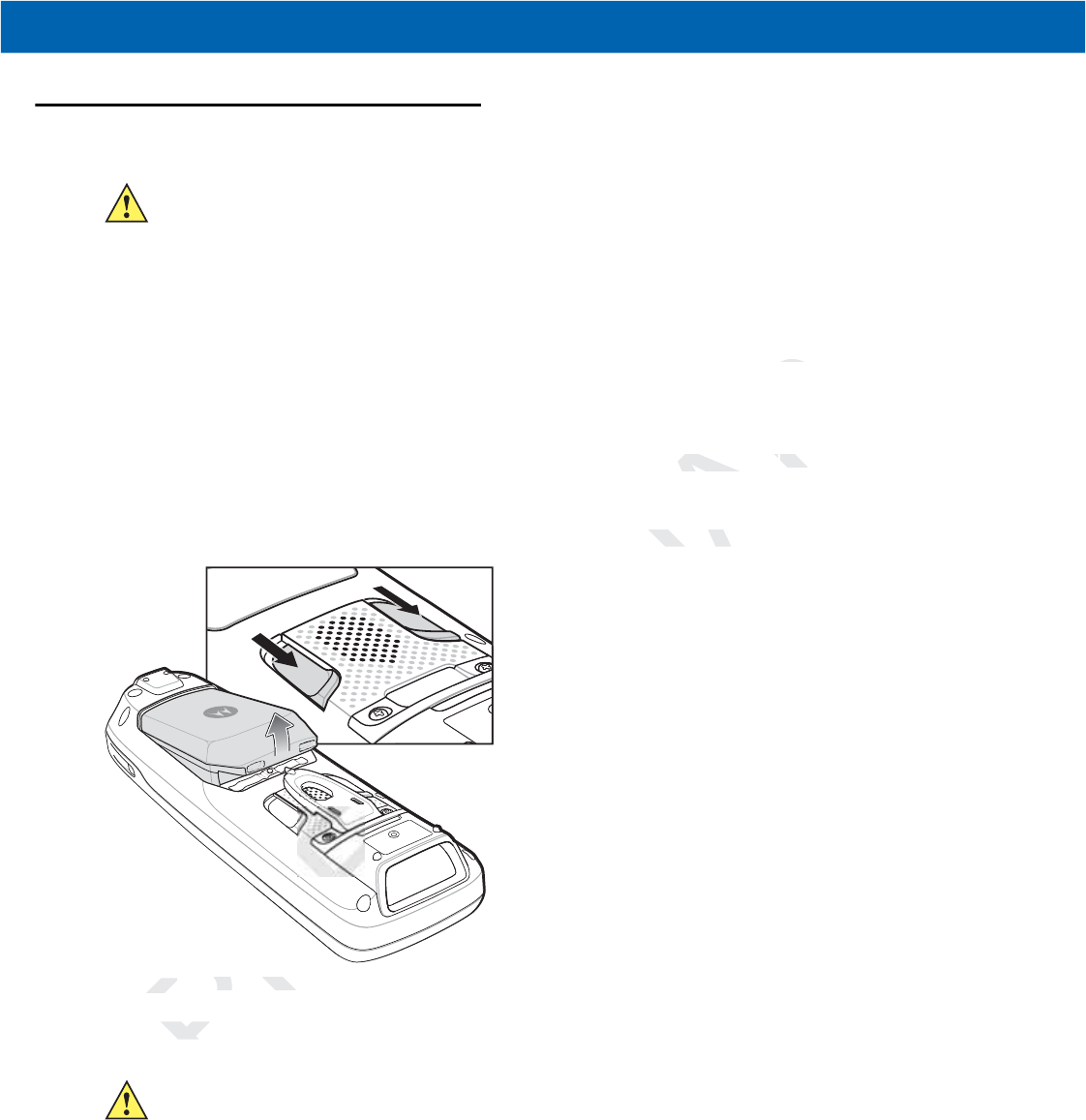
1 - 8 MC21XX Series User Guide
Main Battery Removal
To remove the main battery from an MC21XX:
1. If the MC21XX is in suspend mode, press the Power button to wake the MC21XX.
2. Press the Power button to place the MC21XX in suspend mode.
3. On the MC2180, tap Safe Battery Swap.
On the MC2100, using the navigation pad, scroll down to Safe Battery Swap. Press the Enter key.
4. Wait for the LED Indicator to turn red and then turn off.
5. Using thumbs, push the two battery latches up. The battery ejects slightly.
Figure 1-8
Release Latches
6. Remove the battery from the MC21XX.
CAUTION When removing the battery, follow the Safe Battery Swap procedures below otherwise loss of data or
system corruption may occur.
When in Safe Battery Swap mode, the MC21XX goes into a low power suspend state. All wakeup are
disabled.
CAUTION Replace the new battery within five minutes to prevent loss of data.
PRELIMINARY
1XX.
Battery Swap
attery Swap
. Press
. Pr
ttery ejects slightly.
ects slight
e 1-8
e 1-8
Release Latche
elease Latc
move the batt
move
LIM
IM
IM
IM
LIM
LIM
M
M
M
M
M
M
M
M
M
M
IM
LIM
ELI
PRELI
PRELI
PRE
PRE
RE
RE
RE
REL
EL
EL
EL
EL
EL
EL
EL
EL
L
EL
L
EL
L
E
L
EL
L
L
EL
EL
E
L
EL
EL
EL
EL
EL
EL
EL
EL
EL
EL
EL
EL
EL
EL
EL
EL
EL
E
E
E
E
E
RE
RE
L
E
EL
EL
EL
EL
EL
EL
EL
EL
EL
EL
EL
EL
E
E
EL
E
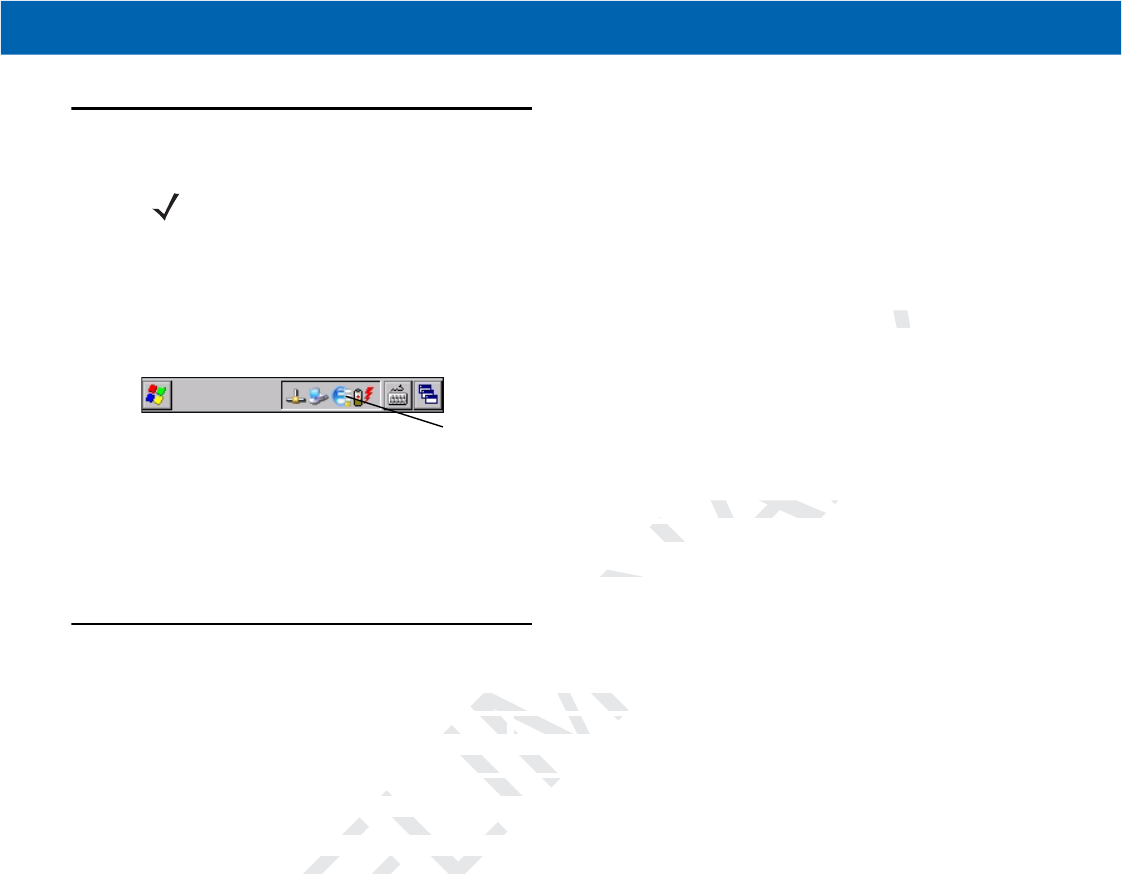
Getting Started 1 - 9
Turning Off the Radios
WLAN Radio
To turn off the WLAN radio tap the Fusion Signal Strength icon on the task tray and select Disable Radio. An
X appears in the icon indicating that the radio is disabled (off).
Figure 1-9
Fusion Signal Strength Icon
To turn the radio back on, tap the Fusion Signal Strength icon on the task tray and select Enable Radio. The
X disappears from the icon indicating that the radio is enabled (on).
See Chapter 5, Wireless Applications for more information.
Safe System Shutdown/Re-boot
To ensure that data is not lost or that system corruption occurs, the user must follow the Safe Battery Swap
procedure when replacing the battery. See Main Battery Removal on page 1-8.
If the MC21XX stops responding first perform a warm boot. A warm boot maintains radio status and registry
settings. Do not perform a cold boot unless necessary.
Performing a cold boot resets the MC21XX to factory defaults and loss of all registry settings.
To perform a warm boot, press and hold the Power button for five seconds.
NOTE MC2180 only.
Fusion Signal Strength Icon
LIMINARY
d select
ect
Dis
con on the task tray an
con on the task tray an
abled (on).led (
ation.ation.
system corruption occsystem corruption o
ery. See ery. See
ELIM
Main Battery Main Battery
ng first perform a war
perform a w
old boot unless neces
old boot unless neces
resets the MC21XX tresets the MC21XX t
PREL
m boot, press and holdm boot, press and hold

1 - 10 MC21XX Series User Guide
PRELIMINARY

CHAPTER 2 OPERATION
Introduction
This chapter provides basic instructions for using the MC21XX and navigating the operating system software.
Power Button
Press the Power button to toggle the MC21XX between suspend and resume. When the screen is off the
MC21XX is in suspend mode and when the screen is on the MC21XX is on.
Windows CE Sample Applications Window
The MC21XX contains a set of sample applications that can be installed. By default an installation icon is on
the Desktop. Double-tap the icon to install the sample applications. When installed, the Sample Applications
window appears on the screen whenever the MC21XX re-boots. Refer to the MC21XX Series Mobile
Computer Integrator Guide for installation and configuration.
The Sample Applications window links to sample applications. The sample applications are intended to be
used by application developers as application development examples. These applications were not developed
to support end users. Refer to the Application Guide for Motorola Enterprise Mobility Devices for the sample
applications.
PRELIMINAR
ARY
AR
the MC21XX and nav
the MC21XX and na
M
the MC21XX between
he MC21XX betwe
nd when the screen ishen the screen is
LI
e Applications We Applications
ontains a set of sampains a set of samp
Double-tap the icon tDouble-tap the icon t
ppears on the screen wppears on the screen w
ter Integrator Guideer Integrator Guide
fofo
PR
ee
Sample ApplicatioSample App
used by application de
used by application
to support end useto support end use
plications.plicatio
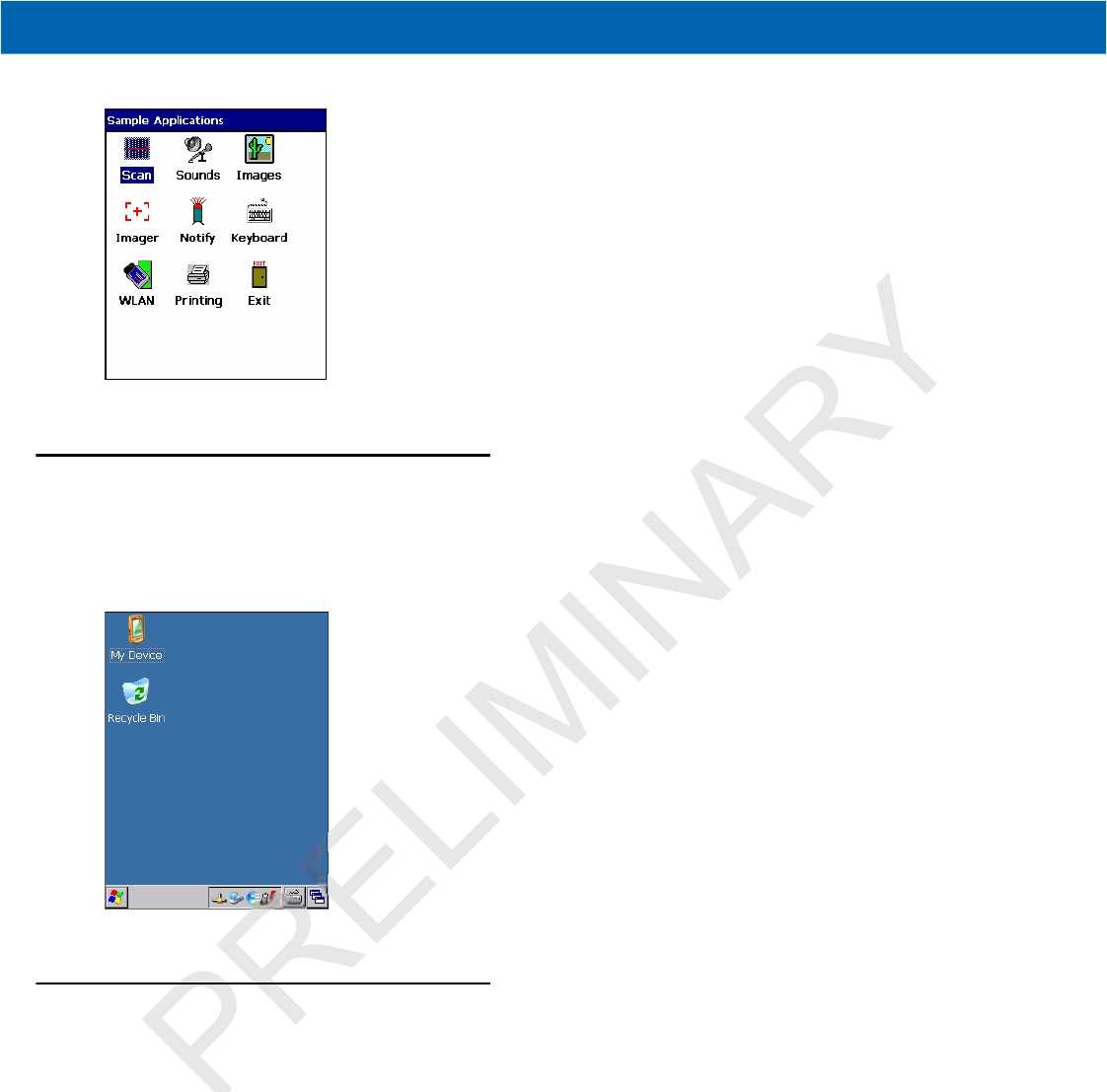
2 - 2 MC21XX Series User Guide
Figure 2-1
Sample Applications Window
Windows CE Desktop
The desktop displays the applications available with the Windows CE configurations. For information on using
the Microsoft® applications refer to the Microsoft®Applications for Mobile and CE 6.0 User Guide, p/n
72E-78456-xx.
Figure 2-2
Windows CE Desktop
Using the Keypad to Navigate Applications
The MC2100 screen is a non-touch screen and therefore navigation and control of an application is performed
using the keypad.
Key Combinations
The MC2100 uses special key combinations to easily navigate applications. Table 2-1 lists the key
combinations required to perform various application navigation and control.
dows CE configuration
ws CE configu
tions for Mobile and C
tions for Mobile an
indows CE Desktopindows CE Desktop
PR
e Keypad to Nae Keypad to N
2100 screen2100
P
keypadkeypa
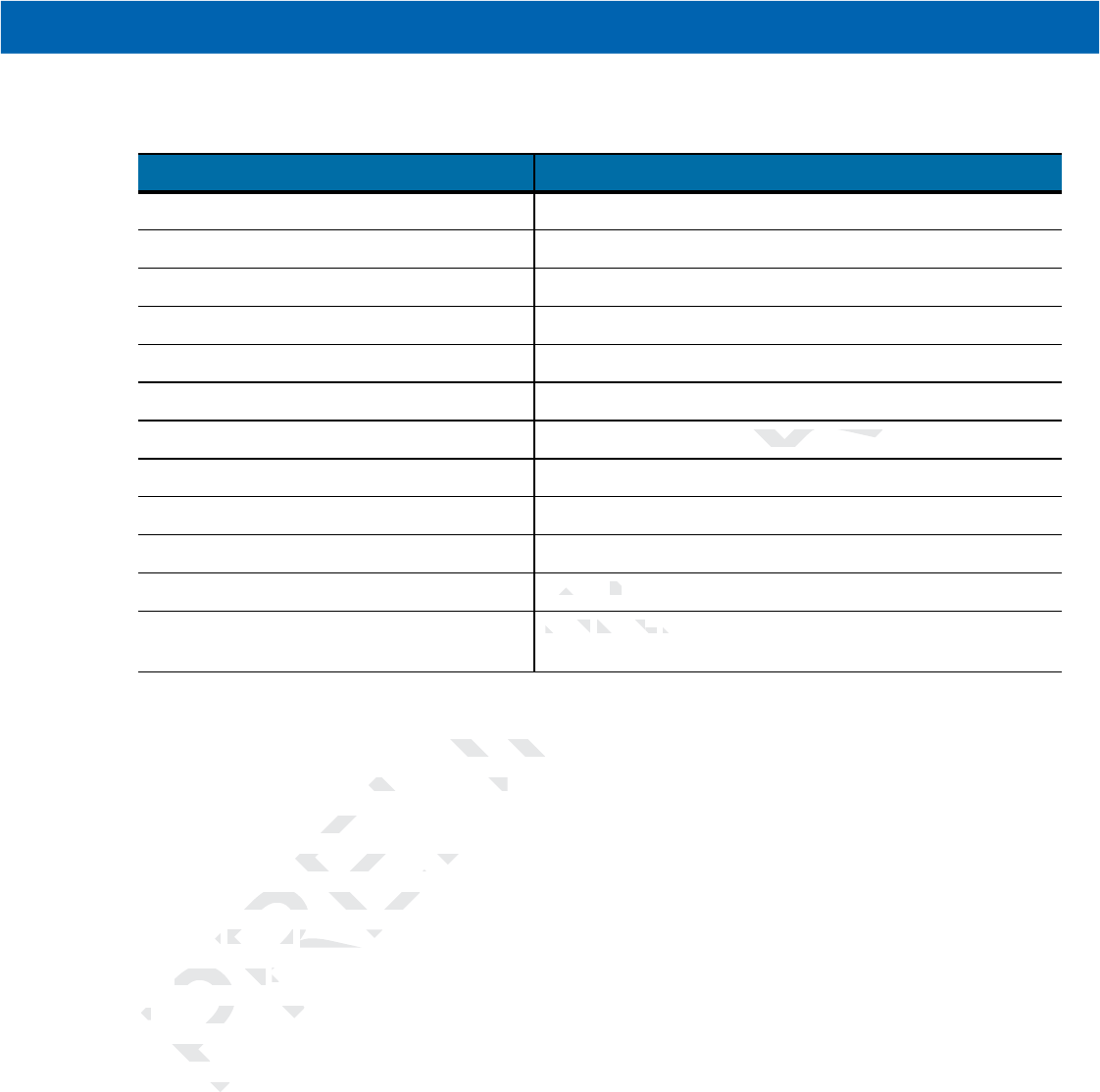
Operation 2 - 3
Selecting Items
Use a combination of key sequences to select items in a folder or list.
To select continuous items in a folder or list:
1. Open the folder or list.
2. Use the navigation pad to move to the first item to select.
3. Press Orange key to activate the alpha mode.
4. Press SHIFT - navigation pad (either up or down) to select the next item.
5. Repeat the SHIFT - navigation pad combination to select remaining items.
6. Perform the desired function (copy, paste, etc.).
To select multiple items in a folder or list:
1. Open the folder or list.
2. Press Orange key to activate the alpha mode.
3. Use the navigation pad to move to the first item.
4. Press CTRL - navigation pad to move within the list. The item name is outlined.
5. Repeat step 4 to move to the desired item.
6. Press SPACE to highlight the item.
7. Repeat steps 4 through 6 until all items are selected.
8. Perform the desired function (copy, paste, etc.).
Table 2-1
Key Combinations
Action Key Combination
Access the Start menu on the Task bar Press CTRL - ESC
Switch fields within an application Press TAB
Close windows or cancel operations Press ESC
Access the Task Manager Press ALT - TAB
Minimize current window Press ALT - ESC
Access a menu bar Press ALT - CTRL
Press a button in an application window. Press F - TAB until the button is highlighted. Press A - SPACE
Windows Explorer - Select All CTRL - A
Windows Explorer - Cut CTRL - X
Windows Explorer - Copy CTRL - C
Windows Explorer - Paste CTRL - V
Toggle IME mode on/off (Simplified Chinese
only)
Press CTRL - SPACE
RY
Y
RY
ARY
the button is highlighte
utton is highlighte
NAR
-
C
INA
TRL
TR
-
V
V
MIN
Press
Press
CTRL
CTRL
-
-
SPA
S
M
PRELIMI
uences to select itemsto select ite
s in a folder or list:in a folder or list:
r list.r list.
gation pad to move toation pad to move to
range key to activate range key to activate
ss
s
SHIFT -
SHIFT -
navigation
navigation
Repeat the
Repeat the
SHIFT
S
-
6.6.
Perform the desform the des
select multipselec
ntnt
RY
RY
AR
A
NA
NA
IN
MI
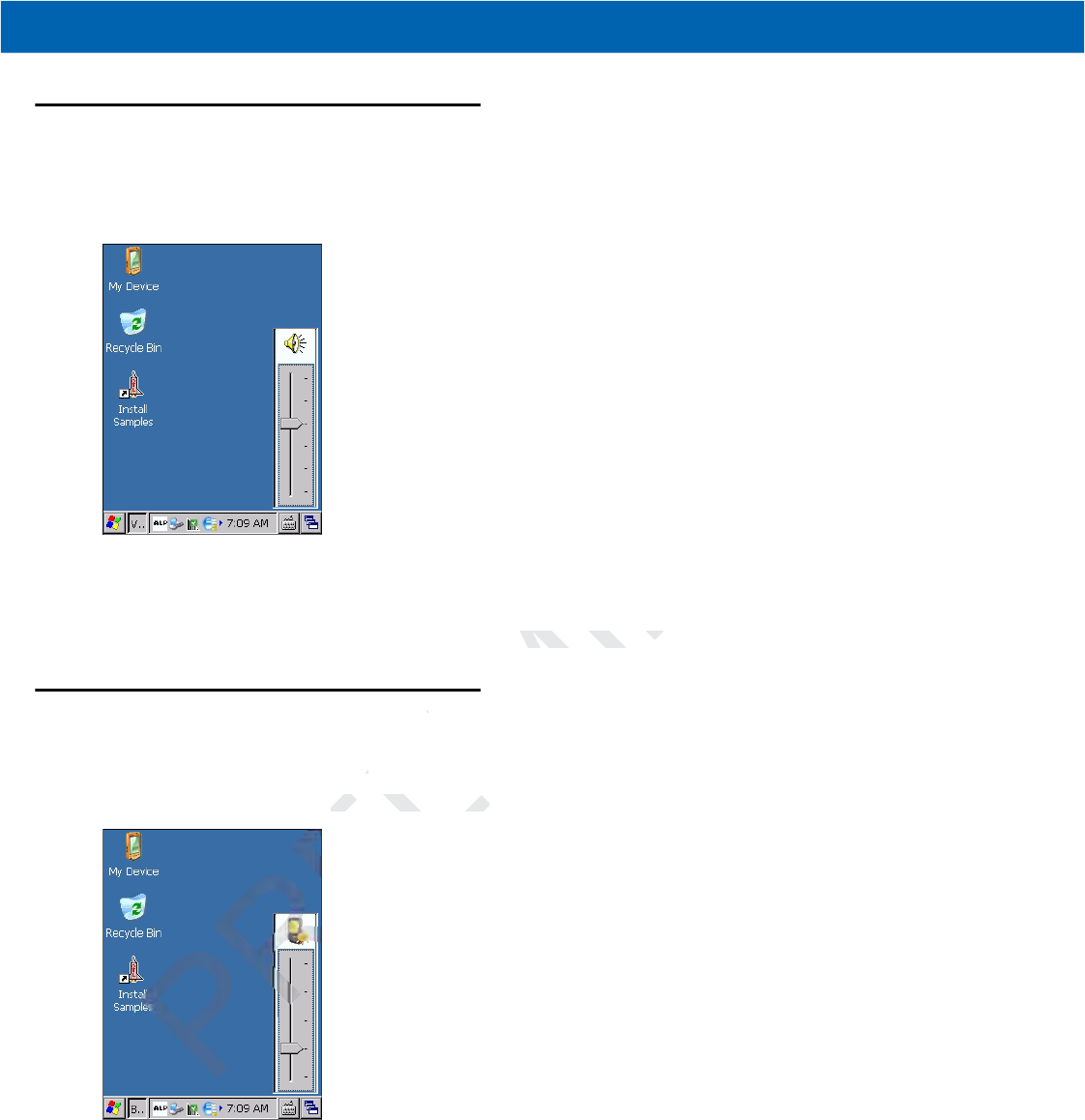
2 - 4 MC21XX Series User Guide
Adjusting the Volume
To adjust the beeper volume on the MC2100 and the audio volume on the MC2180:
1. Press Orange key - F1. The volume control box appears.
Figure 2-3
Volume Control Box
2. Use the navigation pad to adjust the volume.
3. After three seconds of inactivity, the settings are saved and the box disappears.
Adjusting the Screen Brightness
To adjust the screen brightness:
1. Press Orange key - F2. The brightness contrast control box appears.
Figure 2-4
Brightness Control Box
2. Use the navigation pad to adjust the contrast.
3. After three seconds of inactivity, the settings are saved and the box disappears.
RELIMINARY
gs are saved and the
re saved and the
M
ss
s
s:
s:
. The brightness cont
. The brightness con
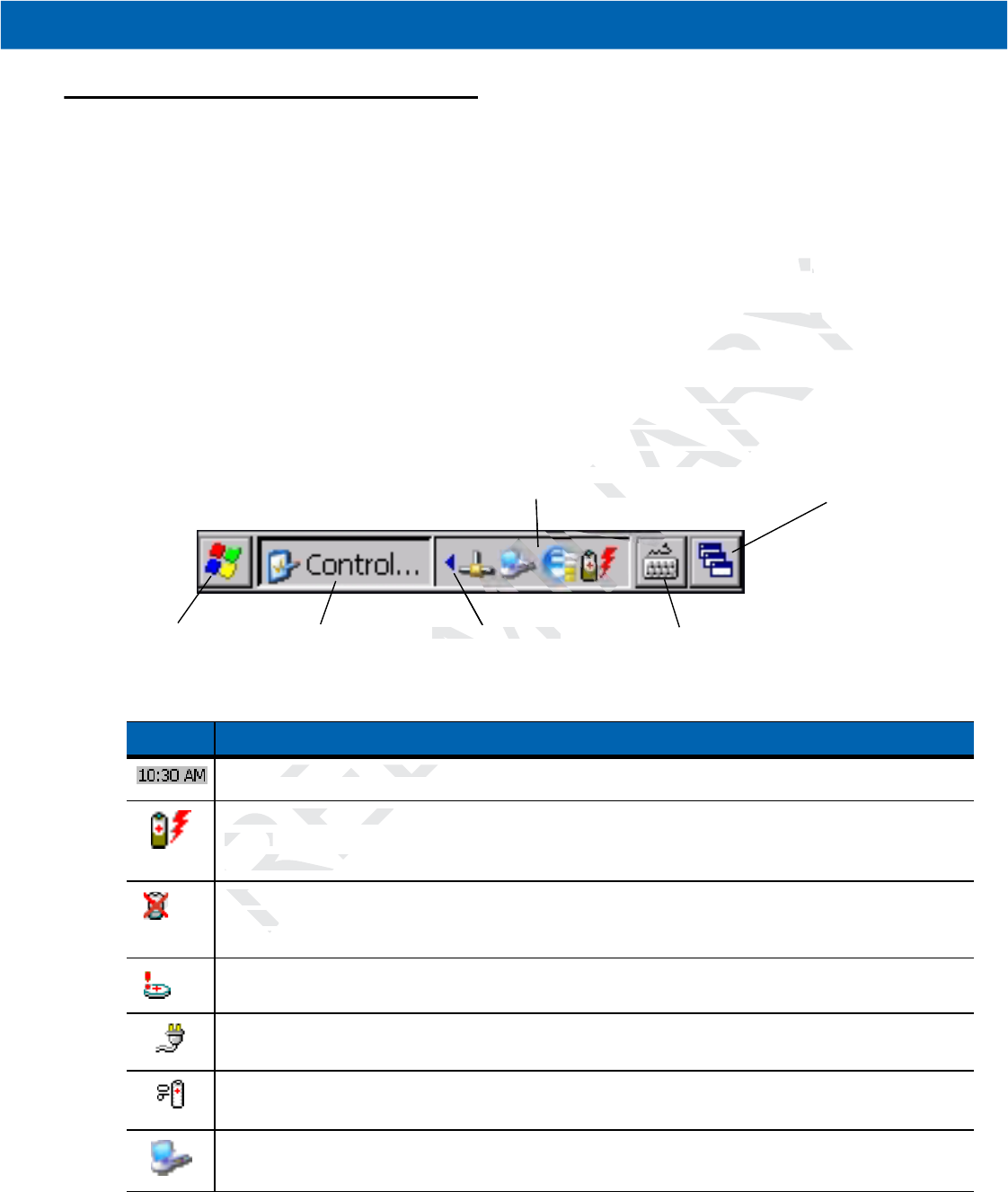
Operation 2 - 5
Windows CE Status Icons
The taskbar (at the bottom of the screen) displays the Start button, active programs and status icons. The
taskbar icons are described in Table 2-2. The taskbar icons display the function status, indicate what programs
are active and indicate the battery charge status. The Taskbar buttons are used to access menus,
select/deselect functions or to change display windows.
•
Status Icons: The status icons indicate the function key status. If the FUNC,SHIFT,CTRL, ALT or
ALPHA functions are active the appropriate status icon is displayed.
•
Active Programs Icons: The active applications icons are displayed on the taskbar. If more than one
program is active, icons can be used to toggle between the open programs (applications). Tap on a
taskbar application to maximize the application.
•
AC Power/Battery Status Icons: The AC Power/Battery Status icons are shown in the taskbar to indicate
the present power supply status of the MC21XX. The main battery status icons provide the battery status
in 10% increments from 10% to 100%. The backup battery low icon indicates that the backup battery
charge is low. See Battery Charging on page 1-5 for backup battery charging instructions.
Figure 2-5
Taskbar
Table 2-2
Taskbar Icons
Icon Description
Clock: Indicates the current time.
Battery: This icon indicates that the main battery is charging or that the terminal is operating on AC
power.
Double tapping on this icon opens the Power Properties window.
Indicates that communication with the battery has not been established. After a MC21XX reset, this
icon may be displayed for up to 30 seconds. See,
Battery Unknown Icon on page 2-6
for additional
information.
Indicates that the backup battery is low.
AC Plug: Indicates that the battery is fully charged and the MC21XX is running on external power.
Battery: This icon indicates that the battery is fully charged (100% charged).
The battery status icons provide the battery status in 10% increments from 10% to 100%.
Serial Connection: It is displayed when the terminal is connected to a host computer with a serial
cable.
Start Button
Open Programs and Status Icons
Keyboard Input Panel Button
Desktop Display Button
Window Title Scroll Status Icons
NARY
IFT
FT
,
,
CT
he taskbar. If more th
taskbar. If m
grams (applications). T
grams (applications
icons are shown in th
s are shown in th
battery status icons pro
battery status ic
ry low icon indicates t
low icon indicates
ackup battery chargin
ackup battery chargin
PRELIMINA
ELI
Indicates the current
Indicates the current
Battery:
Battery
This icon indic
This icon indic
power.power.
Double tapping oDouble tapping o
Indicates thaIndica
icon may n ma
informa
In
PR
LI
EL
RE
PR
P
tatus Iconss Icon
IN
Scroll Status IconsScroll Status Icons
M
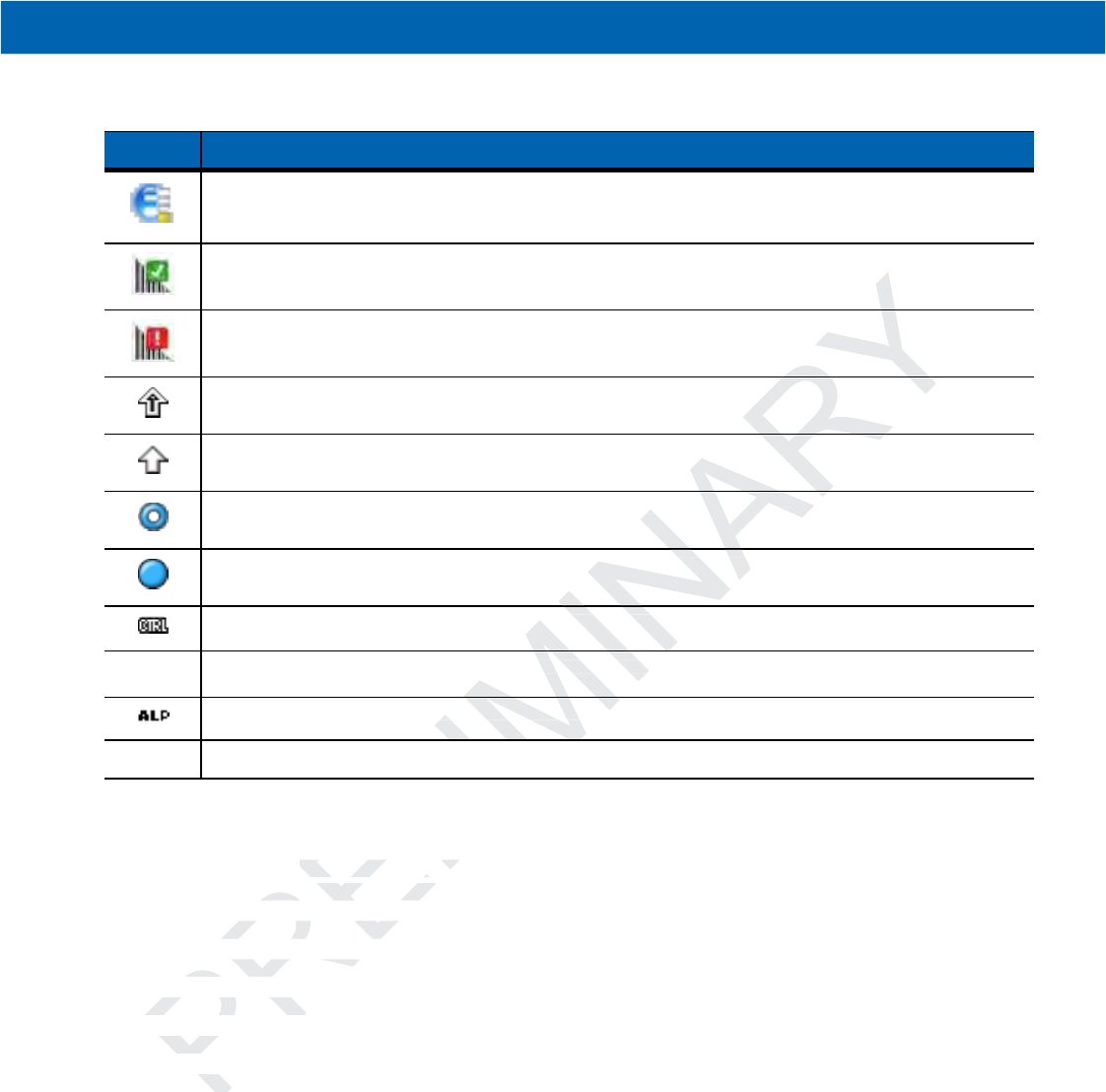
2 - 6 MC21XX Series User Guide
Battery Unknown Icon
The Battery Unknown icon displays when communication with the smart battery has not been established. As
part of normal operation this icon may be displayed for 30 seconds following a MC21XX reset.
If the icon displays beyond this 30 second period:
1. Remove and re-seat the battery.
2. If after re-seating the battery, the icon remains, warm boot the MC21XX.
3. If after warm booting the MC21XX, the icon remains, then cold boot the MC21XX.
4. If after cold booting the MC21XX, the icon remains, install a new (tested and working) battery.
5. If the icon remains, return the MC21XX for servicing.
Start Button
Tap the Start button to launch the Start menu.
•
Programs: Use to access available programs.
•
Favorites: Displays files in Favorites directory.
•
Documents: Displays files in Documents directory.
Wireless Connection Status: Indicates WLAN signal strength.
DataWedge Running: Indicates that the DataWedge application is running.
DataWedge Idle: Indicates that the DataWedge application is idle.
Shift: Indicates that the Shift function is selected.
Shift Lock: Indicates that the Shift Lock function is selected.
Function: Indicates that the Function feature is selected.
Function Lock: Indicates that the Function Lock feature is selected.
CTRL: Indicates that the CTRL button function is selected.
ALT: Indicates that the ALT character selection is selected.
ALPHA: Indicates that the MC21XX is in ALPHA button mode is selected.
Bluetooth:
Table 2-2
Taskbar Icons (Continued)
Icon Description
ALT
.
cted.
cte
ock feature is selected
ock feature is selecte
function is selected.
function is select
acter selection is selec
election is sele
MC21XX is in ALPHA
MC21XX is in ALPHA
Y
RY
AR
AR
NA
IN
MIN
M
LIM
LIM
PRELI
wn
n
icon displays when
icon displays when
eration this icon may bration this icon may b
plays beyond this 30 splays beyond this 30 s
ove and re-seat the b
ove and re-seat the b
f after re-seating the f after re-seating the
after warm bootafter wa
cold bcold
LI
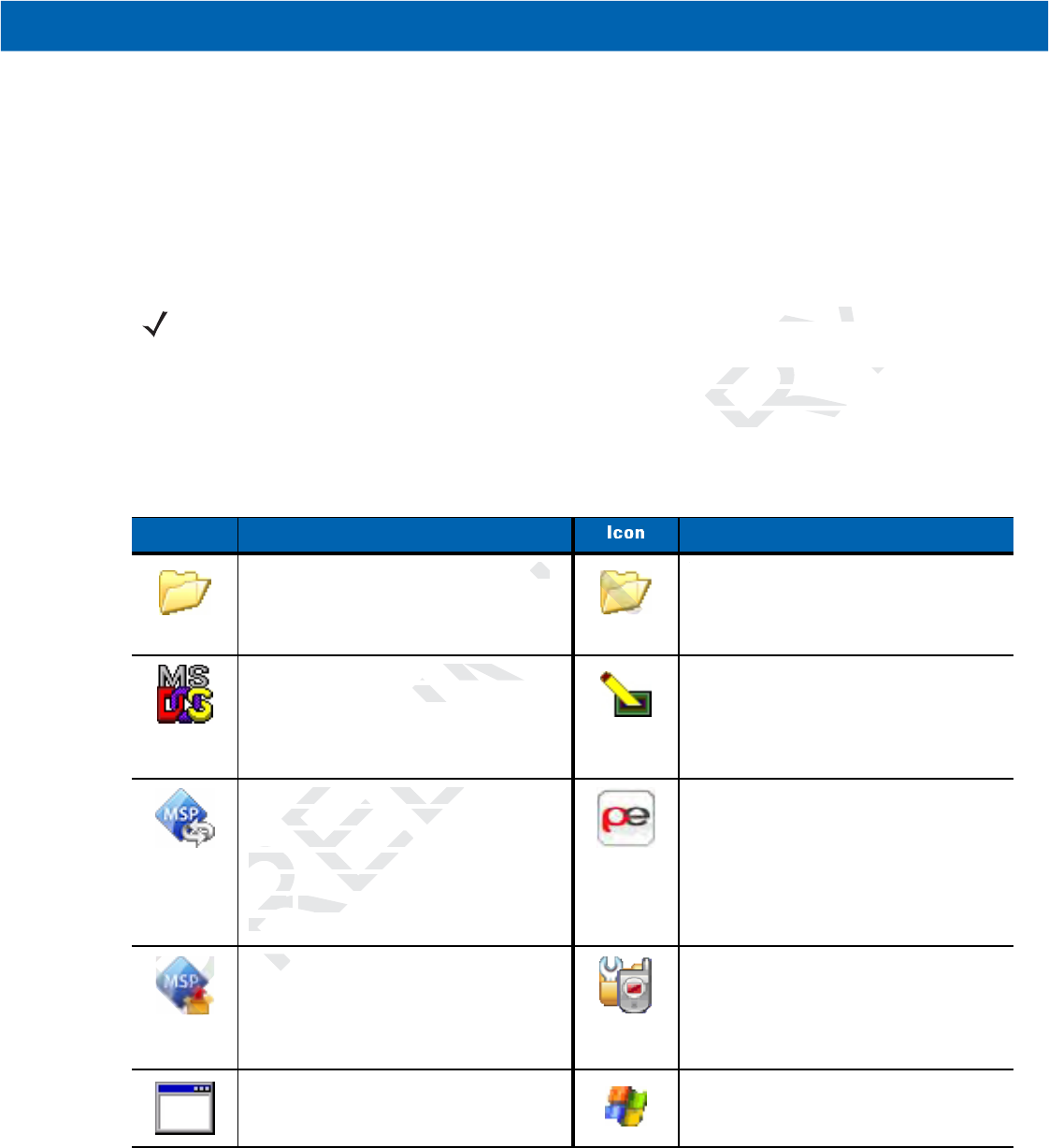
Operation 2 - 7
•
Settings: Accesses the Control Panel, the Network and Dial-up Connections and the Taskbar and Start
menu.
•
Run: Runs a program or application.
•
Suspend: Places the MC21XX in the suspend state.
Programs Menu
From the Start menu, tap Programs to open the Programs menu. The programs installed on the MC21XX
with Windows CE display in the Programs menu. Refer to the Application Guide for Motorola Enterprise
Mobility Devices, p/n 72-68901-xx and the Microsoft®Applications for Mobile 6.1 and CE 6.0 User Guide, p/n
72E-108299-xx for application information.
NOTE For the MC2100, see Using the Keypad to Navigate Applications on page 2-2 for instruction on navigating
using the navigation pad.
Table 2-3
Applications in the Programs Menu
Icon Description Icon Description
Communications Folder: Opens the
Communication folder.
Fusion Folder: Open the Wireless
Companion folder. See Chapter 5,
Wireless Applications for more
information.
Command Prompt: Opens a DOS
command prompt window.
CtlPanel: View and change MC21XX
settings such as: Scanner Parameters,
Display Settings, Audio Settings,
Printer Settings, Date and Time
Settings, Touch Screen Settings, etc.
MSP Agent: Interacts with MSP agents
to collect monitoring and asset
information to enable the configuration,
provisioning, monitoring and
troubleshooting of the MC21XX. Refer
to the MC21XX Integrator Guide for
more information.
RhoElements Basic Browser: Browse
Web and WAP sites.
Rapid Deployment Client: Facilitates
software downloads from a Mobility
Services Platform Console FTP server to
the MC21XX.
Refer to the MC21XX
Integrator Guide for more information.
TEAM Express Configuration -
Opens the TEAM Express
Configuration window.
WarmBoot: Warm boots the MC21XX. Windows Explorer: Organize and
manage files on your device.
NARY
programs installed on
programs installed on
tion Guide for Motoro
on Guide for Moto
for Mobile 6.1 and CE
bile 6.1 and CE
2-2
22
for instruction
for inst
2
NA
N
NA
n
N
N
F
F
MIN
the
he
MIN
ELIM
Opens a DOS
Opens a DOS
window.
ndow
M
NA
NA
N
M
PREL
Agent:Agen
Interacts with Mnteracts with M
collect monitoring andollect monitoring and
nformation to enable t
nformation to enable
provisioning, monito
provisioning, monito
troubleshooting o
ubleshooting o
to the
o the
MC21X
MC21X
more informmo
PR
PR
Rapid apid
softw
S
PR
EL
PR
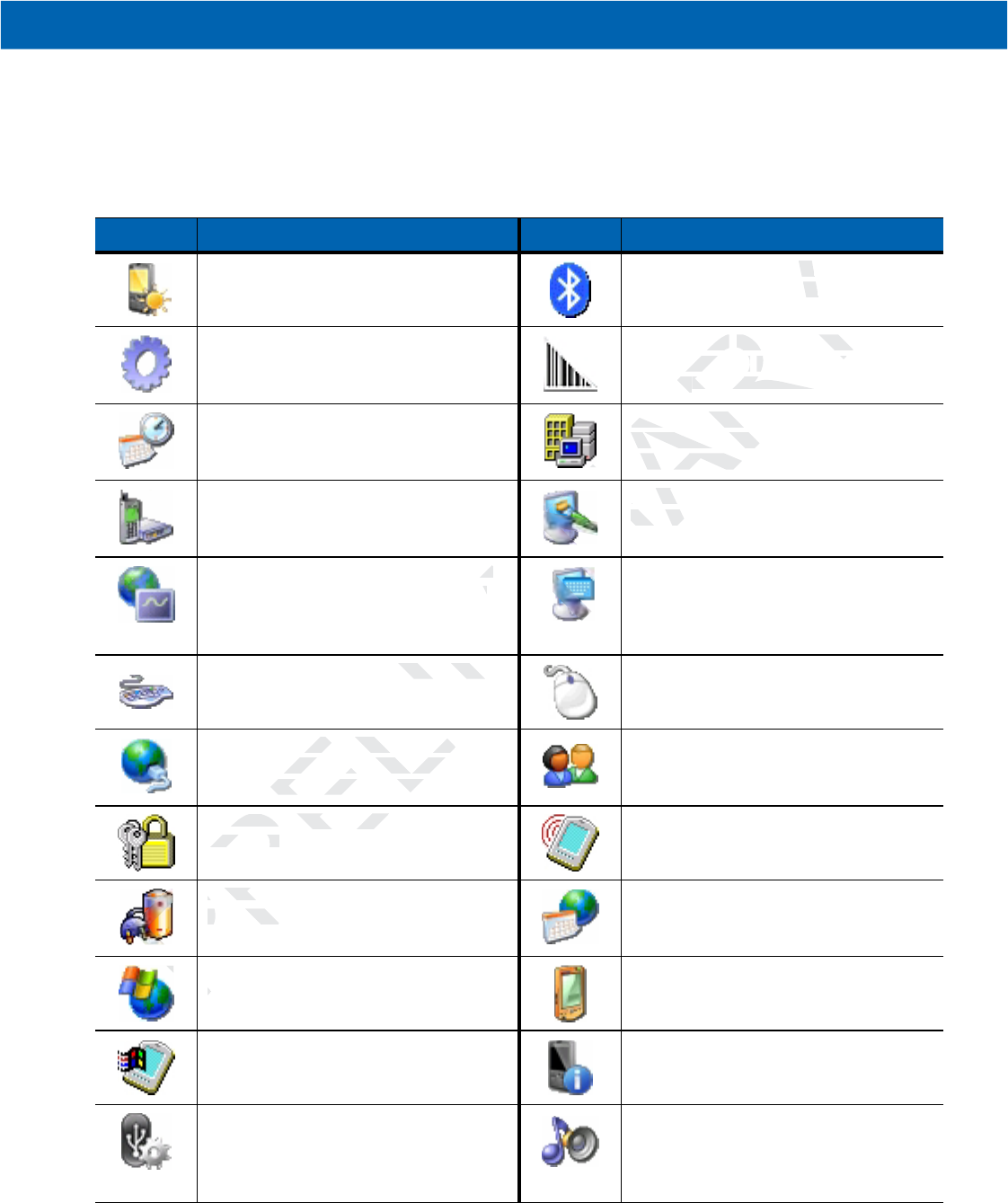
2 - 8 MC21XX Series User Guide
Control Panel
Table 2-4 lists the applications in the Control Panel.
Table 2-4
Programs on the Control Panel
Icon Description Icon Description
Backlight: Adjust the backlight
brightness and power settings.
Bluetooth Device Properties: Launch
the Bluetooth application.
Certificates:
See information about
certificates installed on the MC21XX.
DataWedge:
Sample scanning
application. See
Chapter 3, Data
Capture
for more information.
Date/Time: Change date, time and
time zone information.
Device Management: Enables
downloading and installation of new
software packages.
Dialing: Set dialing properties for
modem communication and change
telephony settings.
Display: Change desktop background,
appearance, backlight and brightness.
Error Reporting: Choose whether to
MC21XX collects software operation
information to use if a serious error
occurs.
Input Panel: Switch input methods and
set input options.
Keyboard: Change keyboard repeat
delay and rate.
Mouse: Adjust double-click sensitivity
for both the speed and timing.
Network and Dial-up Connections:
Connect to other computers, networks
and the Internet using a modem.
Owner: Change owner’s personal
profiles.
Password: Set a password for the
MC21XX.
PC Connection: Change settings for
connectivity of a host computer.
Power: View and control MC21XX
power settings.
Regional Settings: Change how
numbers, currencies, dates and times
appear.
Remove Programs: Remove
programs installed on the MC21XX.
Stylus: Calibrate the touch screen and
adjust double-tap timing.
System: View system information and
change memory settings.
System Info: View information on the
MC21XX’s system components.
USBConfig: Configure the MC21XX
USB port.
Volume & Sounds: Select the type of
actions for which to hear sounds and
customize notifications for different
events.
PRELIMINARY
Y
Propert
op
plication.
on
ge:
ge:
Sample scanning
Sample scannin
tion. See
tion. See
Chapter 3, D
Chapter 3, D
ture
re
for more informat
for more informa
Device Managemen
Device Manag
downloading and i
downloading and
software packag
oftware packa
Display:
Displa
C
appeara
appear
to
to
ation
n
error
In
eyboard repeat board repeat
d Dial-up Connectiond Dial-up Connectio
o other computers, ne
o other computers, ne
e Internet using a modInternet using a mod
ssword:ssword
Set a passwSet a passw
MC21XX.MC21XX.
Power:
Power
View a
power settinpower set
PR
MI
NA
Y
RY
AR
NA
IN
IM
LI
RE
PR
P
Rem
prp
P
P
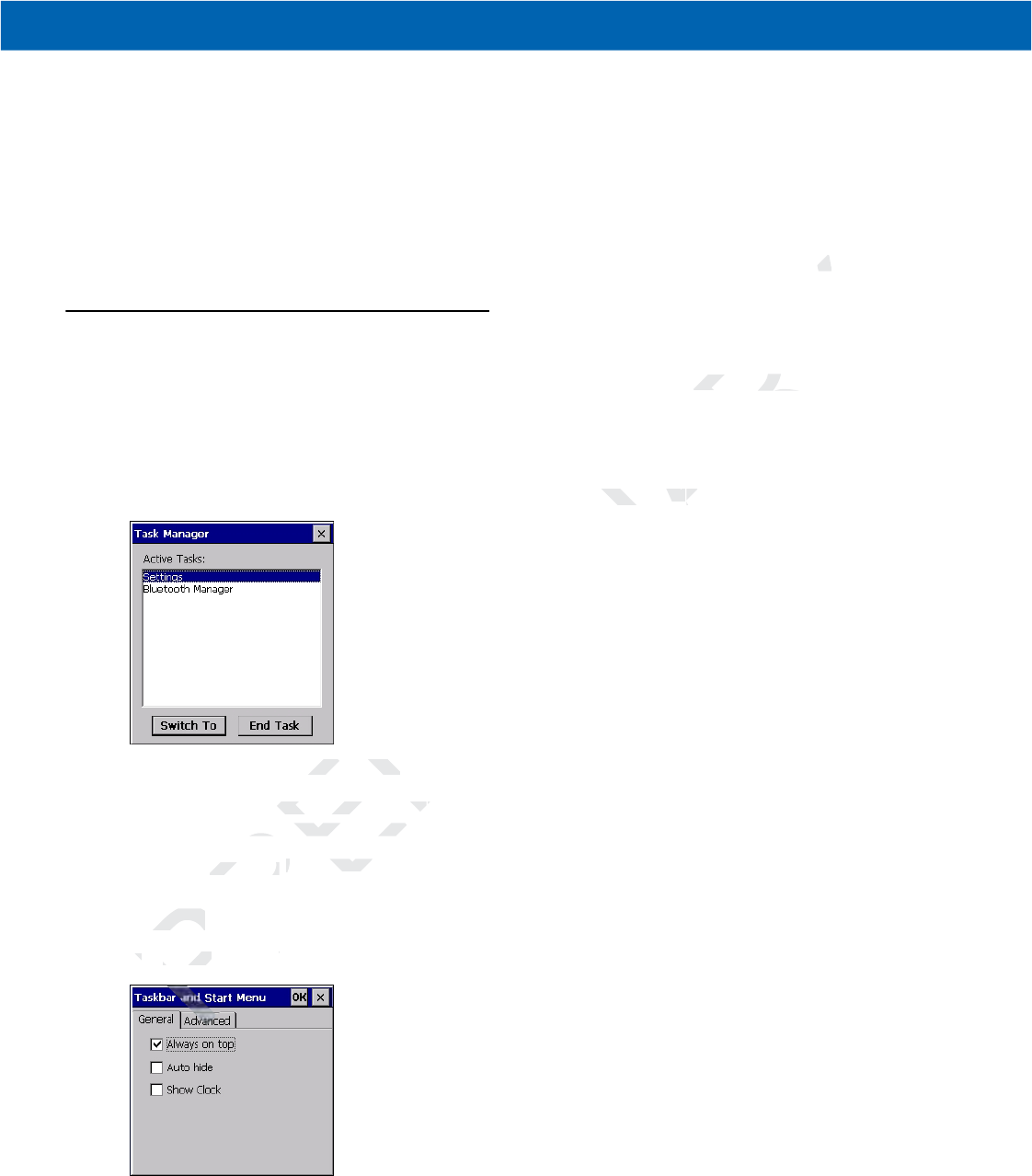
Operation 2 - 9
Keyboard Input Panel Button
On the MC2180, use the Keyboard Input Panel as an alternate input device. For more information, see
Entering Information Using the Keyboard Input Panel on page 2-12.
Desktop Display Button
On the MC2180, use the Desktop Display button to minimize all open programs and display the desktop.
Task Manager and Properties
Use the Task Manager to control an application’s use and use the Properties functions to set display and
clock options.
Task Manager
1. Press Blue key -CTRL (to activate the ALT state) then press TAB to display the Task Manager.
Figure 2-6
Task Manager Window
2. Select a task in the Active Tasks list and select Switch To to make that task the primary task, or select
End Task to end the selected task.
3. Tap X or press ESC to exit the Task Manager window.
Properties
1. Select Start > Settings > Taskbar and Start Menu ... . The Task Bar and Start Menu window displays.
Figure 2-7
Taskbar and Start Menu - General Tab
2. This menu provides taskbar options:
•
Check the Always on Top checkbox to keep the taskbar on top of all other windows.
PRELIMINARY
displa
isp
perties
perti
functions to s
functio
en press
press
TAB
AB
to disp
to
ger Windowger Window
in the n the
Active Tasksctive Tasks
to end the selected tato end the selected t
or press or press
ESCE
to exitto exit
ertieserties
11
SelectSelect
Start
>
SS
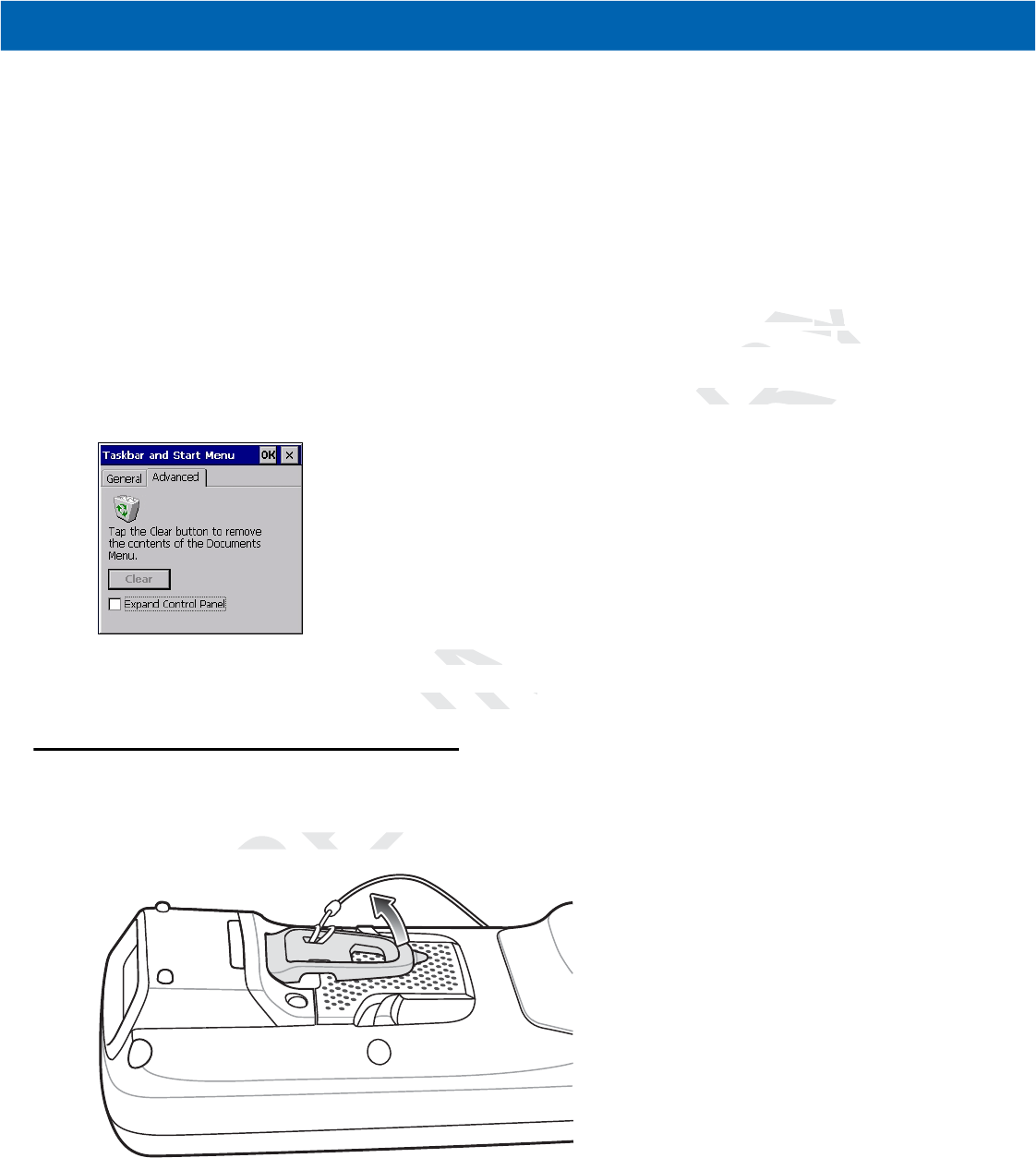
2 - 10 MC21XX Series User Guide
•
Check the Auto hide checkbox to make the taskbar disappear, touch the bottom of the display to make
the taskbar return.
•
Check the Show Clock checkbox to display the clock on the taskbar.
3. Select OK to save the settings and exit the window.
Advanced Tab
1. Select the Advanced tab.
2. Select the Clear button to delete all of the documents listed in the Start > Documents entry, see Start
Button on page 2-6. Typically this list is empty, but if there were documents in the list the Clear button
would delete them.
3. Select the Expand Control Panel checkbox to display the entire contents of the Control Panel in list form,
rather than icons.
Figure 2-8
Taskbar and Start Menu, Advanced Tab
4. Select OK to save the settings and exit the window.
Stylus
To remove the stylus, Lift the point end of the stylus up and slide it out of the bar.
Figure 2-9
Mini Stylus Removal
To store the stylus, slide the flat end of the stylus under the bar and then lower to the back of the MC21XX.
RELIMINARY
ments
ments
entry, see
ent
n the list the
n the list the
Clear
Cle
bu
r
ents of the Control Pa
nts of the Control P
anced Tab
nced Tab
and exit the window.exit the window.
LI
ylus, Lift the point endylus, Lift the point end
PRE
PR
PR
PR
P
PR
PR
P
P
P
PR
PR
PR
P
R
PR
R
R
R
R
R
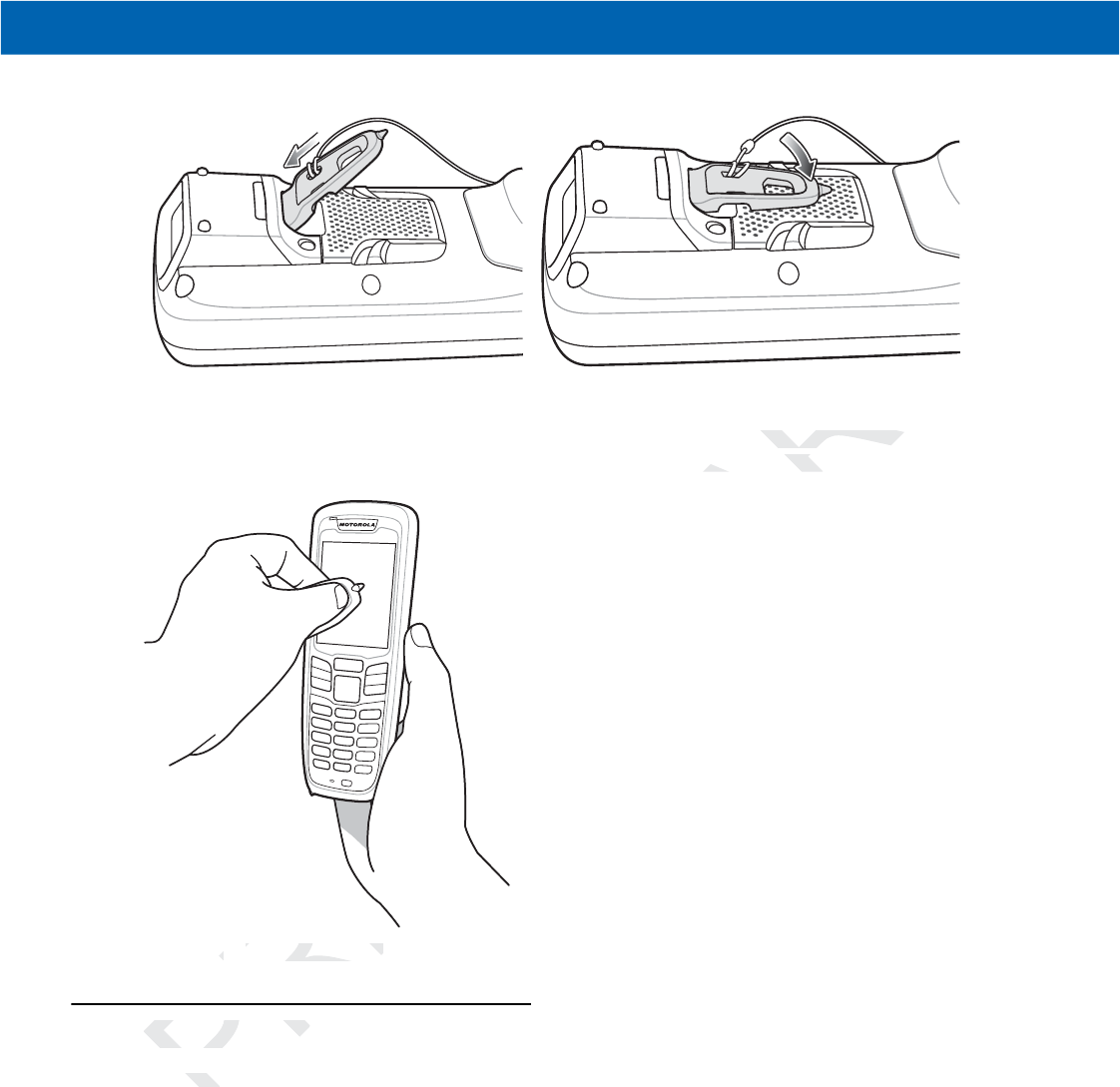
Operation 2 - 11
Figure 2-10
Mini Stylus Installation
Use the stylus for selecting items and entering information on the screen. The stylus functions as a pen and a
mouse. Tap the touch screen once with the stylus to select options and open menu items.
Figure 2-11
Using the Stylus
Entering Information
To enter information:
•
Use the keypad.
•
Use the keyboard input panel (soft keyboard) to enter text.
•
Scan bar code data into data fields.
•
Use Microsoft® ActiveSync® or Windows Mobile Device Center (WMDC) to synchronize or copy
information from the host computer to the MC21XX. For more information on ActiveSync and WMDC,
refer to the MC21XX Series Mobile Computer Integrator Guide.
PRELIMINARY
reen. The stylus funct
n. The stylus funct
s and open menu item
s and open me
111
Using the StylusUsing the Stylus
PR
ng Information
ng Informatio
nter informnter i
RY
RY
RY
RY
Y
Y
Y
RELIM
REL
E
ELIM
ELIM
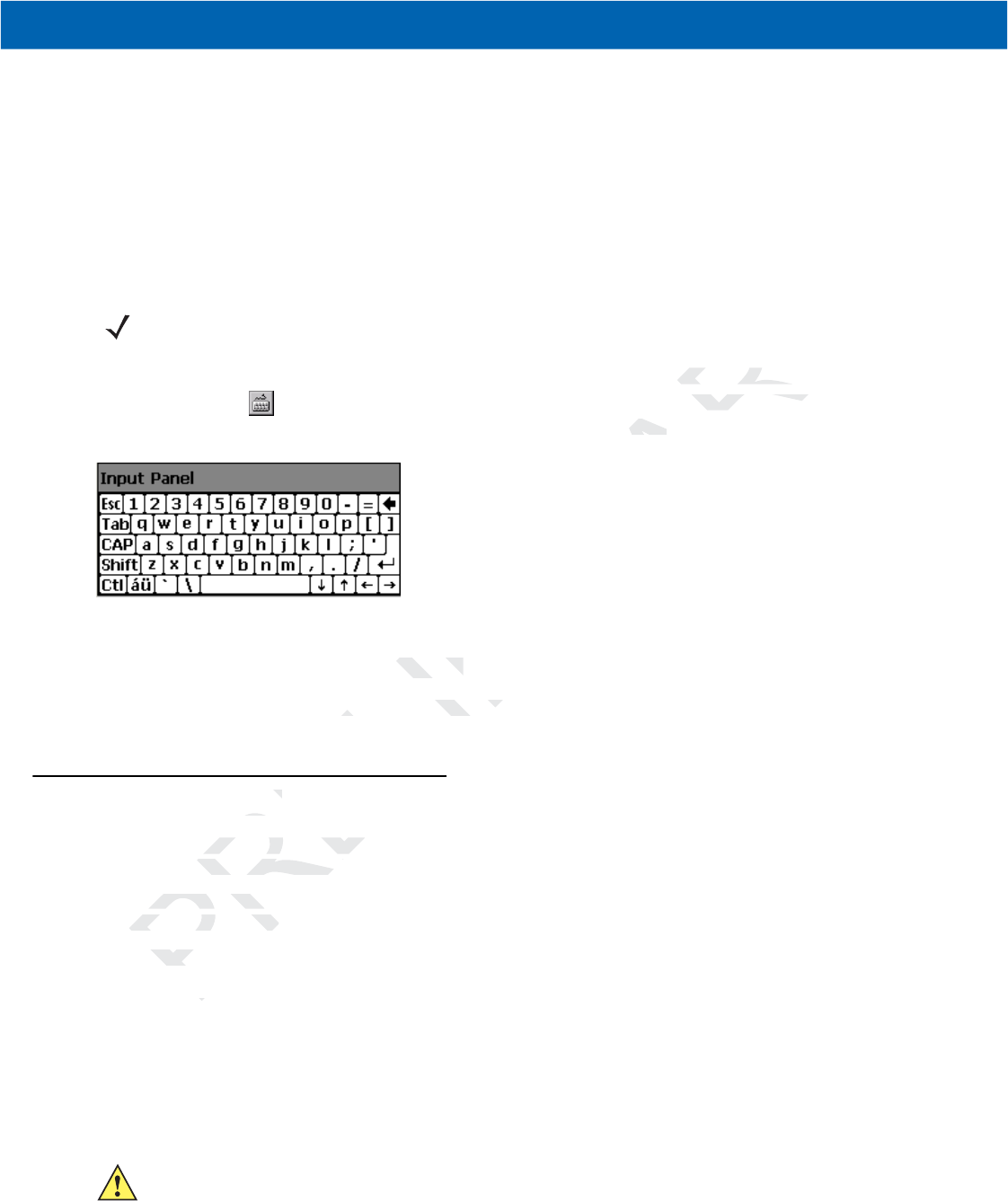
2 - 12 MC21XX Series User Guide
Entering Information Using Keypad
The alphanumeric keypad produce the 26-character alphabet (A - Z), numbers (0 - 9), function keys and
assorted characters. The keypads default characters/functions are printed white, the ALPHA
character/functions are printed orange and the functions are printed blue. See Appendix B, Keypad for keypad
special functions and special character generation.
Entering Information Using the Keyboard Input Panel
Use the keyboard input panel (soft keyboard) to enter information in any program. To launch the keyboard
input panel, tap the button on the taskbar and then tap Keyboard. Tap a key to enter the value. Tap the
keyboard input panel button to display or to hide the keyboard input panel.
Figure 2-12
Keyboard Input Panel
Entering Data via the Bar Code Scanner
The sample bar code scanner application scans data into data fields in the same way data is entered via the
keypad.
Resetting the MC21XX
If the MC21XX stops responding to input, reset it. There are two reset functions, warm boot and cold boot. A
warm boot restarts the MC21XX by closing all running programs. All data that is not saved is lost.
A cold boot also restarts the MC21XX, but erases all stored records and entries from RAM. In addition it
returns formats, preferences and other settings to the factory default settings.
Perform a warm boot first. If the MC21XX still does not respond, perform a cold boot.
Performing a Warm Boot
To perform a warm boot:
1. Press the Power button for five seconds.
2. The MC21XX reboots.
NOTE MC2180 only.
CAUTION Files that remain open during a warm boot may not be retained.
RELIMINARY
ogram. To launch the
ogram. To launc
Tap a key to enter the
key to enter the
panel.
panel.
Scannercanner
pplication scans datapplication scans data
EL
PRE
1XX
1XX
X stops responding to
X stops responding to
restarts the MC21XX starts the MC21XX
boot also restarts theboot also restar
PR
rns formats, preferenc
rns formats, preferen
m a warm boo
m a wa
WW
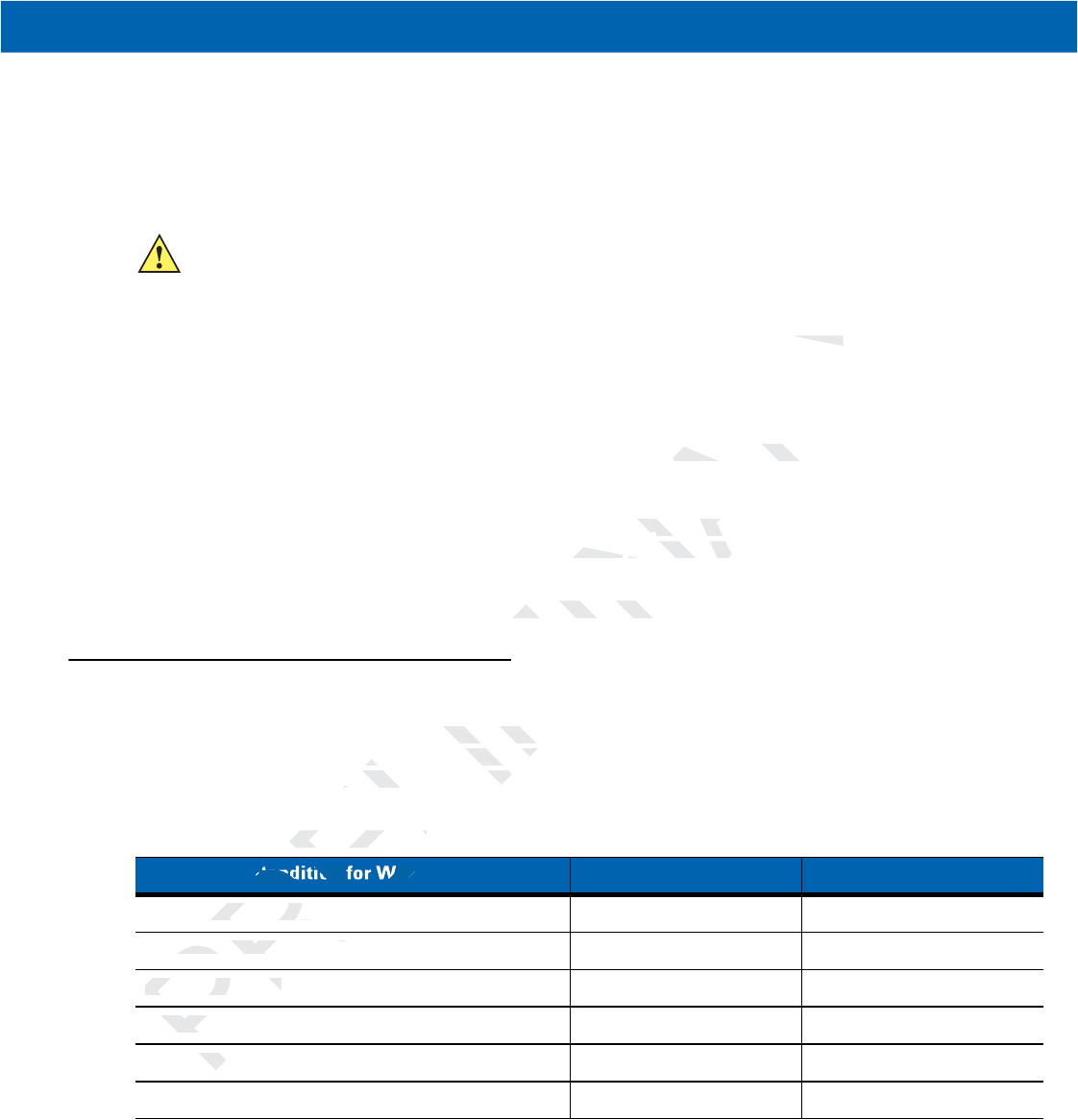
Operation 2 - 13
Performing a Cold Boot
A cold boot restarts the MC21XX and erases all user stored records and entries from RAM. Never perform a
cold boot unless a warm boot does not solve the problem.
To perform a cold boot:
1. If the MC21XX is in suspend mode, press the Power button to wake the MC21XX.
2. Press the Power button to place the MC21XX in suspend mode.
3. On the MC2180, tap Safe Battery Swap.
On the MC2100, using the navigation pad, scroll down to Safe Battery Swap. Press the Enter key.
4. Wait for the LED Indicator to turn red and then turn off.
5. Simultaneously press and then release the 1,9and Power keys. Do not hold down any other keys or
buttons. As the MC21XX initializes, the splash window, Figure 1-10 on page 1-10, appears for about a
minute.
6. Calibrate the touch screen. See Calibration Screen on page 1-10 to calibrate the MC21XX screen.
Waking the MC21XX
The wakeup conditions define what actions wake up the MC21XX after it has gone into suspend mode. The
MC21XX can go into suspend mode by either pressing the Power button or automatically by Control Panel
time-out settings. These settings are configurable and the factory default settings are shown in Table 2-5.
To access the Wakeup settings:
Select Start > Settings > Control Panel >Power icon > Wakeup tab.
CAUTION Cold boot resets the MC21XX, to the default settings. All added applications and all stored data are
removed. Do not cold boot without support desk approval.
Table 2-5
Wakeup Default Settings
Condition for Wakeup Power Button Automatic Time-out
AC power is applied. Yes Yes
MC21XX is connected to a USB cable. Yes Yes
A key is pressed. No Yes
The scan triggered is pressed. Yes Yes
The screen is touched (MC2180 only). No No
USB Host No No
PRELIMINARY
MC21XX.
21XX
fe Battery Swap
fe Battery Swap
. Pre
Power
wer
keys. Do not
keys. D
r
r
ndow,
ndow,
Figure 1-10 on
Figure 1-10 o
on Screen on page 1-
on Screen on page
M
what actions wake up
ctions wake
nd mode by either prend mode by either pre
settings are configura
settings are configura
p Default Settings Default Settings
RE
Condition for Wake
er is applied.er is applied.
21XX is connected to 21XX is connected to
A key is pressed.A key is pressed.
RE
RE
R
PR
P
he scan triggehe sca
P
P
creencree
P
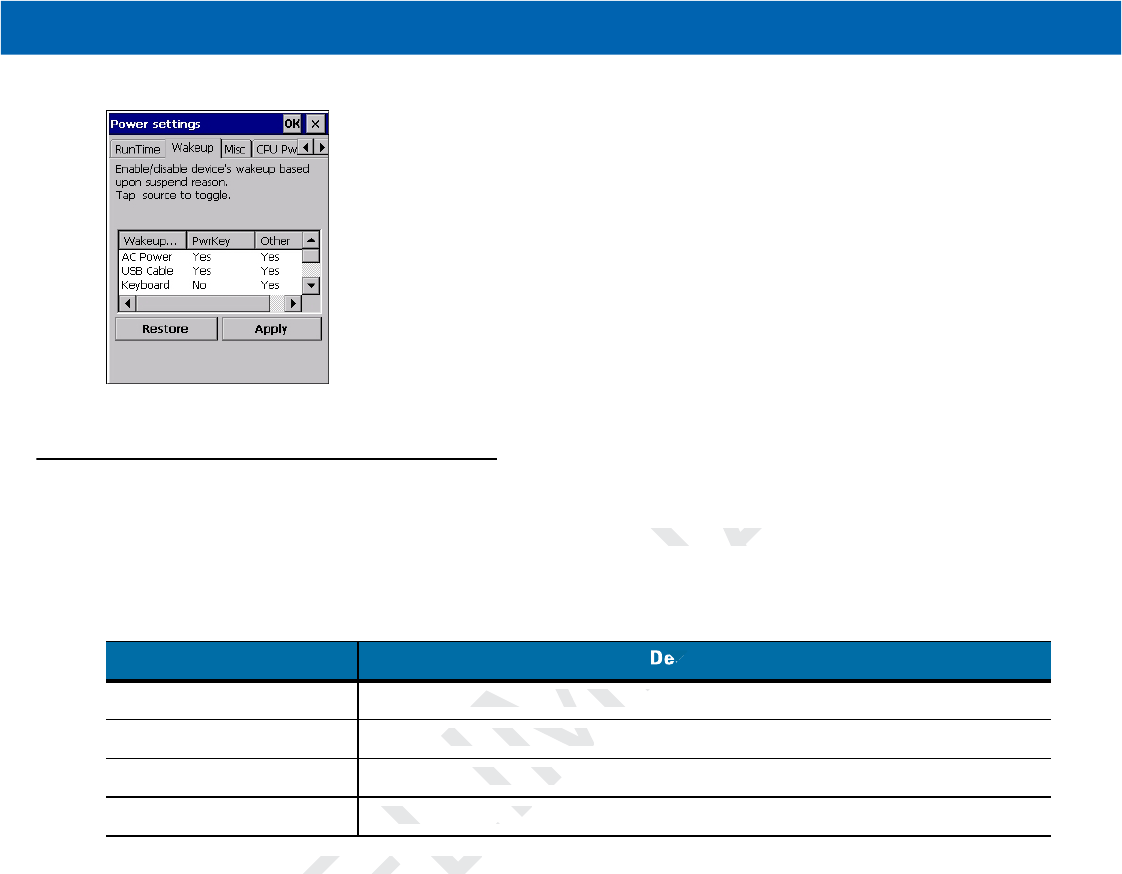
2 - 14 MC21XX Series User Guide
Figure 2-13
Power Settings - Wakeup Tab
Battery Health
The health of the battery can be viewed on the MC21XX Power applet. Select Start > Settings > Power icon >
BatteryMgmt tab.
For information on changing the Battery Usage Threshold, refer to the MC21XX Series Integrator Guide.
Table 2-6
BatteryMgmt Window
Item Description
State of Health Indicates the current state of the battery (Healthy or Unhealthy).
Battery Usage Indicator Indicates the usage of the battery.
Battery Usage Threshold Indicates the usage indicator threshold.
Battery Serial # Displays the serial number of the battery.
MINARY
er applet. Select
applet. Select
Start
MIN
esc
MI
e current state of the
e current state of the
LIM
es the usage of the ba
s the usage of the
LIM
dicates the usage indie usage ind
MIN
MI
M
LIM
ELI
Displays the serial nDisplays the serial n
E
PREL
nging the Battery Usa
nging the Battery Usa
LI
EL
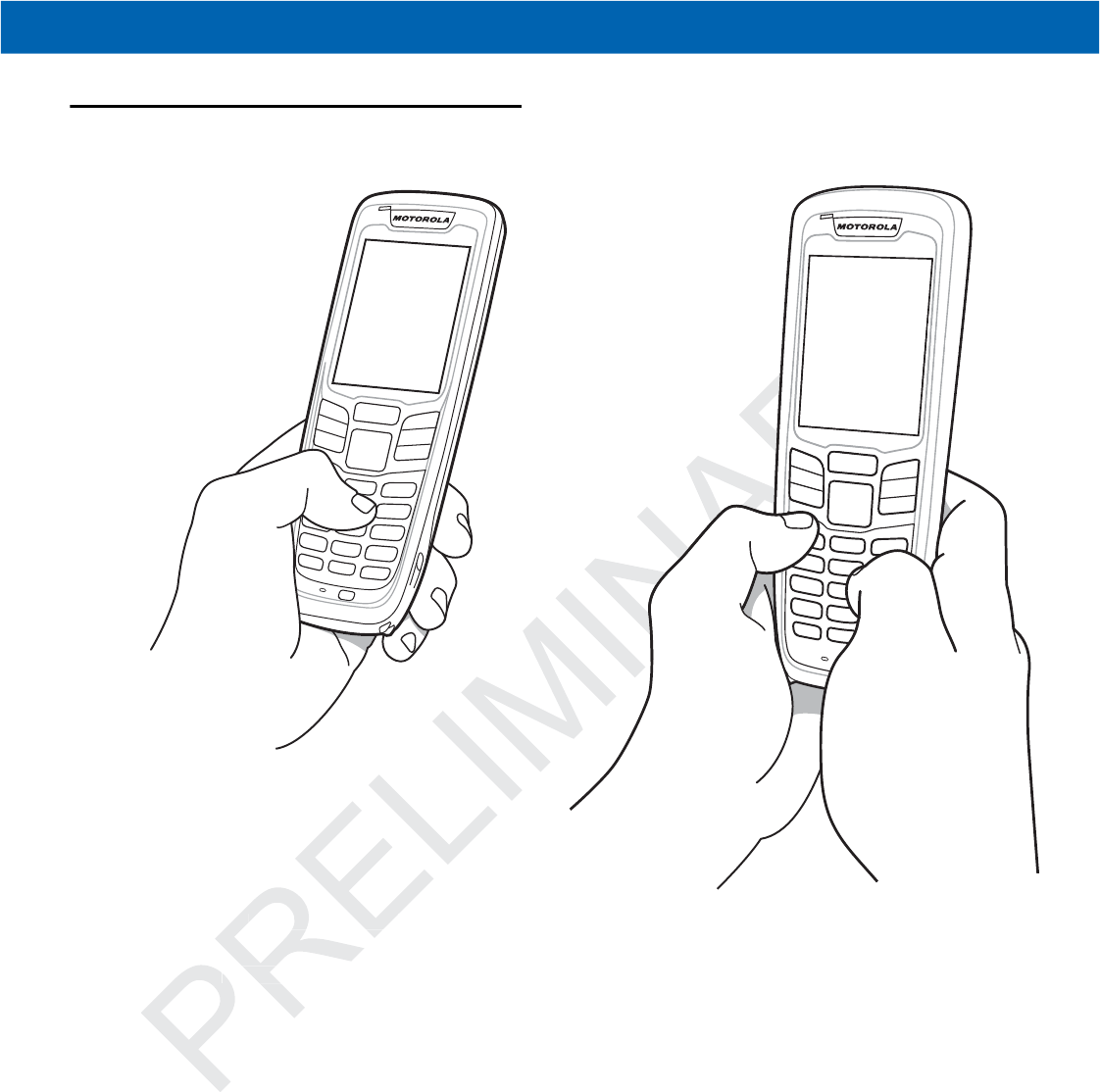
Operation 2 - 15
Using the Keypad
Figure 2-14
Entering Data on the Keypad
Single-hand Method Two-hand Method
re 2-14re 2-14
Entering DataEnter
ARY
ARY
ARY
ARY
AR
R
R
Y
ARY
A
AR
AR
A
AR
A
ARY
NA
NA
A
A
Single-hand Method
Single-hand Method
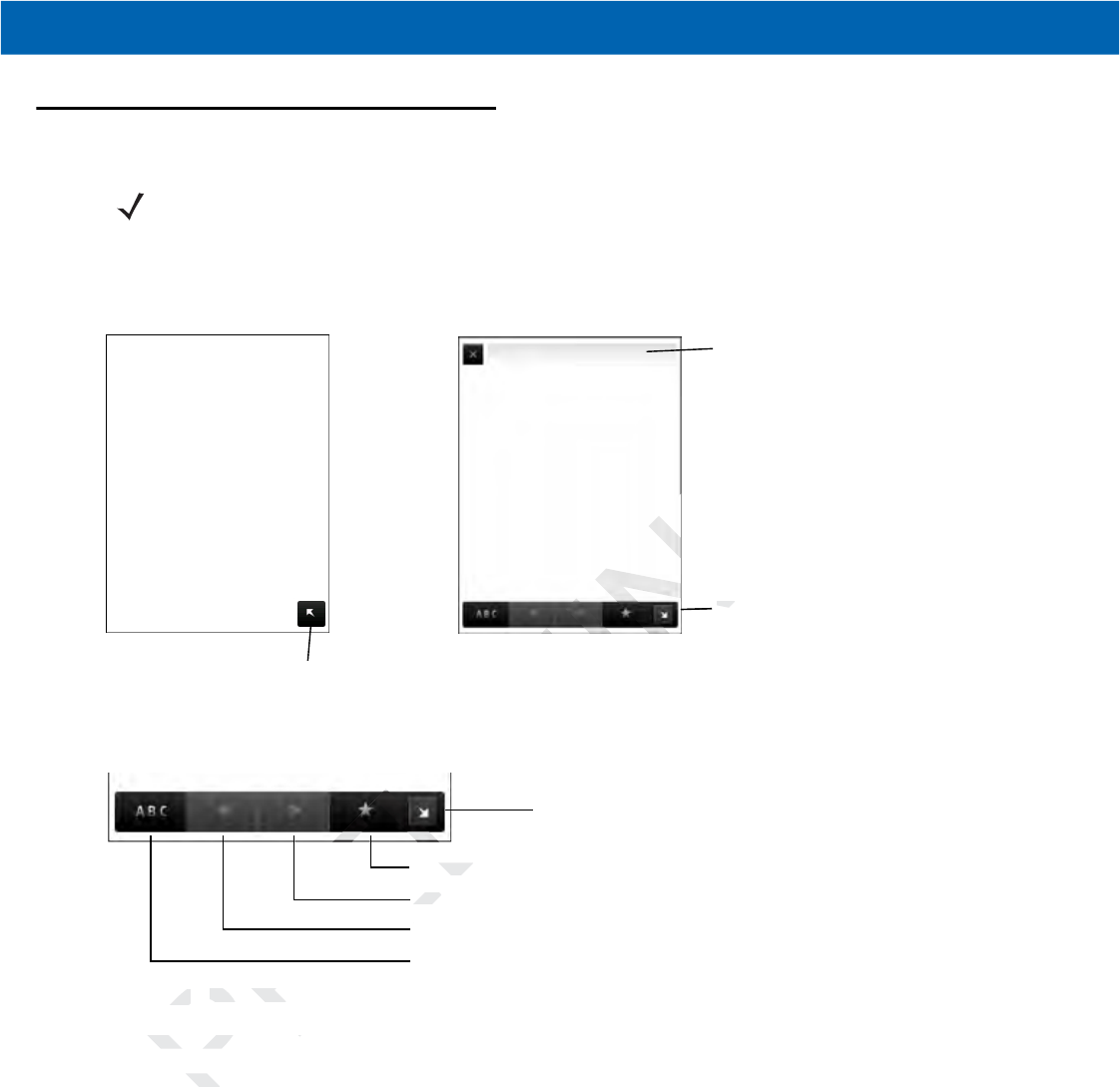
2 - 16 MC21XX Series User Guide
Browser
To use the browser:
Tap Start > Programs > Neon 1. The browser window appears.
Figure 2-15
Browser
Figure 2-16
Menu Bar
1. Enter an address into the Address Bar.
2. Press the Enter key. The web page loads.
NOTE MC2180 only.
Display Address and
Menu Bar
Address Bar
Menu Bar
Favorites
Forward
Back
History
Full screen
RELIMINARY
Me
Me
N
Favoritevorite
EL
ForwForw
B
B
E
RE
PRE
-16
-16
Menu Bar
Menu Bar
Enter an address inEnter an address in
s the s the
Ente
R
RE
R
LI

Operation
2
-
17
Installation
To install TEAM
Client:
1. Tap Start >Programs >TEAM Client
Configuration
.
2. Follow the on-screen
prompts.
3. Warm boot the
MC2180.
Group Broadcast Communication
Buttons
Group
Broadcast
Private
Response
Figure
2-17 MC2180 TEAM Express Button
Assignment
•Group Broadcast: Press and hold to start communicating with other voice client users or to make
a
Private
Response.
•Private Response: Press and hold to respond to the originator of the last
broadcast.

2 - 20 MC21XX Series User Guide
PRELIMINARY

CHAPTER 3 DATA CAPTURE
Introduction
The MC21XX provides three types of data capture options:
•
linear imager
•
1D laser scanner
•
2D imager (MC2180 only).
Linear Imager
The MC21XX with an integrated linear CCD imager has the following features:
•
Reading of a variety of bar code symbologies, including the most popular linear, postal and 1-D code
types.
•
Intuitive aiming for easy point-and-shoot operation.
1D Laser Scanner
The MC21XX with an integrated 1D laser scanner has the following features:
•
Reading of a variety of bar code symbologies, including the most popular linear, postal and 1-D code
types.
•
Intuitive aiming for easy point-and-shoot operation.
2D Imaging
The MC21XX with an integrated 2D imager has the following features:
•
Omnidirectional (360°) reading of a variety of bar code symbologies, including the most popular linear,
postal, PDF417, and 2D matrix code types.
•
The ability to capture and download images to a host for a variety of imaging applications.
•
Advanced intuitive laser aiming for easy point-and-shoot operation.
ARY
AR
re options:
e options:
tegrated linear CCD itegrated linear CCD i
variety of bar code sy
variety of bar code sy
ve aiming for easy poive aiming for easy poi
PR
er Scannerr Scanner
The MC21XX with anThe MC21XX with a
••
Reading ofRea
types.
type

3 - 2 MC21XX Series User Guide
The imager uses digital camera technology to take a digital picture of a bar code, stores the resulting image in
its memory, and executes state-of-the-art software decoding algorithms to extract the data from the image.
Operational Modes
The MC21XX with an integrated imager support three modes of operation, listed below. Activate each mode
pressing the Scan button.
•
Decode Mode: In this mode, the MC21XX attempts to locate and decode enabled bar codes within its
field of view. The imager remains in this mode as long as the scan button is pressed, or until it decodes a
bar code.
•
Pick List Mode: This mode allows selective bar code decoding when more than one bar code is in the
MC21XX’s field of view. To accomplish this, move the aiming crosshair center dot over the required bar
code to decode only that bar code. This feature is ideal for pick lists containing multiple bar codes and
manufacturing or transport labels containing more than one bar code type (either 1D or 2D).
•
Image Capture Mode: Use this mode to capture an image within the MC21XX’s field of view. This is
useful for capturing signatures or images of items like damaged boxes.
Scanning Considerations
Scanning consists of; aim, scan and decode. Scanning performance can be optimized by considering the
range and the scanning angle:
•
Range
Any scanning device decodes well over a particular working range (minimum and maximum distances
from the bar code). This range varies according to bar code density and scanning device optics.
Scanning within range brings quick and constant decodes; scanning too close or too far away prevents
decodes. Move the scanner closer and further away to find the right working range for the bar codes
being scanned. However, the situation is complicated by the availability of various integrated scanning
modules. The best way to specify the appropriate working range per bar code density is through a chart
called a decode zone for each scan module. A decode zone simply plots working range as a function of
minimum element widths of bar code symbols.
•
Angle
The scan angle is important for optimizing decode performance. When laser beams reflect directly back
into the scanner from the bar code, this specular reflection can “blind” the scanner.
To avoid this, scan the bar code so that the beam does not bounce directly back. But do not scan at too
sharp an angle; the scanner needs to collect scattered reflections from the scan to make a successful
decode. Practice quickly shows what tolerances to work within.
NOTE To enable Pick List Mode, tap Start > Programs > CtlPanel. Select Scanner Settings > Reader
Parameters. Enable Pick List mode. Pick List can also be set in an application using a API command.
NOTE Contact the Motorola Enterprise Mobility Support Center if chronic scanning difficulties develop. Decoding
of properly printed bar codes should be quick and effortless.
bar cod
r c
ed, or until it
r u
Scanner Settings
Scanner S
>
>
RELIMINARY
when more than one b
ore than one b
crosshair center dot o
rosshair center d
pick lists containing m
ists containing m
ne bar code type (eith
ne bar code type (eith
image within the MC2
image within the M
like damaged boxes.
ke damaged boxes.
code. Scanning perfor
de. Scanning perfor
ecodes well over a paecodes well over a pa
This range varies acco
This range varies acc
range brings quick anrange brings quick an
e the scanner closer a
he scanner closer a
ned. However, the situ
ned. However, the situ
. The best way to spe. The best way to spe
PR
a decode zone for ea
a decode zone for ea
nimum element widthsimum element widths
Angle
Ang
The scan angle iThe scan
to the scannto the
void thvoid
Rea
Re
n application using a AP
n application
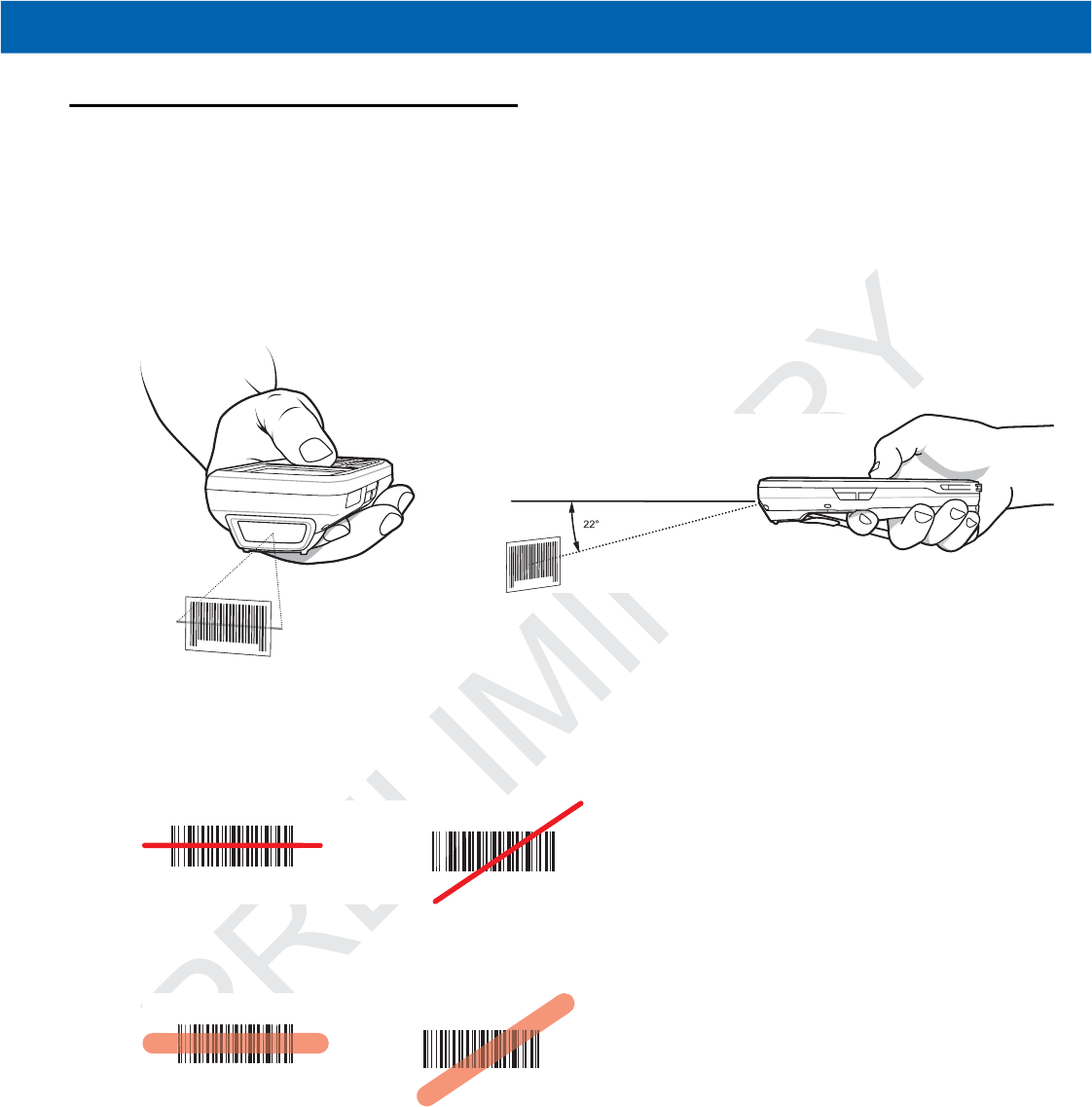
Data Capture 3 - 3
Laser Scanning and Linear Imaging
To scan bar codes with the MC21XX:
1. Ensure that the MC21XX is loaded with a scanning application. See DataWedge on page 3-5 for more
information.
2. If the MC21XX is equipped with a rotating head, adjust the head prior to scanning.
3. Aim the scan window at the bar code.
Figure 3-1
Data Capture
4. Press the scan button. Ensure the red scan beam covers the entire bar code. The LED Indicators
illuminate red to indicate that the beam is on. The LED Indicator turns green and a beep sounds to indicate
a successful decode.
Figure 3-2
Laser Aiming
Figure 3-3
Linear Aiming
Optimal scanning distance varies with bar code density and scanner optics.
•
Hold the scanner farther away for larger symbols.
•
Move the scanner closer for symbols with bars that are close together.
Correct Incorrect
Correct Incorrect
re the red scan beam
the red scan beam
hat the beam is on. Th
beam is on.
3-2
Laser Aiming
Laser Aiming
INARY
AR
AR
AR
AR
AR
A
A
A
A
A
A
NA
I
REL
R
R
R
RE
L
L
L
L
L
L
L
L
L
L
E
t
t
PR
P
P
P
P
P
P
P
P
P
P
P
P
P
P
P
P
P
P
P
P
P
P
P
P
P
P
P
P
P
P
P
P
P
P
P
P
P
P
P
P
P
P
P
P
P
P
P
P
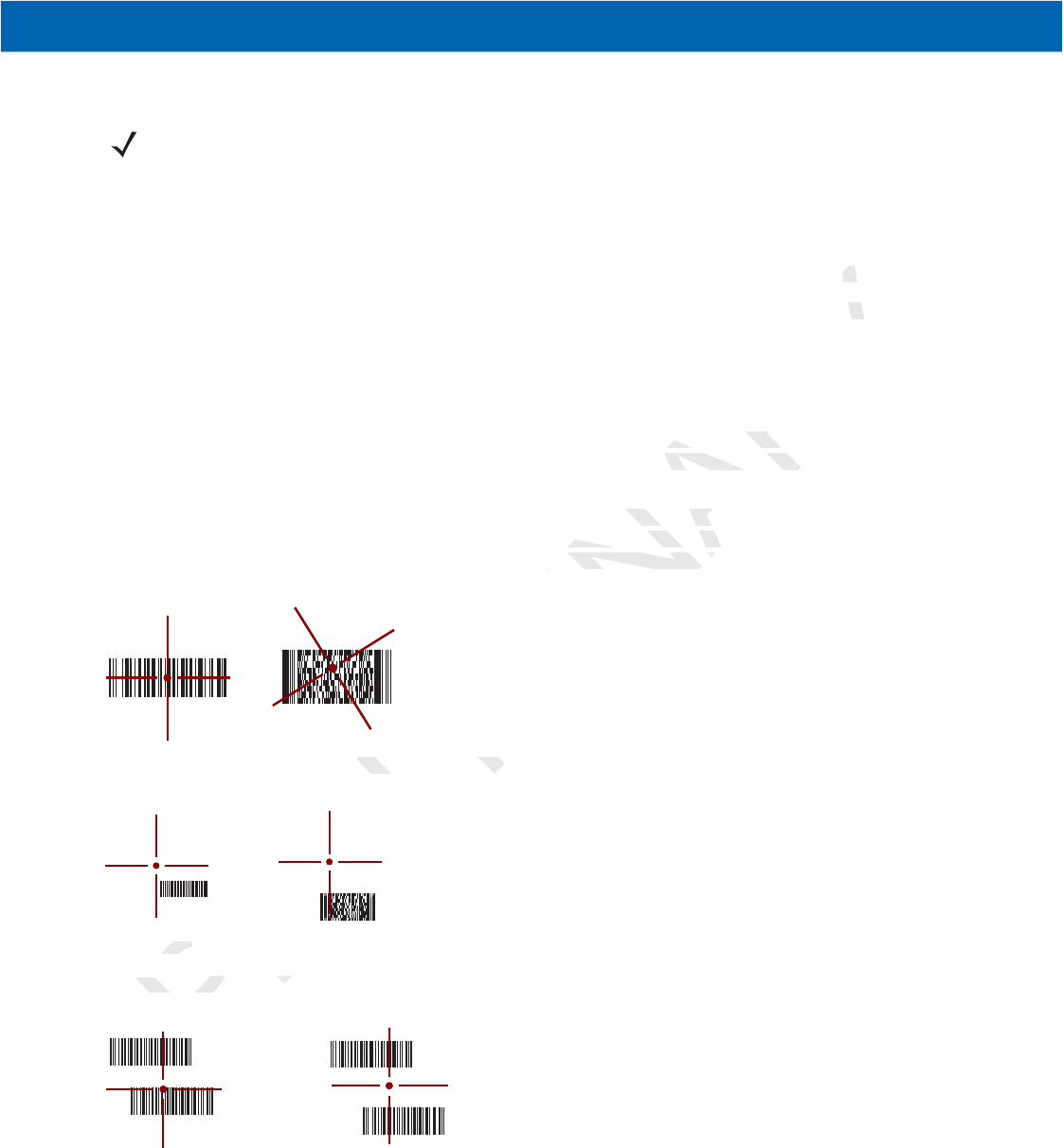
3 - 4 MC21XX Series User Guide
Imager Scanning
To read a bar code, a scan-enabled application is required. The MC21XX contains the DataWedge application
that allows the user to enable the scanner to decode bar code data and display the bar code content.
1. Ensure that a scan-enabled application is loaded on the MC21XX. See DataWedge on page 3-5 for more
information.
2. Aim the exit window at the bar code.
3. Press the scan button.
The red laser aiming pattern or aiming dot turns on to assist in aiming. Ensure the bar code is within the
area formed by the brackets in the aiming pattern or close to the aiming dot. The aiming dot is used for
increased visibility in bright lighting conditions.
The Scan/Decode LED lights red to indicate that scanning is in process, then lights green and a beep
sounds, by default, to indicate the bar code was decoded successfully. Note that when the MC2180 is in
Pick List Mode, the imager does not decode the bar code until the crosshair or aiming dot touches the bar
code.
Figure 3-4
Imager Aiming Pattern: Bar Code Centered
Figure 3-5
Imager Aiming Pattern: Bar Code Not Centered
Figure 3-6
Pick List Mode with Multiple Bar Codes in Aiming Pattern
4. Release the scan button.
NOTE Scanning procedures depend on the application and MC21XX configuration. An application may use
different scanning procedures from the one listed above.
Correct Incorrect
Decoded Not Decoded
PRELIMINARY
de co
e c
ge on page 3-5
ge on pag
ming. Ensure the bar c
ming. Ensure th
e aiming dot. The aim
aiming dot. The a
ng is in process, then
in process
ded successfully. Not
ded successfully. N
ar code until the cross
ar code until the cross
ttern: Bar Code Centeern: Bar Code Cent
re 3-5
re 3-5
Imager Aimin
Imager Aimin
L
rrectrrect
Incor
PREL
RE
RE
RE
RE
RE
RE
RE
RE
RE
RE
RE
RE
RE
RE
RE
RE
RE
E
E
E
E
E
E
E
E
E
E
E
E
RE
RE
RE
RE
RE
RE
RE
RE
RE
RE
RE
RE
RE
RE
RE
RE
RE
E
E
E
E
E
E
E
E
E
RE
RE
RE
RE
RE
RE
RE
RE
RE
RE
RE
RE
RE
RE
RE
RE
E
E
E
E
E
E
E
E
RE
RE
RE
RE
RE
RE
RE
RE
RE
RE
RE
RE
RE
RE
RE
RE
E
E
E
E
E
E
E
RE
RE
RE
RE
R
RE
RE
RE
RE
RE
RE
RE
RE
RE
RE
RE
RE
RE
E
E
E
E
E
E
R
R
R
R
R
R
R
R
R
R
R
R
R
R
R
R
R
R
R
R
R
R
R
R
R
R
R
R
R
R
R
R
R
R
R
R
R
R
R
R
R
R
R
R
R
R
R
R
R
R
R
R
R
R
R
R
R
R
R
R
R
R
R
R
R
R
R
RE
RE
R
RE
RE
RE
RE
RE
P
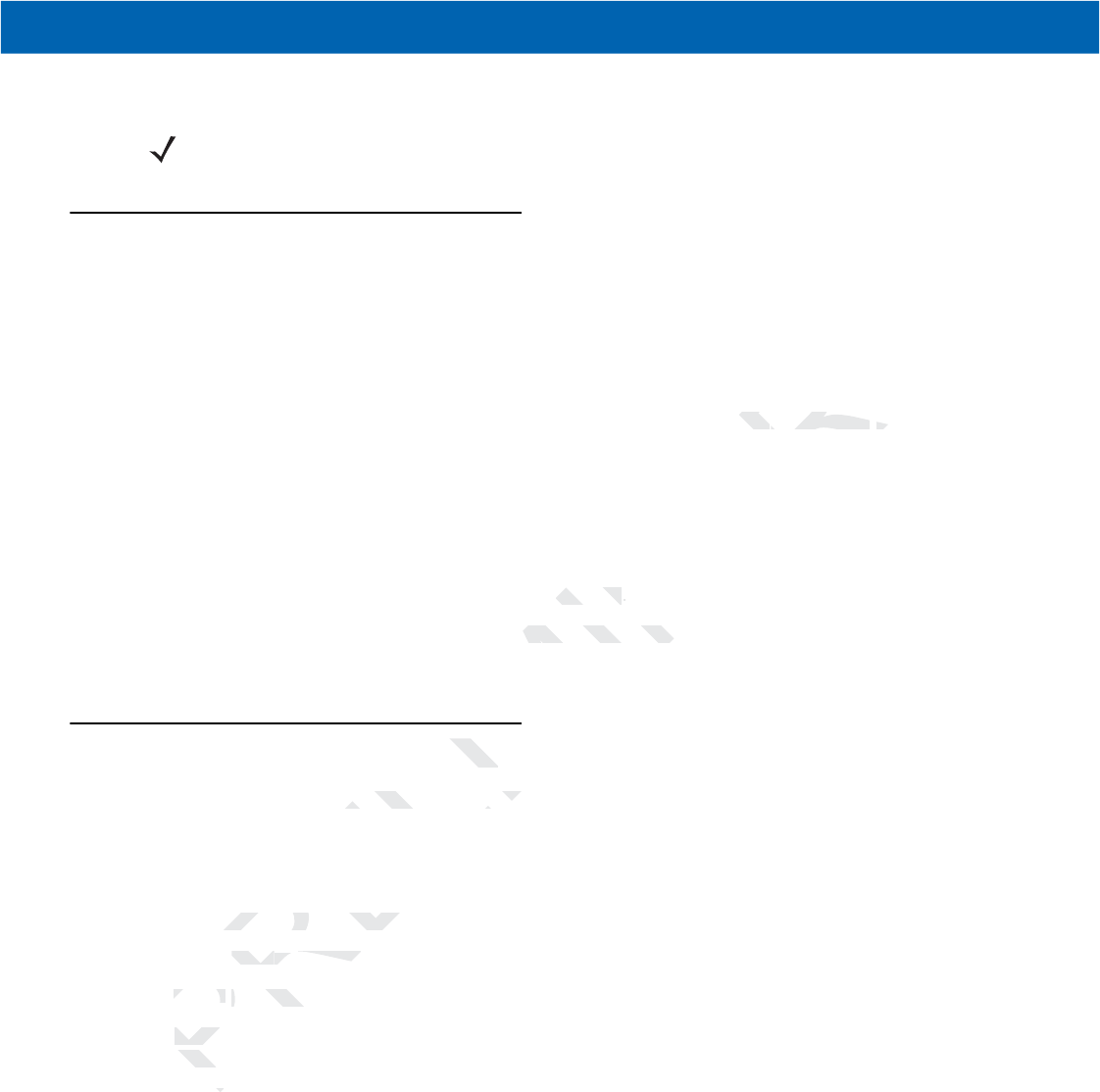
Data Capture 3 - 5
DataWedge
Enable DataWedge
To enable DataWedge:
1. Tap Start > Settings > Control Panel>DataWedge.
2. Tap Running to start the DataWedge process. The DataWedge Status changes to Ready.
3. Tap OK.
Disable DataWedge
To disable DataWedge:
1. Tap Start > Settings > Control Panel > DataWedge.
2. Tap the Running option to end the DataWedge process. The DataWedge Status changes to Stopped.
3. Tap OK.
Adjusting the Scan Beeper Volume
To volume level of the scan beep can be changed programmatically using APIs or using applications on the
MC21XX.
Using CtlPanel
To change the beep volume using the CtlPanel application:
1. Select Start > Programs > CtlPanel.
2. Select Audio Settings.
3. Use the navigation pad to change Beeper Volume. Select a value between 0 and 3 where 0 is the lowest
and 3 the highest.
4. Select OK.
5. Select Exit.
Using DataWedge
When using DataWedge, the beep volume can only be changed using the DataWedge setting.
1. Select Start > Settings > Control panel > DataWedge.
2. Select 3. Basic format.
3. Select 2. Keystroke output.
NOTE Imager decoding usually occurs instantaneously. The MC2180 repeats the steps required to take a digital
picture (image) of a poor or difficult bar code as long as the scan button remains pressed.
PRELIMINARY
Status
atus
changes to
changes to
Rea
R
taWedge
aWedge
.
.
Wedge process. The
Wedge process. The
IM
er Volume
ume
can beep can be chancan beep can be chan
e the beep volume use the beep volume us
elect
StartStart
P
> >
ProgramProgram
..
SelectSelect
Audio SettAudio Se
Use the navigUse th
and 3 the hand 3
ctct

3 - 6 MC21XX Series User Guide
4. Select 5. Feedback.
5. Select 2. On Send.
6. Select 1. Beeper.
7. Select 4. Volume.
8. Enter a value between 0 and 3 where 0 is the lowest and 3 the highest.
9. Select Save.
PRELIMINARY

Chapter 4 Bluetooth
Introduction
Bluetooth-equipped devices can communicate without wires, using frequency-hopping spread spectrum
(FHSS) radio frequency (RF) to transmit and receive data in the 2.4 GHz Industry Scientific and Medical (ISM)
band (802.15.1). Bluetooth wireless technology is specifically designed for short-range (10 meters /30 feet)
communication and low power consumption.
MC2180s with Bluetooth capabilities can exchange information (e.g., files, appointments, and tasks) with other
Bluetooth enabled devices such as phones, printers, access points, and other mobile computers. To use the
MC2180 as a modem, create a dial-up modem connection between a computer and MC2180.
The MC2180 with Bluetooth technology uses the Microsoft Bluetooth stack.
Adaptive Frequency Hopping
Adaptive Frequency Hopping (AFH) is a method of avoiding fixed frequency interferers, and can be used with
Bluetooth voice. All devices in the piconet (Bluetooth network) must be AFH-capable in order for AFH to work.
There is no AFH when connecting and discovering devices. Avoid making Bluetooth connections and
discoveries during critical 802.11b communications. AFH for Bluetooth consists of four main sections:
•
Channel Classification - A method of detecting an interference on a channel-by-channel basis, or
pre-defined channel mask.
•
Link Management - Coordinates and distributes the AFH information to the rest of the Bluetooth network.
•
Hop Sequence Modification - Avoids interference by selectively reducing the number of hopping
channels.
•
Channel Maintenance - A method for periodically re-evaluating the channels.
When AFH is enabled, the Bluetooth radio “hops around” (instead of through) the 802.11b high-rate channels.
AFH coexistence allows Motorola mobile computers to operate in any infrastructure.
NOTE MC2180 only.
PRELIMINAR
ARY
AR
municate without wires
municate without wires
nsmit and receive data
nsmit and receive data
ess technology is spe
s technology is spe
r consumption.
mption.
capabilities can exchapabilities can exch
ices such as phones, ices such as phones
m, create a dial-up mo
m, create a dial-up mo
ith Bluetooth technoloBluetooth techno
RE
Frequency HopFrequency Hop
Adaptive Frequency HAdaptive Frequency
P
Bluetooth voice. AlBluetooth voice. Al
ere is no AFHere is
P
veries dveries
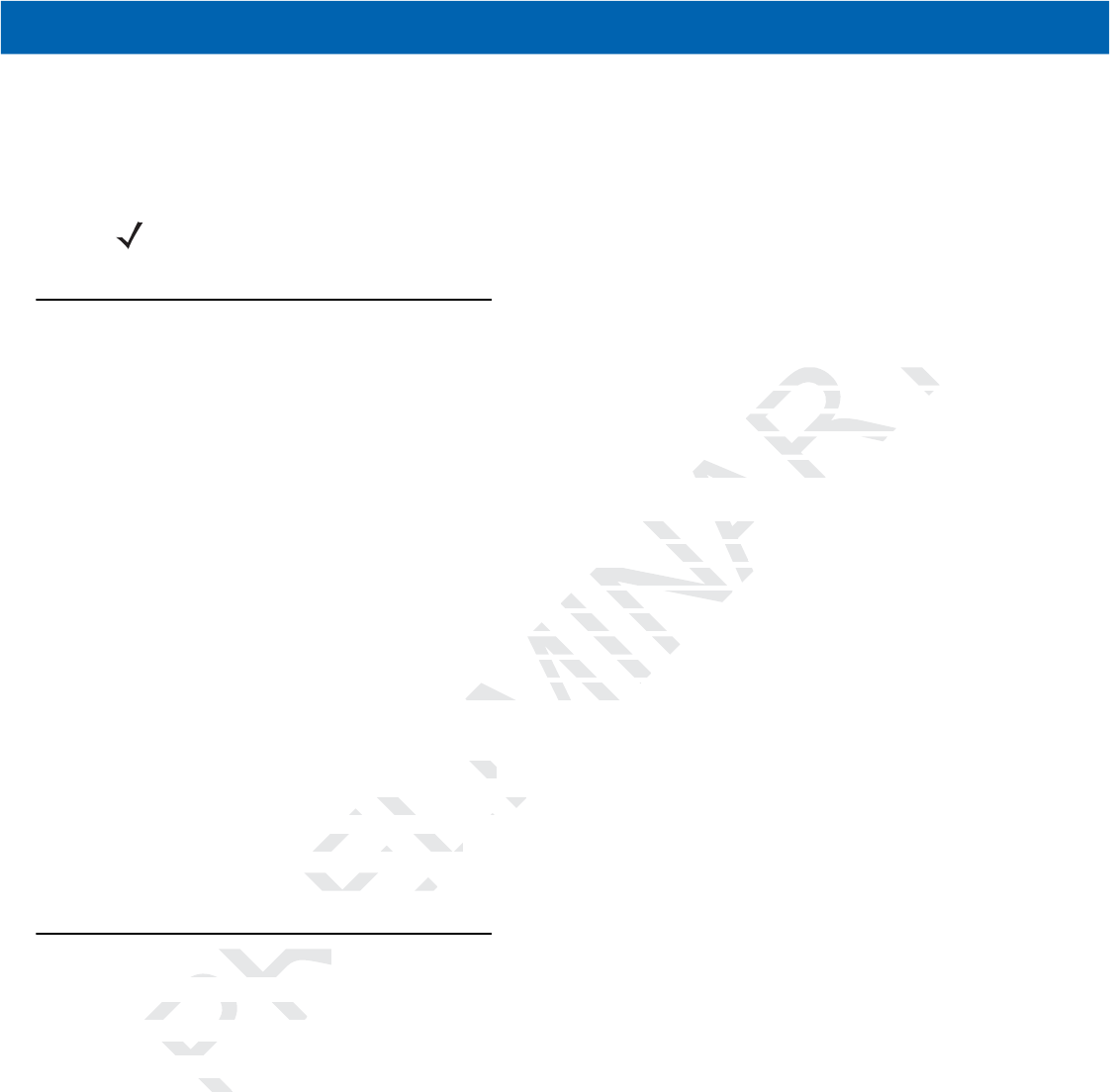
4 - 2 MC21XX Series User Guide
The Bluetooth radio in this MC2180 operates as a Class 2 device power class. The maximum output power is
2.5mW and the expected range is 32.8 feet (10 meters). A definition of ranges based on power class is difficult
to obtain due to power and device differences, and whether one measures open space or closed office space.
Security
The current Bluetooth specification defines security at the link level. Application-level security is not specified.
This allows application developers to define security mechanisms tailored to their specific need. Link-level
security occurs between devices, not users, while application-level security can be implemented on a per-user
basis. The Bluetooth specification defines security algorithms and procedures needed to authenticate devices,
and if needed, encrypt the data flowing on the link between the devices. Device authentication is a mandatory
feature of Bluetooth while link encryption is optional.
Pairing of Bluetooth devices is accomplished by creating an initialization key that is used to authenticate the
devices and create a link key for them. Entering a common PIN number in the devices being paired generates
the initialization key. The PIN number is never sent over the air. By default, the Bluetooth stack responds with
no key when a key is requested (it is up to user to respond to the key request event). Authentication of
Bluetooth devices is based-upon a challenge-response transaction. Bluetooth allows for a PIN number or
passkey that is used to create other 128-bit keys used for security and encryption. The encryption key is
derived from the link key used to authenticate the pairing devices. Also worthy of note is the limited range and
fast frequency hopping of the Bluetooth radios that makes long-distance eavesdropping difficult.
Recommendations are:
•
Perform pairing in a secure environment
•
Keep PIN codes private and don't store the PIN codes in the mobile computer
•
Implement application-level security.
The Microsoft stack supports Smart-pairing. For detailed information, refer to the Microsoft MSDN.
Bluetooth Configuration
The services supported by the Microsoft Bluetooth stack:
•
Generic Access Profile
•
Serial Port Service
•
Service Discovery Access Profile
•
Dial-Up Networking Profile (Client)
COM5 and COM9 ports are available for the Microsoft Bluetooth stack.
NOTE It is not recommended to perform Bluetooth wireless technology inquiry when high rate 802.11b
operation is required.
ELIMINARY
-level security is not s
-level security is no
their specific need. Li
their specific need. Li
y can be implemented
can be implemente
edures needed to auth
needed to auth
ces. Device authentica
es. Device authe
nitialization key that is
ialization key
PIN number in the de
mber in th
r the air. By default, th
the air. By default, th
spond to the key requ
pond to the key requ
onse transaction. Blueonse transaction
s used for security anused for security a
e the pairing devices.
airing devices
dios that makes long-
dios that makes long-
environmentent
e and don't store the
e and don't store the
PRE
tion-level security.tion-level security.
supports Smart-pairin
pports Smart-pai
RE
onfiguration
onfiguration
services supported by
services supported
Generic AccessGeneric
al Port al Po
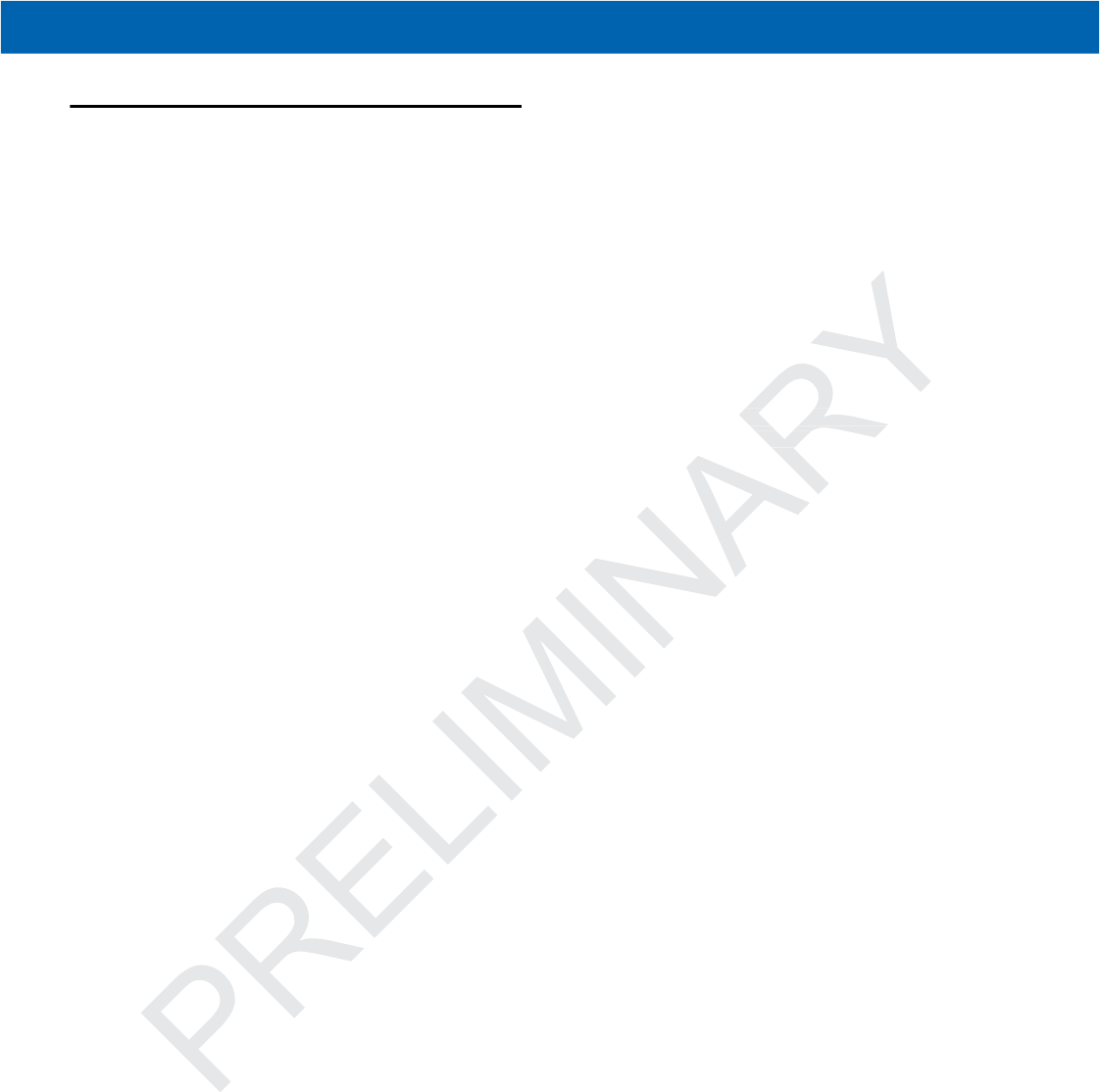
Bluetooth 4 - 3
Bluetooth Power States
Cold Boot
Performing a cold boot turns off the state of the Bluetooth radio.
Warm Boot
Performing a warm boot turns off the state of the Bluetooth radio.
Suspend
When there is an active Bluetooth connection, the Bluetooth radio goes into low power mode maintaining the
active connection. When there is no active connection, the Bluetooth radio turns off.
Resume
When the MC2180 resumes, the user must re-connect to the Bluetooth device.
s into low power mod
into low power mo
h radio turns off.
o turns
t to the Bluetooth dev
Bluetooth d
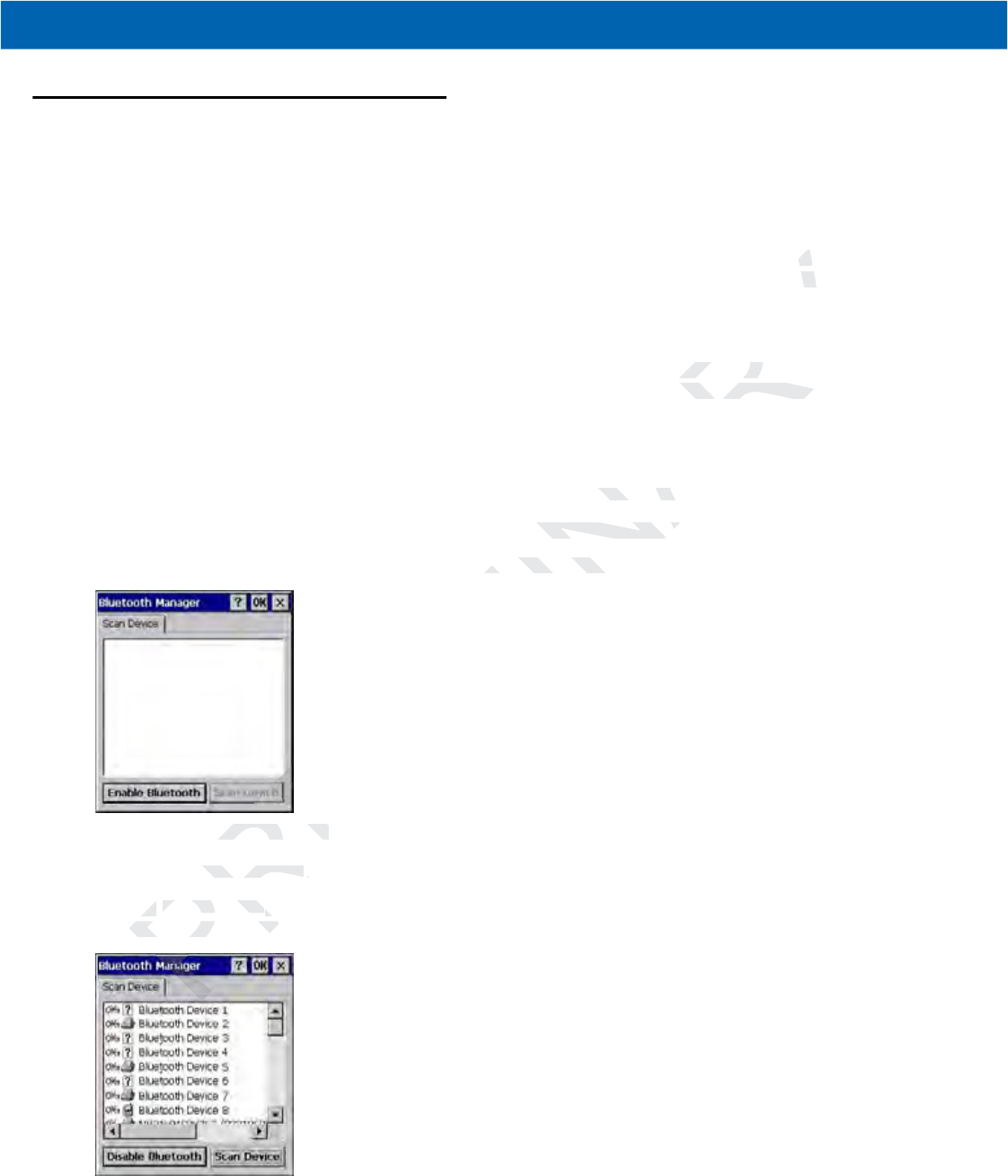
4 - 4 MC21XX Series User Guide
Using Microsoft Bluetooth Stack
The following sections provide information on using the Microsoft Bluetooth stack.
Power Modes
The Bluetooth radio switches between normal and low power modes automatically. When data transfer is
required, the radio goes into normal mode. When there is no activity, the radio goes into low power mode.
Discovering Bluetooth Device(s)
The MC2180 can receive information from discovered devices without bonding. However, once bonded, the
MC2180 and a bonded device exchange information automatically when you turn the Bluetooth radio on.
To find Bluetooth devices in the area:
1. Ensure that Bluetooth is enabled on the device.
2. Ensure that the Bluetooth device to discover is in discoverable and connectable modes.
3. Ensure that the two devices are within 10 meters (30 feet) of one another.
4. Tap Start > Settings > Control Panel >Bluetooth Device Properties icon.
Figure 4-1
Bluetooth Manager
5. Tap Enable Bluetooth.
6. Tap Scan Device button. The MC2180 begins searching for discoverable Bluetooth devices in the area.
Discovered devices appear in the list.
Figure 4-2
Searching for Bluetooth Devices
7. Double tap a device from the list.
PRELIMINARY
data
dat
o low powe
w p
ing. However, once b
ing. Howev
you turn the Bluetoot
u turn the Bluetoo
verable and connecta
e and conn
30 feet) of one anothe
30 feet) of one anothe
tooth Device Propertooth Device Pr
tooth Manager
tooth Manager
nable Bluetoothble Bluetooth
..
apap
Scan DeviceScan Device
butto b
Discovered devices Discovered devices
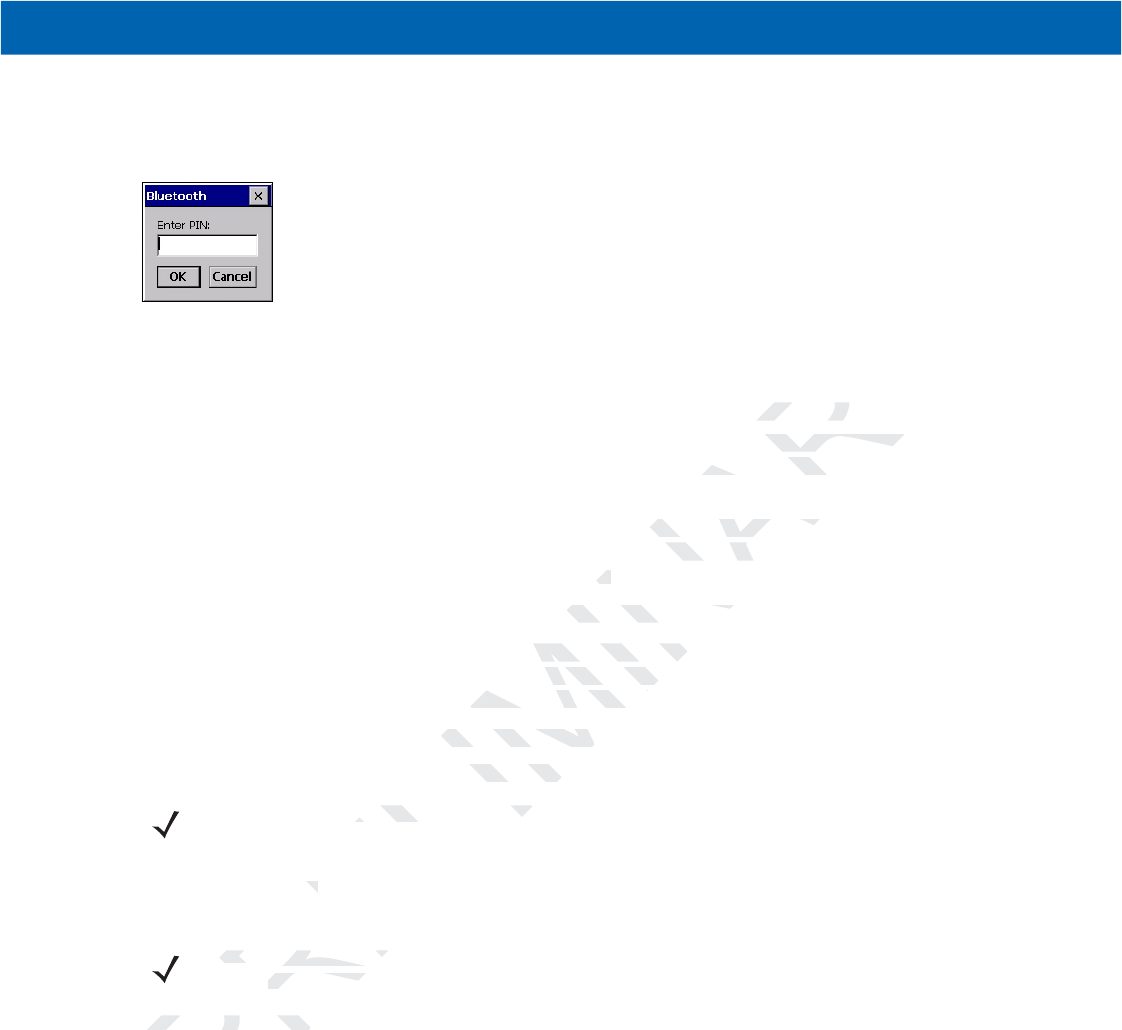
Bluetooth 4 - 5
8. Select Trusted. A dialog box appears.
9. Tap Yes. The Bluetooth window appears.
Figure 4-3
Enter PIN
10. Enter a PIN and then tap OK.
11. Enter the PIN on the other device. The device in the list become trusted (key icon).
You are prompted to enter a PIN. If the device has a specific PIN, enter it in the PIN field and tap Next. If
the device does not have a specific passcode, enter one in the Passcode field and tap Next. The Bluetooth
radio tries to connect with the device.
12. If you created a passcode, you will be prompted by the other device to enter the same passcode. Enter the
created passcode to establish a paired connection. (If you entered a passcode from the device, you
shouldn’t have to do anything on the other device.)
13. When the connection is complete, a list of matching and supported services on the device appears.
14. Select the services you want to use and tap Finish. The services on the new devices have to be selected
or else the pairing won’t include those services, even though the devices are paired. If services are not
selected, you will be continually re-prompted for the passcode from the device.
15. The device appears in the list on the main window.
After the passcodes have been accepted on both sides, you have a trusted (“paired”) connection.
Available Services
The MC2180 with Microsoft Bluetooth stack offers the Serial Port service and DUN Client service.
NOTE Some devices might not require a PIN. This depends upon the device’s authentication.
NOTE In order to connect to the Bluetooth device, the application must create the connection to the remote
device. Please refer to the MSDN Help for detailed information.
PRELIMINARY
sted (key icon).
sted (key ic
N, enter it in the PIN f
nter it in the PIN f
e Passcode field and t
e Passcode field
other device to enter
other device to enter
(If you entered a pas
u entered a
e.)
e.)
matching and supporte
tching and supporte
d tap Finish. The serv
ap Finish. The serv
e services, even thou
ices, even tho
e-prompted for the pas-prompted for the pas
on the main window.on the main window
been accepted on boccepted on
ices
s
The MC2180 with Mic
The MC2180 with M
ces might not require a ces might not require a
NOTENOTE
In order to connorder to conn
device. Pleasdevice. Pleas

4 - 6 MC21XX Series User Guide
PRELIMINARY
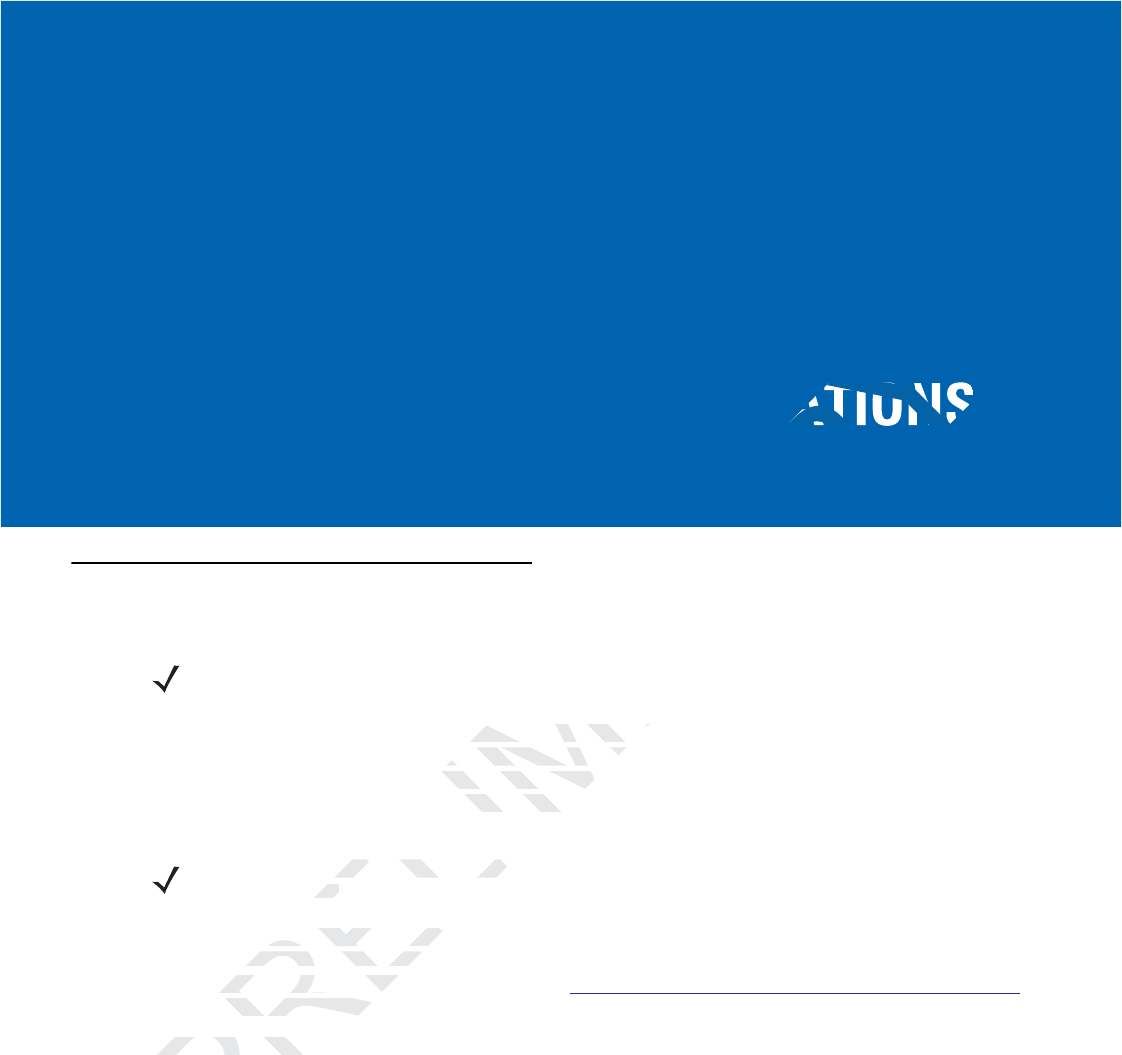
CHAPTER 5 WIRELESS APPLICATIONS
Introduction
Wireless Local Area Networks (LANs) allow mobile computers to communicate wirelessly and send captured
data to a host device in real time. Before using the MC21XX on a WLAN, the facility must be set up with the
required hardware to run the wireless LAN and the MC21XX must be configured. Refer to the documentation
provided with the access points (APs) for instructions on setting up the hardware.
To configure the MC21XX, a set of wireless applications provide the tools to configure and test the wireless
radio in the MC21XX. Refer to the Wireless Fusion Enterprise Mobility Suite User Guide for Version X1.00 for
information on configuring wireless profiles. Go to http://www.motorola.com/enterprisemobility/manuals for the
latest version of this guide. See Software Versions on page ii to determine the Fusion version on the MC21XX.
Tap the Signal Strength icon to display the Wireless Launcher menu.
NOTE MC2180 only.
NOTE 802.11d is enabled by default. When enabled, the AP must be configured the same in order to
connect.
PRELIMINAR
ARY
AR
CATIONS
allow mobile compute
allow mobile compute
efore using the MC21
efore using the MC21
eless LAN and the MC
ess LAN and the M
ts (APs) for instruction
) for instruct
he MC21XX, a set of whe MC21XX, a set of
MC21XX. Refer to th
MC21XX. Refer to th
on on configuring wireon on configuring wire
version of this guide.
sion of this guide.
ap the
ap th
Signal Streng
Signal Str
d is enabled by defauld is enabled by defau
ect.
ect.
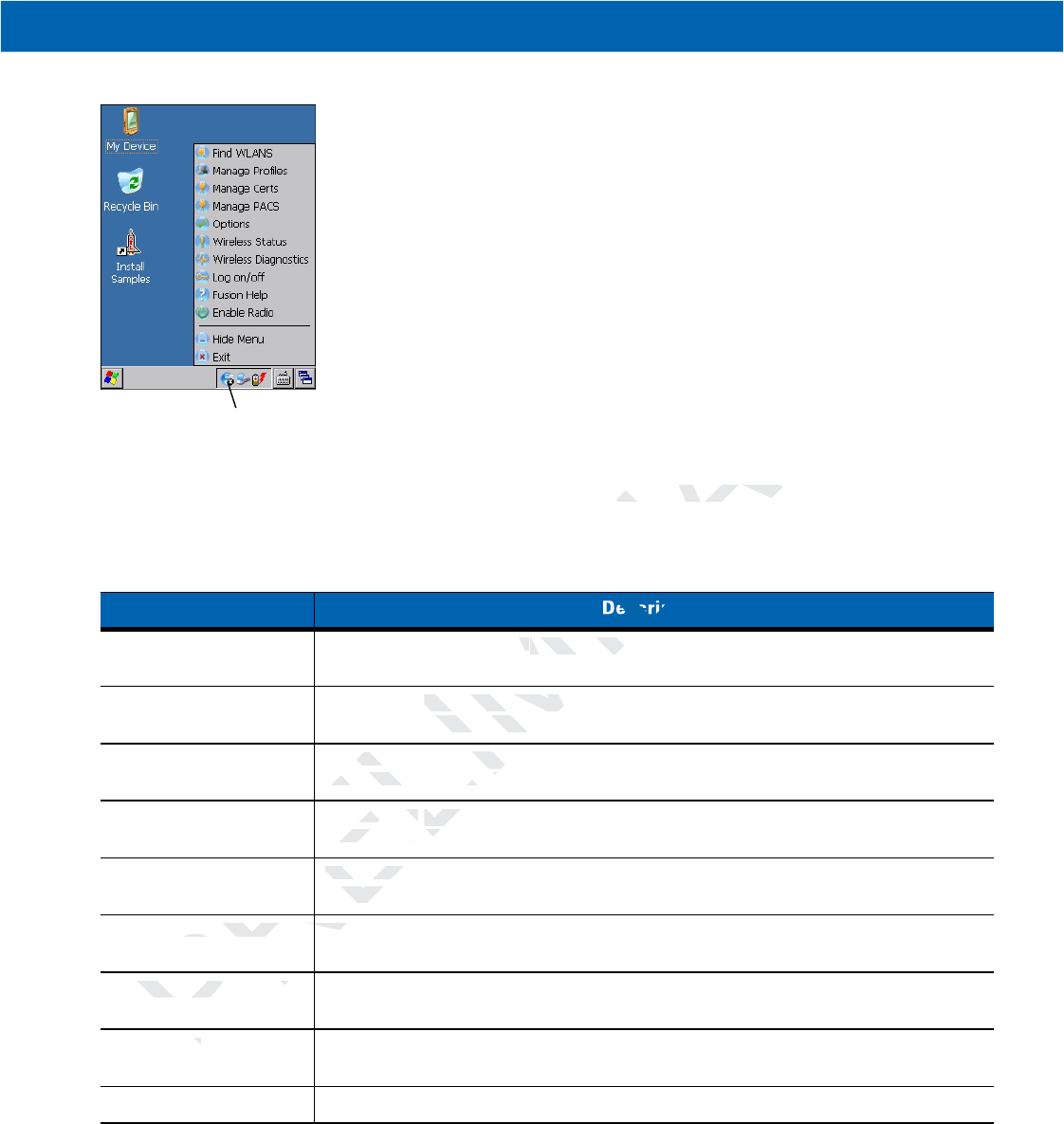
5 - 2 MC21XX Series Integrator Guide
Figure 5-1
Wireless Launcher Menu
Many of the items in the menu invoke one of the Fusion applications. These menu items and their
corresponding applications are summarized in Table 5-1.
Additional Wireless Launcher menu entries include:
•
Enable/Disable Radio
•
Hide Menu
•
Exit.
Table 5-1
Supported Applications
Application Description
Find WLANs Invokes the Find WLANs application which displays a list of the WLANs available
in your area.
Manage Profiles Invokes the Manage Profiles application (which includes the Profile Editor
Wizard) to manage and edit your list of WLAN profiles.
Manage Certs Invokes the Certificate Manager application which allows you to manage
certificates used for authentication.
Manage PACs Invokes the PAC Manager application which helps you manage the list of
Protected Access Credentials used with EAP-FAST authentication.
Options Invokes the Options application which allows you to configure the Fusion option
settings.
Wireless Status Invokes the Wireless Status application which allows you to view the status of the
current wireless connection.
Wireless Diagnostics Invokes the Wireless Diagnostics application which provides tools with which to
diagnose problems with the wireless connection.
Log On/Off Invokes the Network Login dialog which allows you to log on to a particular profile
or to log off from the currently active profile.
Fusion Help Invokes Fusion Help application which provides on-device Fusion Help.
Signal Strength Icon
INARY
ations. These menu ite
ations. These menu it
MIN
escr
MI
WLANs
s
application w
application
LIM
he
Manage Profiles
Manage Profiles
a
) to manage and edit anage and edit
ELIM
okes the okes
Certificate ficate
certificates used for a
certificates used for a
REL
Invokes the
kes the
PAC
PAC
Protected Accerotected Acce
RE
RE
Invokes thInvokes th
settingsettings
RE
PR
s Status InvStatus Inv
R
PR
reless Diagnosticsreless Diagnostics
IN
MIN
M
LIM
EL
RE
R
PR
P
ffff
P
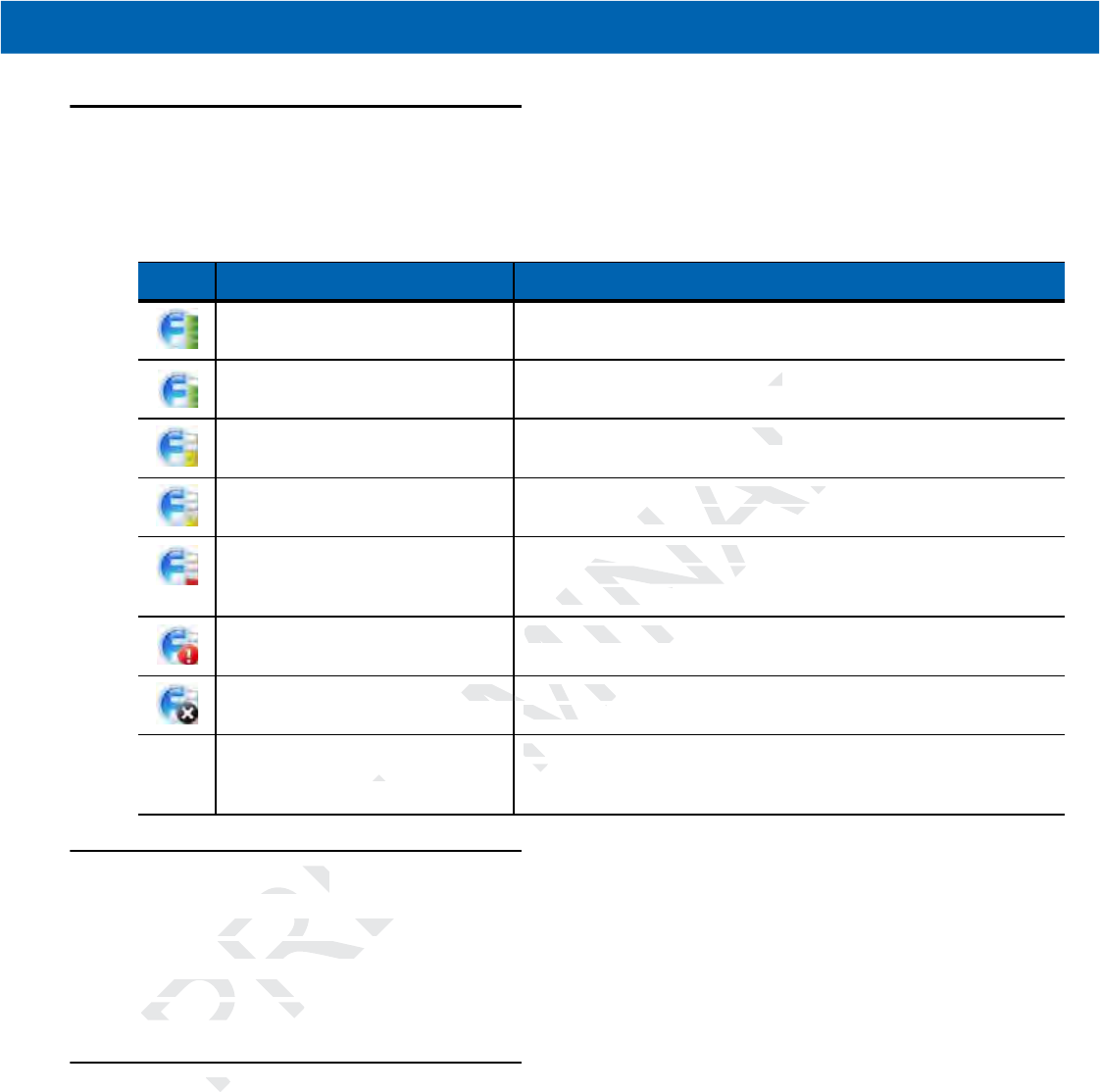
Wireless Applications 5 - 3
Signal Strength Icon
The Signal Strength icon in the task tray indicates the mobile computer’s wireless signal strength as follows:
Turning Off the Radio
To turn off the WLAN radio tap the Signal Strength icon on the task tray and select Disable Radio. A red X
appears across the icon indicating that the radio is disabled (off).
To turn the radio back on, tap the Signal Strength icon on the task tray and select Enable Radio. The red X
disappears from the icon indicating that the radio is enabled (on).
Minimum Setup
Below is a list of the minimum effort to achieve a wireless connection. Note that there are many discrete
nuances that may affect the performance of your wireless connection that might be missed if you do not
consider them carefully.
You will need to create a profile. It is recommended that you read the profile editor chapter.
1. Find out from your IT administrator what the connection settings should be (Extended Service Set Identifier
(ESSID), Enterprise or Personal, authentication type, tunnel type, certificate requirements,
Protected
Access Credentials
(PAC) requirements). Note that not all of the items listed may be relevant.
2. Create the profile using the information provided by the IT administrator.
Table 5-2
Signal Strength Icons Descriptions
Icon Status Action
Excellent signal strength WLAN network is ready to use.
Very good signal strength WLAN network is ready to use.
Good signal strength WLAN network is ready to use.
Fair signal strength WLAN network is ready to use. Notify the network administrator
that the signal strength is only “Fair”.
Poor signal strength WLAN network is ready to use. Performance may not be
optimum. Notify the network administrator that the signal
strength is “Poor”.
Out-of-network range (not
associated)
No WLAN network connection. Notify the network administrator.
The WLAN radio is disabled. The WLAN radio is disabled. To enable, choose Enable Radio
from the Wireless Applications menu.
None The Wireless Launcher
application was exited.
The Wireless Launcher application has been closed. See the
Fusion Functions paragraphs below for how to restart the
Wireless Launcher.
Y
RY
se.
se.
ARY
dy to use.
use.
NAR
is ready to use. Notify
ady to use. Notify
al strength is only “Fa
l strength is only “Fa
INA
network is ready to us
network is ready to
um. Notify the networ
m. Notify the networ
ength is “Poor”.
ngth is “Poor”.
MIN
No WLAN network c
No WLAN network
M
IMI
d. The WLAN ra
. The WLAN
from the
from th
W
W
IM
ELIM
her
xited.xit
The
Th
W
FusFus
W
IM
Y
RY
RY
AR
NA
MIN
MI
IM
PREL
EL
Radio
Radio
ff the WLAN radio tapff the WLAN radio tap
rs across the icon indacross the icon ind
o turn the radio back oo turn the radio b
disappears from the
disappears from the
P
SetSet
EL

5 - 4 MC21XX Series Integrator Guide
3. Enter the Manage Profile screen, select the profile (press and hold), and select the Connect option in the
context menu that appears.
PRELIMINARY
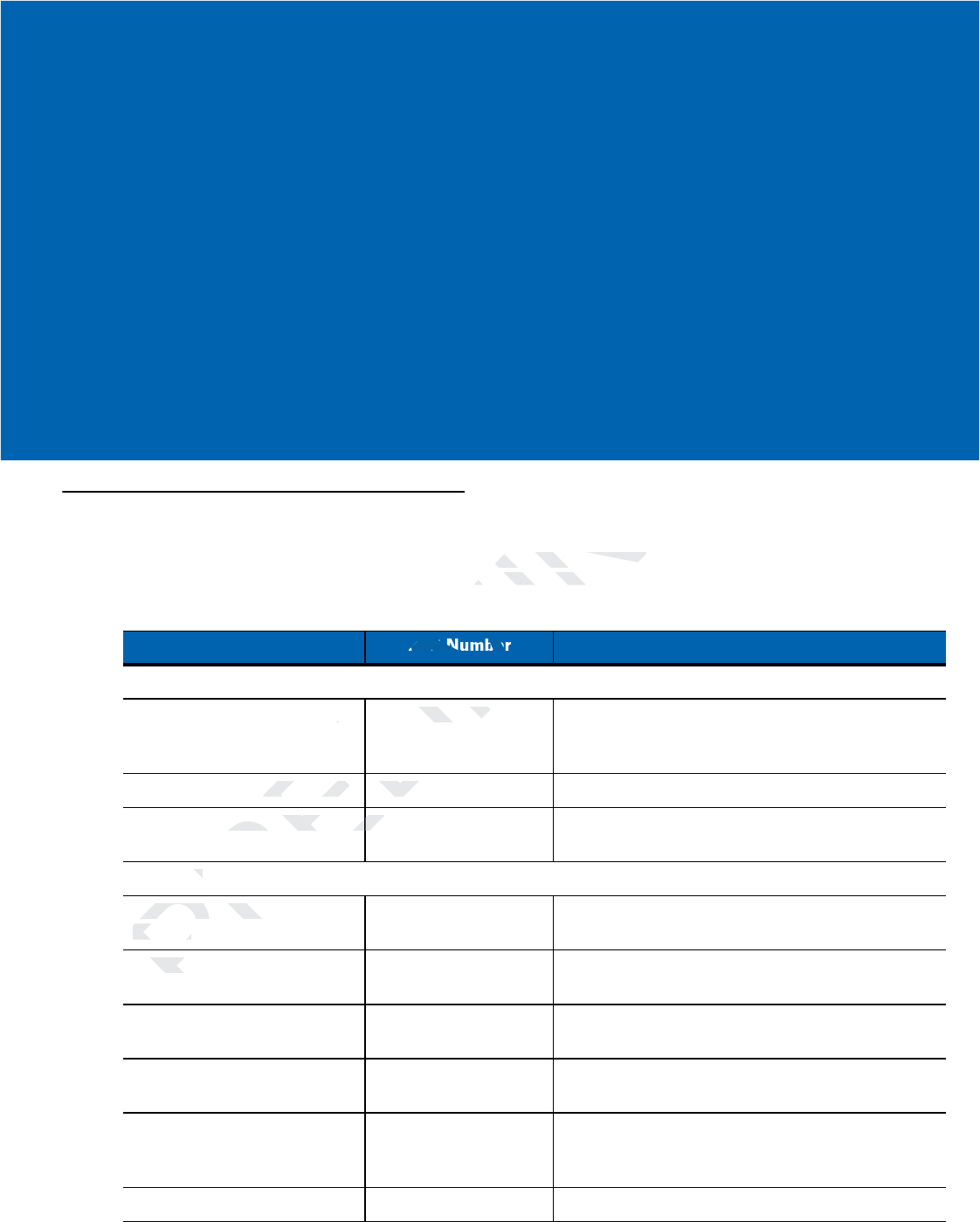
Chapter 6 Accessories
Introduction
The MC21XX accessories provide a variety of product support capabilities. Accessories include cradles,
cables and spare battery chargers. Table 6-1 lists the MC21XX accessories.
Table 6-1
MC21XX Accessories
Accessory Part Number Description
Cradles
Single-slot USB Cradle CRD2100-1000UR Charges the MC21XX main battery and
synchronizes the MC21XX with a host computer
through a USB connection.
Four-slot Charge Only Cradle CRD2100-4000CR Charges up to four MC21XXs.
Four-slot Ethernet Cradle CRD2100-4000ER Charges up to four MC21XXs and connects to the
MC21XX with an Ethernet network.
Charging
Four-slot Spare Battery
Charger
SAC2100-4000CR Charges up to four MC21XX spare batteries.
Power Supply PWRS-14000-249R Provides power to the MC21XX, Single-slot USB
Cradle and the USB ActiveSync/Charge cable.
Power Supply PWRS-14000-148R Provides power to the Four-slot Charge Only Cradle
and the Four-slot Ethernet cradle.
Power Supply PWRS-14000-241R Provides power to the Four-slot Spare Battery
Charger.
DC Line Cord 50-16002-042R Provides power from the power supply to the
Four-slot Ethernet cradle or Four-slot Charge Only
cradle.
US AC Line Cord 50-16000-182R Provides power to the 2-wire power supply.
PRELIMINAR
ARY
AR
oduct support capabil
oduct support capabil
sts the MC21XX accests the MC21XX
MI
Part Numbe
I
CRD2100-1000UCRD2100-1000U
Only Cradle CRD2
Only Cradle CRD2
ernet Cradle C
ernet Cradle C
gingg
EL
I
MI
IM
LIM
EL
RE
RE
PR
Four-slot Spare BatteryFour-slot Spare Ba
Charger
Charger
P
ower Supplyower S
PR
P
P
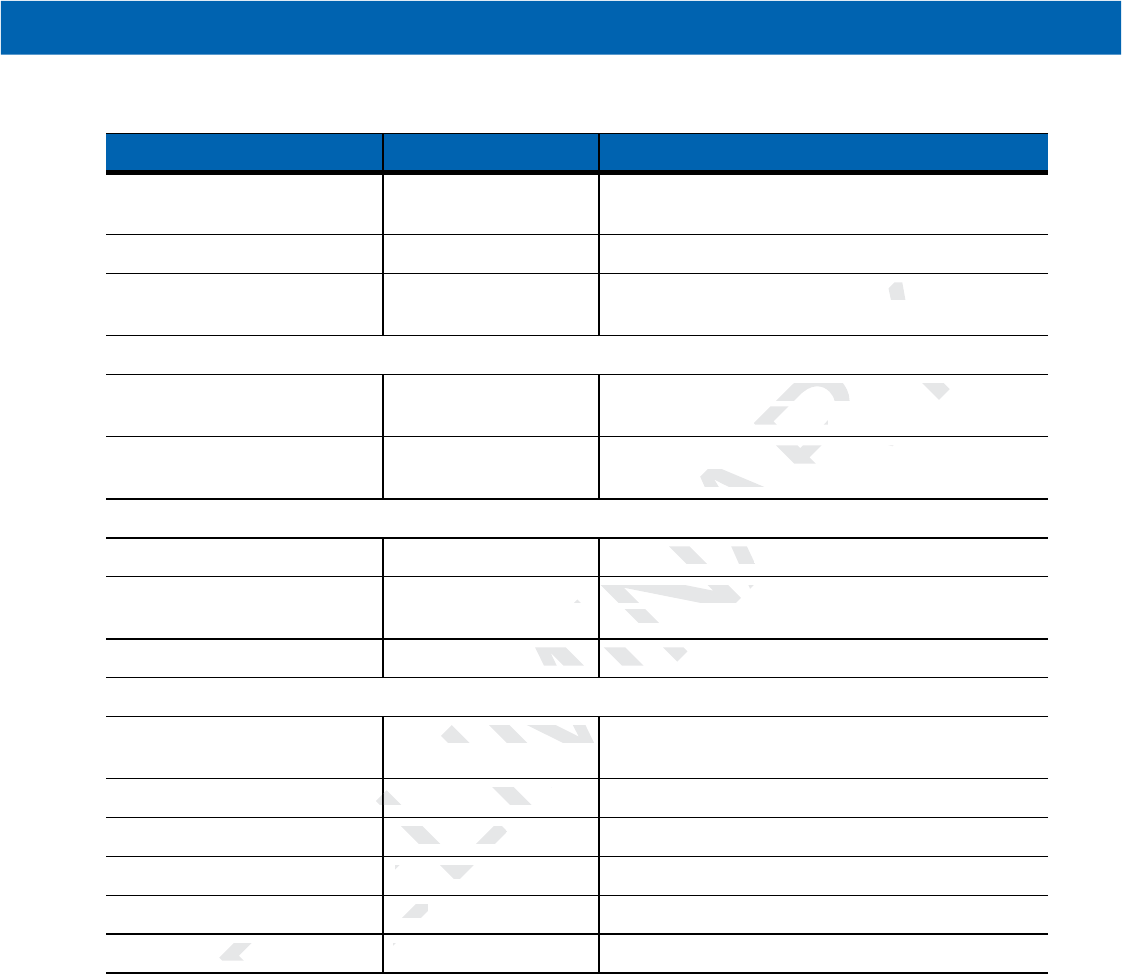
6 - 2 MC21XX Series User Guide
International AC Line Cord - Provides power to the 2-wire power supply.
Purchase separately.
US AC Line Cord 23844-00-00R Provides power to the 3-wire power supply.
International AC Line Cord - Provides power to the 3-wire power supply.
Purchase separately.
Cables
USB ActiveSync/Charge
Cable
25-154073-01R Provides USB client communication capabilities
and charges the MC21XX.
USB Cable 25-68596-01R Provides USB communication through the
Single-slot USB cradle.
Soft Goods
Handstrap SG-MC2123225-01R Replacement handstrap.
Holster SG-MC2121205-01R Provides a soft, clip on holder and a shoulder strap
for the MC21XX.
Lanyard SG-MC2127225-01R Optional lanyard for holding the MC21XX.
Miscellaneous
Modem Dongle MDM9000-100R Provides modem connectivity through the MC21XX
and Modem Adapter Cable.
Modem Adapter Cable 25-154074-01R Connects Modem Dongle to the MC21XX.
2400 mAh Battery BTRY-MC21EAB0E Replacement battery.
Stylus 11-42794-03R Replacement stylus (3-pack).
Tether TBS Replacement tether (3-pack).
Screen protector TBS Replacement screen protectors (3-pack).
Table 6-1
MC21XX Accessories (Continued)
Accessory Part Number Description
NARY
wer su
er
communication capab
communication capa
MC21XX.
MC21XX.
B communication thro
munication thro
ot USB cradle.
USB cradle.
Y
RY
AR
AR
NA
Replacement handstra
ement han
MINA
Provides a soft, c
Provides a soft, c
for the MC21XX
r the MC21XX
MIN
MIN
25-01R Optional la
01R Optional l
MIN
LIMI
M9000-100R P
9000-100R
M
ELIM
25-154074-01R25-154074-01R
EL
EL
BTRY-MC21EABTRY-MC21E
EL
REL
11-42794-11-42794-
EL
NA
NA
MIN
MI
M
LIM
ELI
EL
RE
TBSTBS
E
PRE
ectorector
TT
E
RE
RE
PR
PR
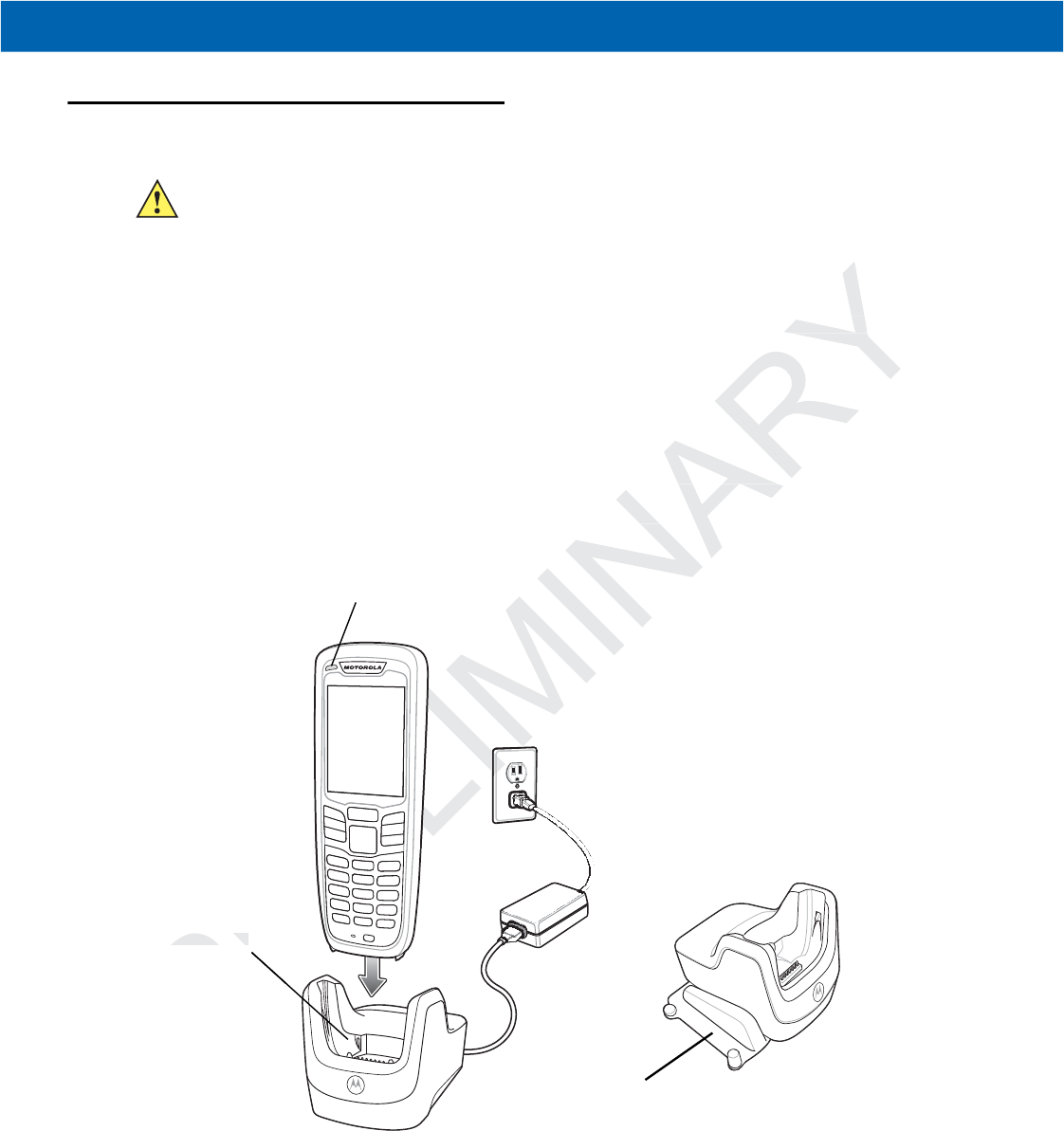
Accessories 6 - 3
Single-slot USB Cradle
The Single-slot USB cradle:
•
Provides 5.4VDC power for operating the MC21XX and charging the battery.
•
Provides a USB port for data communication between the MC21XX and a host computer.
•
Provides USB host communications between the MC21XX and a peripheral device.
Battery Charging
The Single-slot USB cradle can charge theMC21XX main battery. To charge the MC21XX:
1. Slide the MC21XX into the slot. The MC21XX LED Indicator indicates the MC21XX battery charging
status. The battery charges in approximately four hours. See Table 1-1 on page 1-6 for charging status
indications.
Figure 6-1
Single-slot USB Cradle
2. When charging is complete remove the MC21XX from the cradle.
Each Single-slot USB cradle comes with a mating adapter. Use the mating adapter to connect two or more
cradles together. Each cradle still requires a power supply.
CAUTION Ensure that you follow the guidelines for battery safety described in Battery Safety Guidelines on page
7-2.
LED
Indicator
MC21XX Slot
Mating Adapter
host computer.
host comp
pheral device.
pheral
ry. To charge the MC2
. To charge the M
cator indicates the MC
cator indicates the M
urs. See
See
Table 1-1 on
ble
I
I
LI
ELI
LI
REL
RE
EL
EL
REL
PRE
RE
RE
RE
EL
RE
RE
RE
RE
RE
RE
R
E
E
E
RE
RE
RE
RE
E
EL
REL
RE
EL
EL
E
E
RE
E
RE
EL
EL
EL
EL
E
EL
EL
C21XX SlotC21XX Slot
PR
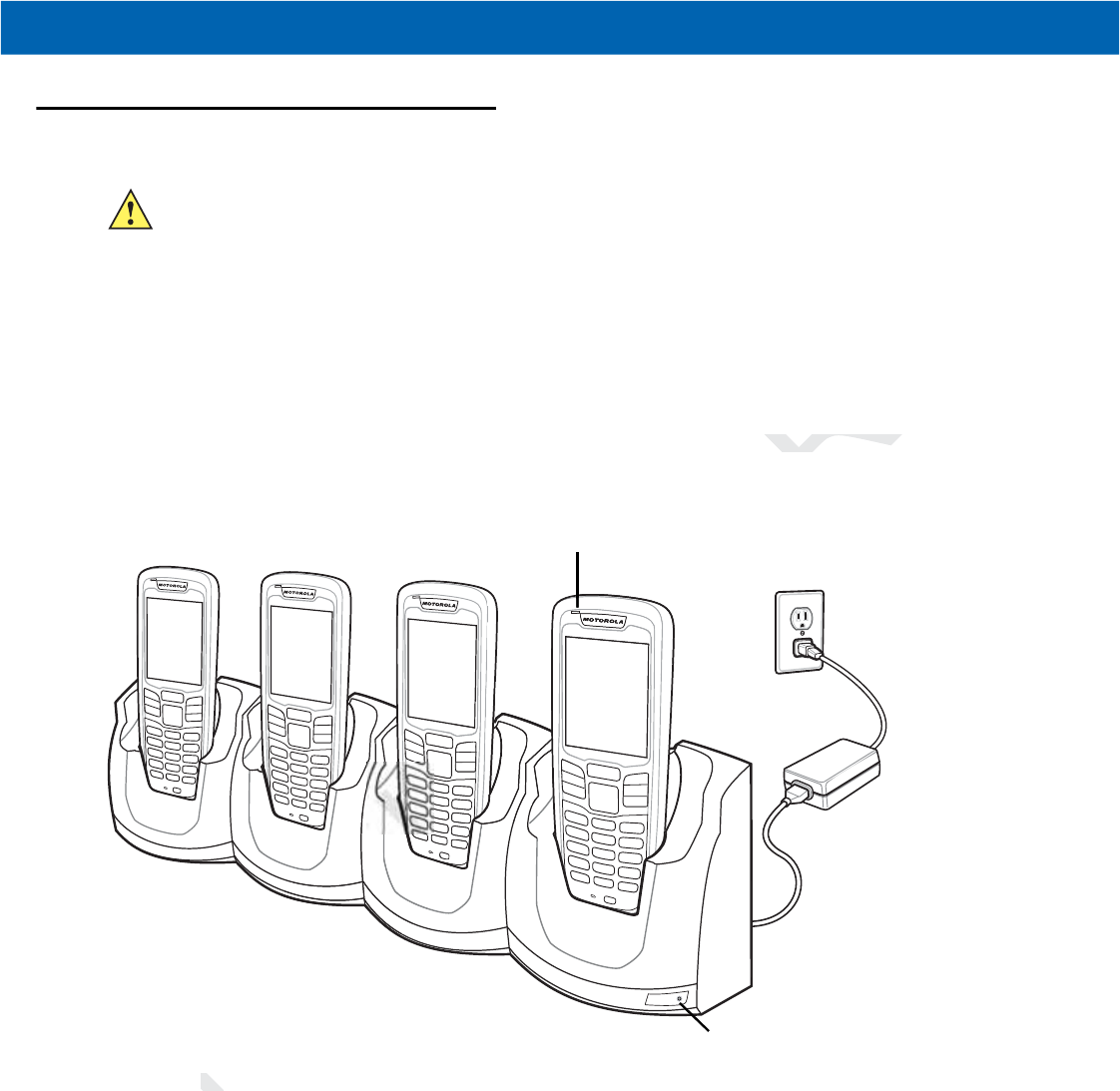
6 - 4 MC21XX Series User Guide
Four-slot Charge Only Cradle
The Four-slot Charge Only cradle:
•
Provide 5.4 VDC power for operating the MC21XX and charging the battery.
•
Simultaneously charges up to four MC21XXs.
Battery Charging
The Four-slot Charge Only cradle can charge up to four MC21XXs simultaneously. To charge the MC21XX:
1. Slide the MC21XX into the cradle slot.
Figure 6-2
Four-slot Charge Only Cradle
2. The MC21XX LED Indicator indicates the MC21XX battery charging status. The battery usually charges in
approximately four hours. See Table 1-1 on page 1-6 for charging status indications.
3. When charging is complete, remove the MC21XX from the cradle.
Power LED
The green Power LED lights to indicate that the Four-slot Charge Only cradle is connected to a power source.
CAUTION Ensure that you follow the guidelines for battery safety described in Battery Safety Guidelines on page
7-2.
LED Indicator
Power LED
NARY
ltaneously. To charge
ously. To charge
MINA
MIN
MIN
MIN
PR
Four-sloFou
PRELIM
RELIM
RELIM
RELIM
RE
IM
RE
RE
RE
E
ELIM
EL
LIM
IM
LIM
LIM
LIM
ELIM
L
LIM
LI
LI
IM
IM
ELIM
EL
LIM
LI
LI
L
L
LI
LI
ELI
EL
EL
EL
EL
LIM
LIM
LIM
ELIM
LIM
LIM
L
LIM
LIM
LIM
LIM
IM
ELI
M
MIN
M
MIN
M
MIN
I
I
IN
IN
IN
IN
I
IN
IN
MIN
MIN
MIN
MIN
M
MIN
or
I
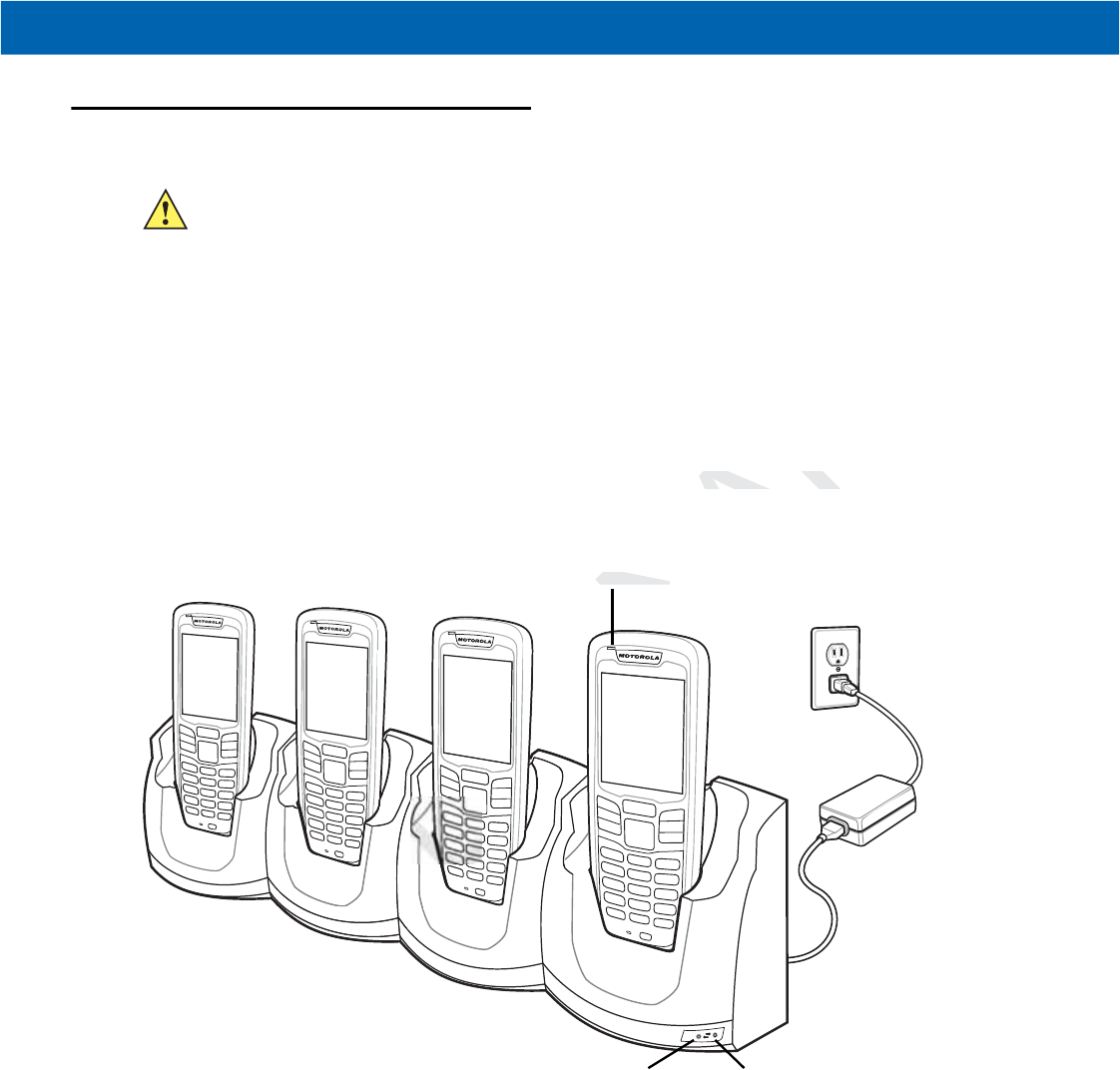
Accessories 6 - 5
Four-slot Ethernet Cradle
The Four-slot Ethernet cradle:
•
Provide 5.4 VDC power for operating the MC21XX and charging the battery.
•
Simultaneously charges up to four MC21XXs.
•
Connects the MC21XX to an Ethernet network.
Battery Charging
The Four-slot Ethernet cradle can charge up to four MC21XXs simultaneously. To charge the MC21XX:
1. Slide the MC21XX into the cradle slot.
Figure 6-3
Four-slot Ethernet Cradle
2. The MC21XX LED Indicator indicates the MC21XX battery charging status. The battery usually charges in
approximately four hours. See Table 1-1 on page 1-6 for charging status indications.
3. When charging is complete, remove the MC21XX from the cradle.
LED Charge Indications
The Four-slot Ethernet cradle use the MC21XX amber LED Indicator to indicate the battery charging status.
See Table 1-1 on page 1-6 for charging status indications.
CAUTION Ensure that you follow the guidelines for battery safety described in Battery Safety Guidelines on page
7-2.
100
Mbps
LED Indicator
Speed LED Link LED
PRELIMINARY
simultaneously. To ch
multaneously. To
PRELIMIN
RELIM
RELIM
RELIM
EL
RE
E
RE
EL
RE
EL
ELIM
EL
ELIM
LIM
ELIM
LIM
LIM
LI
LIM
LIM
LIM
L
L
L
L
L
L
L
L
IM
ELIM
LI
LI
LI
LI
LI
LI
LI
IM
IM
I
I
LIM
EL
MIN
MIN
MIN
MI
MIN
MIN
MIN
IN
IN
IN
IN
MIN
IN
IN
MIN
MIN
MIN
MIN
L
EL
L
E
E
E
E
E
E
E
E
E
E
E
E
EL
D Indicator
D Indicator
MIN

6 - 6 MC21XX Series User Guide
Speed LED
The green Speed LED lights to indicate that the transfer rate is 100 Mbps. When it is not lit it indicates that the
transfer rate is 10 Mbps.
Link LED
The yellow Link LED blinks to indicate activity, or stays lit to indicate that a link is established. When it is not lit,
it indicates that there is no link.
PRELIMINARY
ed. W
d.

Accessories 6 - 7
Four-slot Spare Battery Charger
The Four-slot Spare Battery Charger simultaneously charges up to four spare batteries.
Spare Battery Charging
To charge up to four spare batteries:
1. Insert the spare battery into the spare battery charging slot, contact end first.
2. Pivot the battery down into the charging slot.
Figure 6-4
Four-slot Spare Battery Charger
3. Gently press down on the battery to ensure proper contact. The battery charges in approximately four
hours. See Table 1-1 on page 1-6 for charging status indications.
4. When charging is complete, press the battery clip and lift battery out of the slot.
The Spare Battery Charging LEDs indicate the spare battery charging status. See Table 1-1 on page 1-6 for
charging status indications.
CAUTION Ensure that you follow the guidelines for battery safety described in Battery Safety Guidelines on page
7-2.
Spare
Batteries Spare Battery
Charging Slot
Spare Battery
Charging
LEDs (4)
WARNING!Do not use a tool to remove the battery.
PRELIMINARY
end first.
end f
Figure 6-4Figure
Four-slot SFour-slot
Gently pressGent
ours. Seours.
RELIM
RELIM
RELIM
L
EL
EL
L
EL
EL
EL
EL
REL
L
L
EL
L
L
EL
EL
EL
EL
EL
EL
IM
LIM
LIM
LI
ELI
L
L
L
M
M
I
I
I
I
LIM
IM
LI
LIM
M
M
M
EL
M
M
M
M
M
M
M
Spare
Spa
Batteries
Batteries
L
L
IN
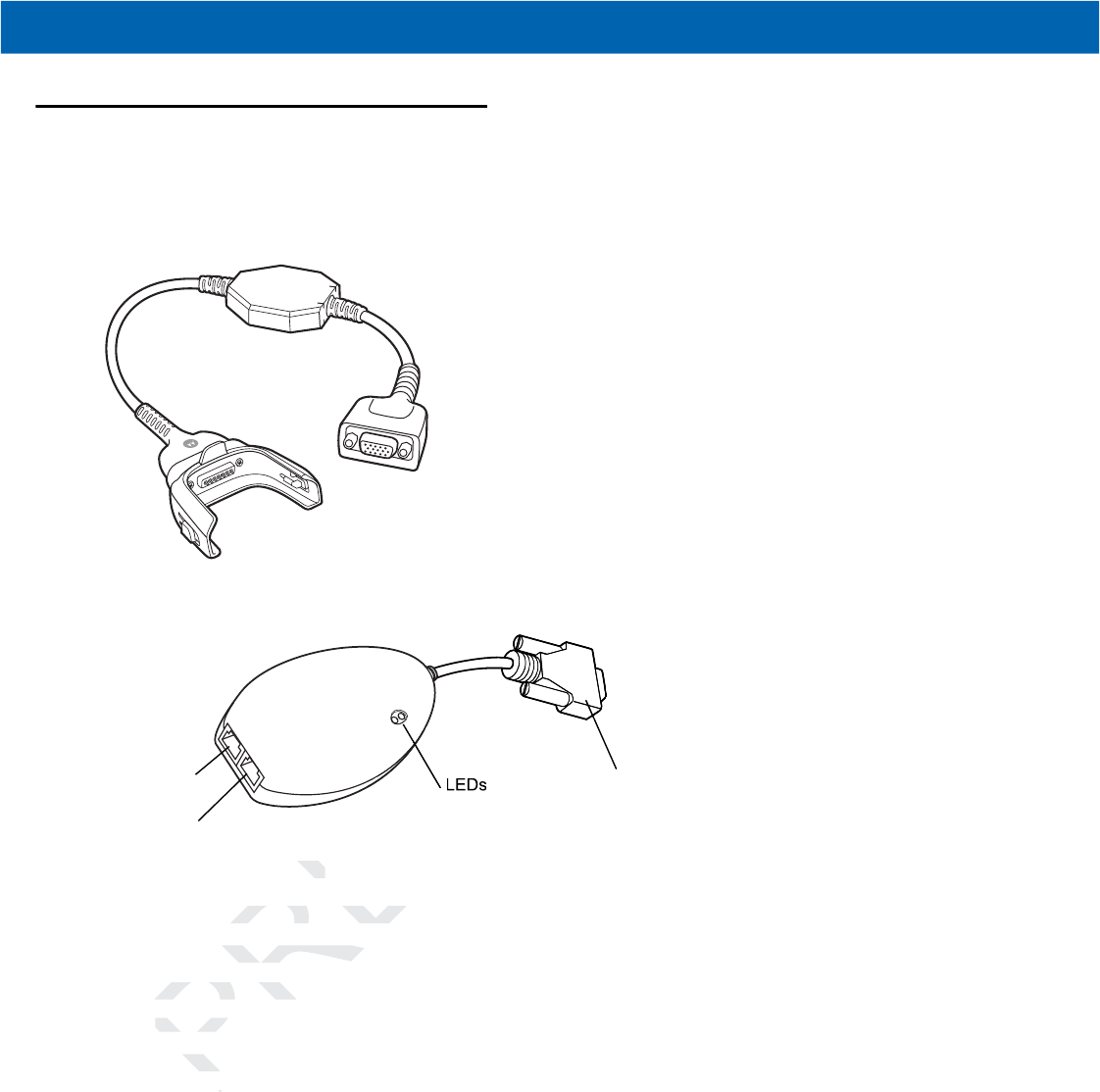
6 - 8 MC21XX Series User Guide
Modem Adapter Cable/Modem Dongle
Use the Modem Adapter Cable and Modem Dongle to enable data communication between the MC21XX and
a host computer, remotely through the phone lines, and synchronizes information between the MC21XX and a
host computer.
Figure 6-5
Modem Adapter Cable
Figure 6-6
Modem Dongle
The following items are required for a modem connection:
•
Telephone number, IP address and DNS/WINS address information from the dial-in server administrator
•
Dial-in account on the host system, including a user ID and password
•
RJ11 or RJ12 modem cable
•
Functioning telephone jack that supports plug-in modems connected to the local telephone system
•
Setup of Country Codes to use the modem with the appropriate country’s telephone network.
Serial Port
Line In Port LEDs
Phone Port
PRELIMINARY
Donglengle
tems are required for
tems are required for
phone number, IP ad
one number, IP ad
Dial-in account on theDial-in account on
RJ11 or RJ12 moRJ11 or RJ12 mo
nctioning t
nction
ff
ELIMIN
MI
MIN
M
MI
M
MI
MI
MIN
MIN
M
MI
M
M
M
M
M
M
M
M
M
M
MI
MI
M
M
MI
MI
M
M
M
M
L
L
L
L
M
LI
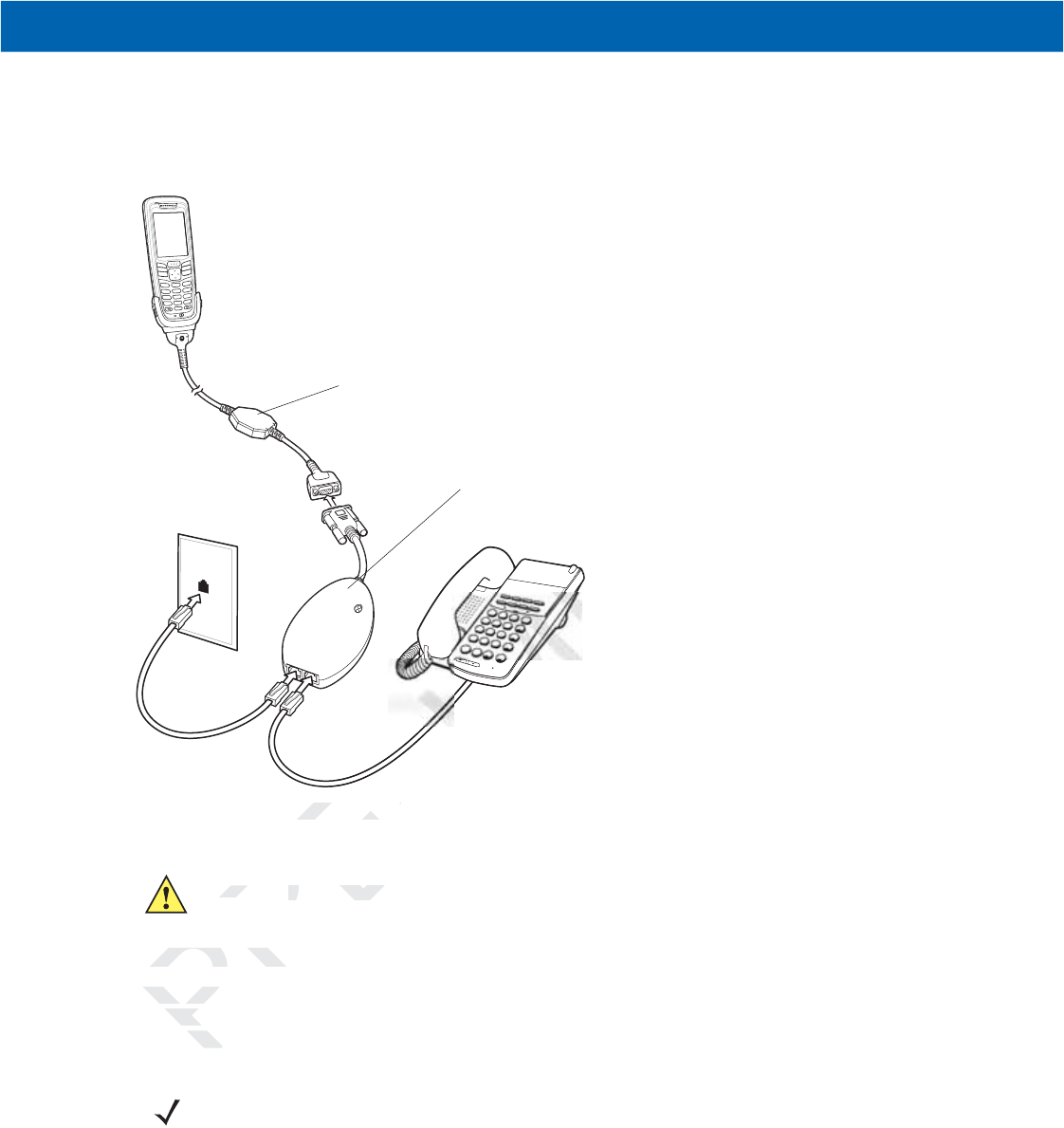
Accessories 6 - 9
Setup
Connecting to the MC21XX
Figure 6-7
Modem Dongle Setup
Using the Correct Telephone Line Type
Use a standard analog phone line, as in most households. In an office, use a line connected to a fax machine
or modem. In a hotel, request a room with a standard phone line or data port. If necessary, check with the local
phone company or administrator to make sure you are using the right type of line before sending data.
Modem Dongle
Modem Adapter Cable
CAUTION Do not connect the modem's 15-pin connector into a VGA port of a host computer.
NOTE If using a phone, connect the cord from the phone to the Phone port on the modem.
PRELIMINARY
Dongle SetupDongle Setup
sing the Correct Telepsing the Correct T
Use a standard anUse a stan
modem. In a mode
compacom
ELIMIN
ELIM
ELIM
MIN
MIN
MIN
MIN
MIN
MIN
MIN
MIN
MIN
MIN
IN
IN
I
M
IN
IN
M
M
M
M
M
M
M
IN
M
M
M
M
M
M
AUTION
AUTI
Do not conne
Do not conne

6 - 10 MC21XX Series User Guide
Table 6-2
Modem LED Indicator
LED Indication
Off Modem is not properly connected to the MC21XX; modem is not receiving power.
Green Modem is connected to the MC21XX and is receiving power.
Solid Amber MC21XX is communicating with the host computer.
PRELIMINARY
Y
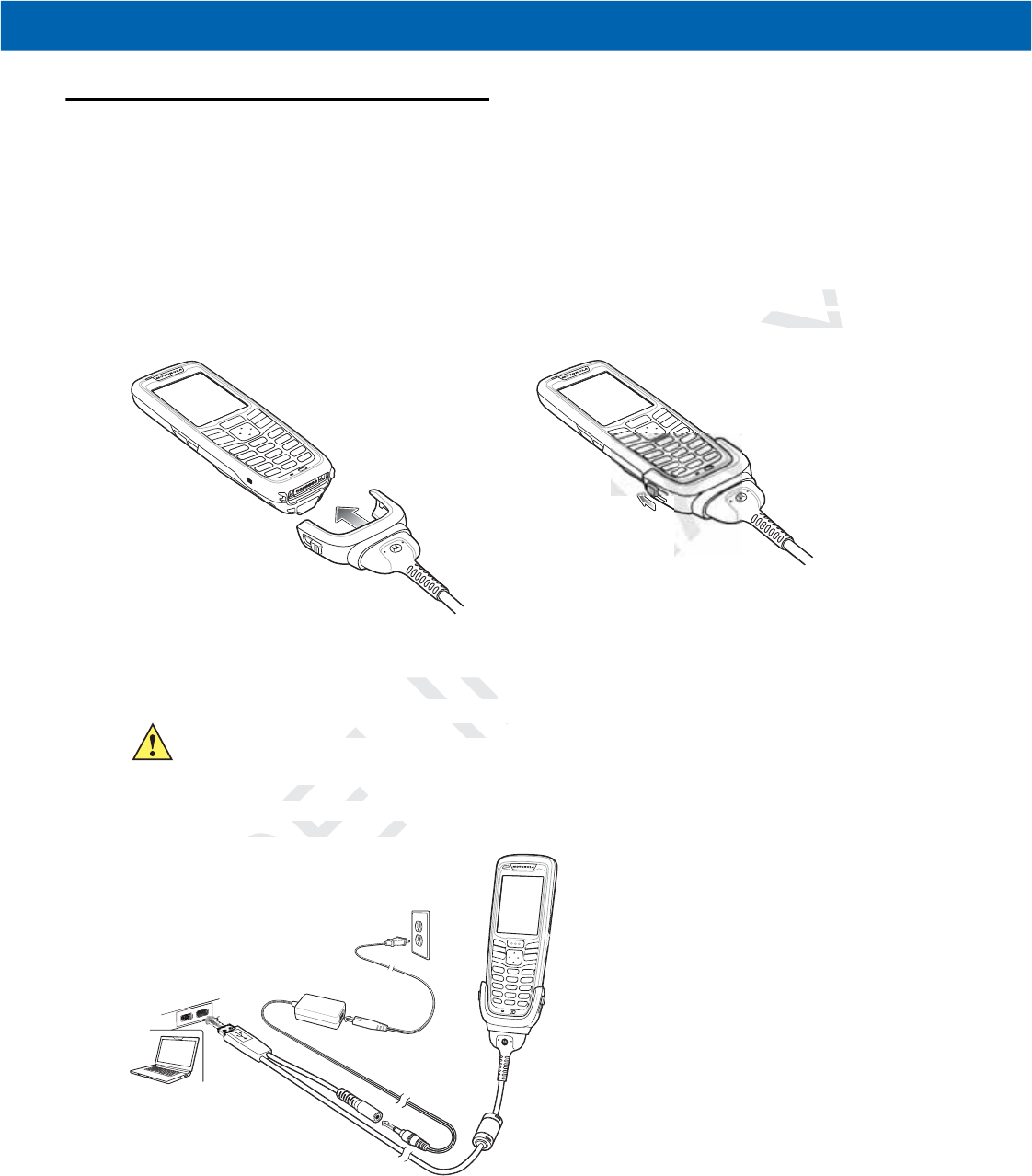
Accessories 6 - 11
USB ActiveSync/Charge Cable
The USB ActiveSync/Charge cable:
•
Provide the MC21XX with operating and charging power when used with the approved power supply.
•
Synchronize information between the MC21XX and a host computer. With customized or third party
software, it can also synchronize the MC21XX with corporate databases.
•
Provide USB connection through the USB pass-through port for communication with a USB device, such
as a host computer. For communication setup procedures, refer to the MC21XX Series Mobile Computer
Integrator Guide.
Figure 6-8
USB Charge Cable
Battery Charging and Operating Power
To charge the MC21XX battery:
1. Connect the USB Charge Cable power input connector to the approved power source.
Figure 6-9
USB Charge Cable
2. Slide the bottom of the MC21XX into the MC21XX connector end of the MC21XX Communication/Charge
cable and gently press in until the snaps latch into the MC21XX.
CAUTION Ensure that you follow the guidelines for battery safety described in Battery Safety Guidelines on page
7-2.
LIMINARY
ion with a USB
th
C21XX Series Mobile
21XX Serie
ating Power
ng Power
NA
NA
NAR
AR
AR
AR
AR
AR
A
A
AR
A
A
A
A
A
A
A
AR
PRELI
21XX battery:
21XX battery
he USB Charge Cablehe USB Charge Cable
P
AR
AR
NAR
NAR
AR
A
A
A
NA
A
A
NA
NA
NA
NA
at you follow the guidelin
at you follow the guidelin
P
P
P
P

6 - 12 MC21XX Series User Guide
3. The MC21XX LED Indicator indicates the MC21XX battery charging status. The battery usually charges in
less than four hours. See, Table 1-1 on page 1-6 for charging status indications.
4. When charging is complete, remove the cable by gently pulling the MC21XX and the cable apart until the
snaps release the MC21XX.
LED Charge Indications
The MC21XX Charge cable use the amber LED Indicator to indicate the MC21XX battery charging status. See
Table 1-1 on page 1-6 for charging status indications.
PRELIMINARY
charging
ar
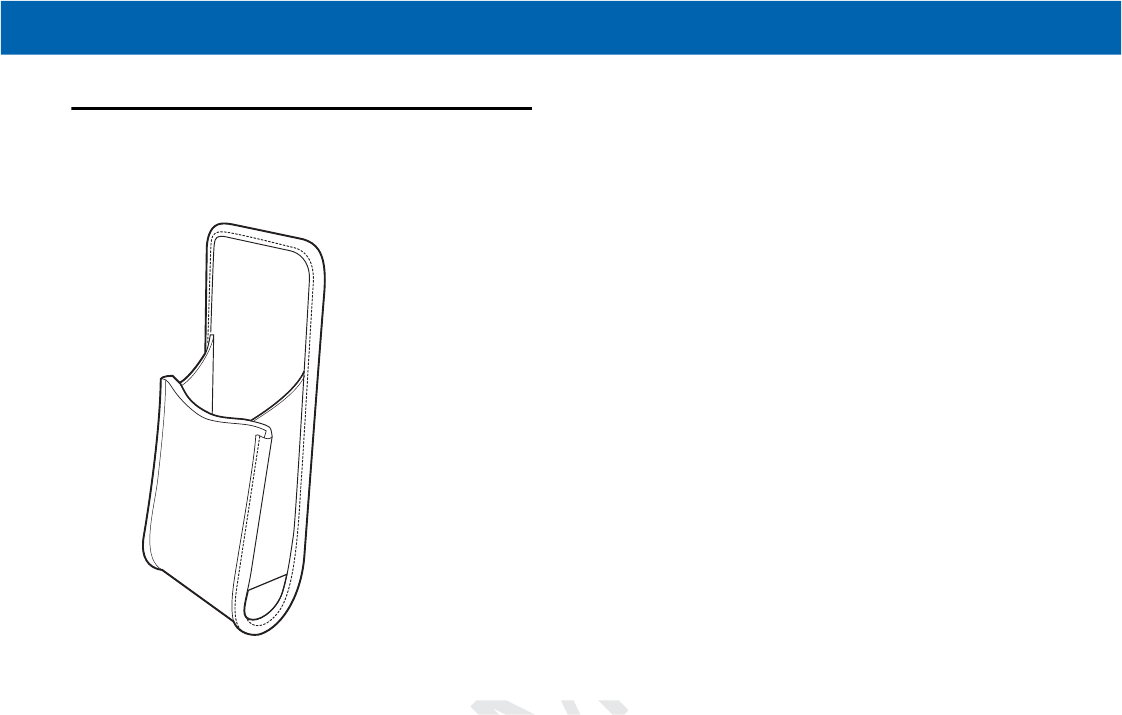
Accessories 6 - 13
Holster
The holster provides a holder for the MC21XX.
Figure 6-10
Holster
The holster holds the MC21XX on a belt or waist band. Slide the MC21XX into the holster with the screen
facing the user.
PRELIMINARY
belt or waist band. Sli
elt or waist band. S
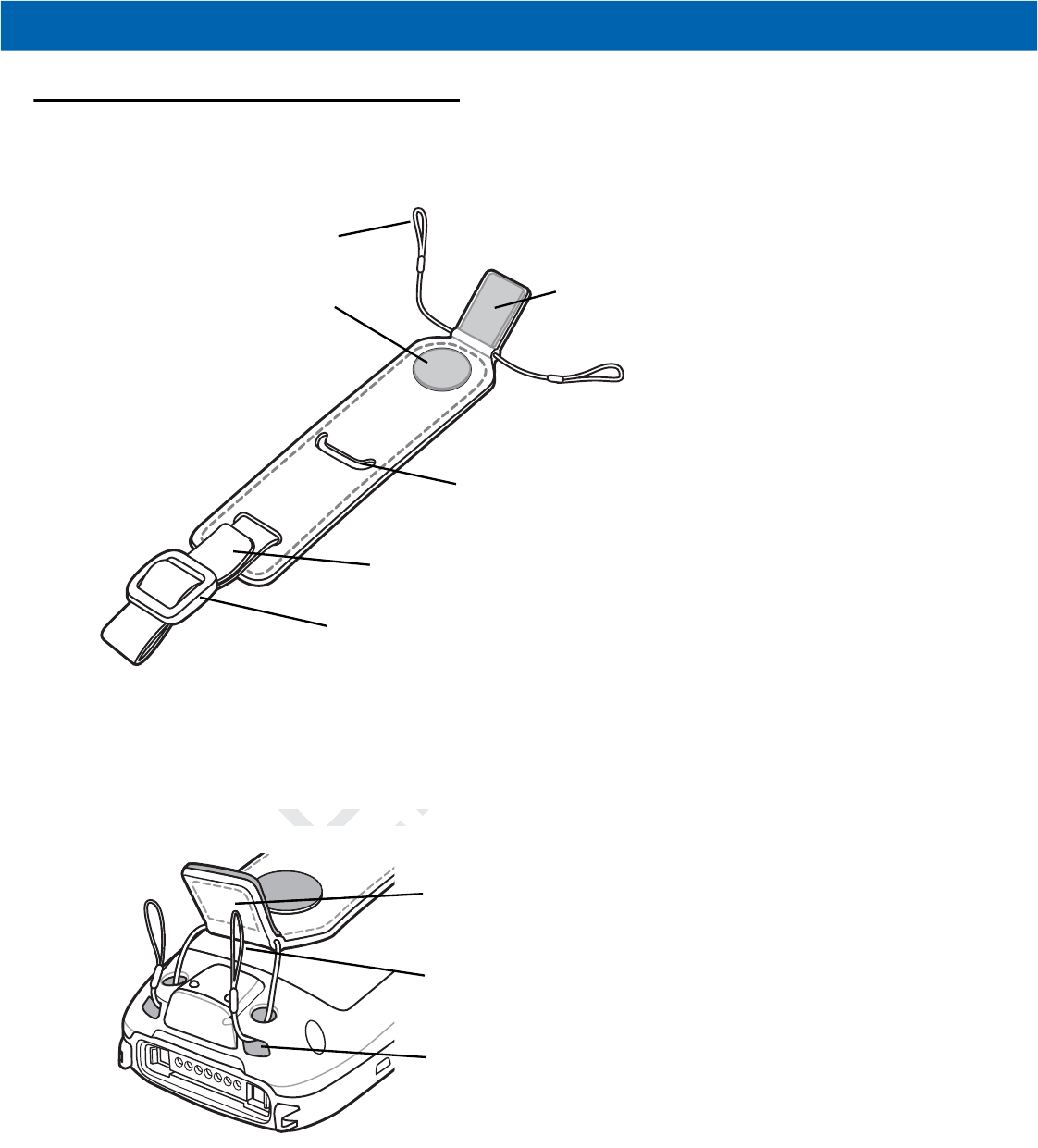
6 - 14 MC21XX Series User Guide
Handstrap
Figure 6-11
Handstrap
Installation
To install the handstrap:
1. Feed both loops through the mounting slots.
Figure 6-12
Feed Loops Through Mounting Slots
2. Slide each loop over the strap tab and push all the way down.
Belt
Buckle
Mini Stylus Holder
Loop
Loop Material Hook Material
Loop
Strap Tab
Mounting Slots
RELIMINARY
through the mounting
hrough the mounting
MINA
R
R
R
RE
R
R
R
PRE
RE
R
PR
P
PR
PR
P
PR
P
P
P
P
P
P
P
P
P
P
P
P
PR
PRE
PR
PRE
R
PR
R
R
R
R
R
PR
R
R
PRE
PRE
PR
PR
PR
PR
P
PR
PR
PR
PR
P
P
P
PR
PR
P
P
P
P
P
P
PR
PR
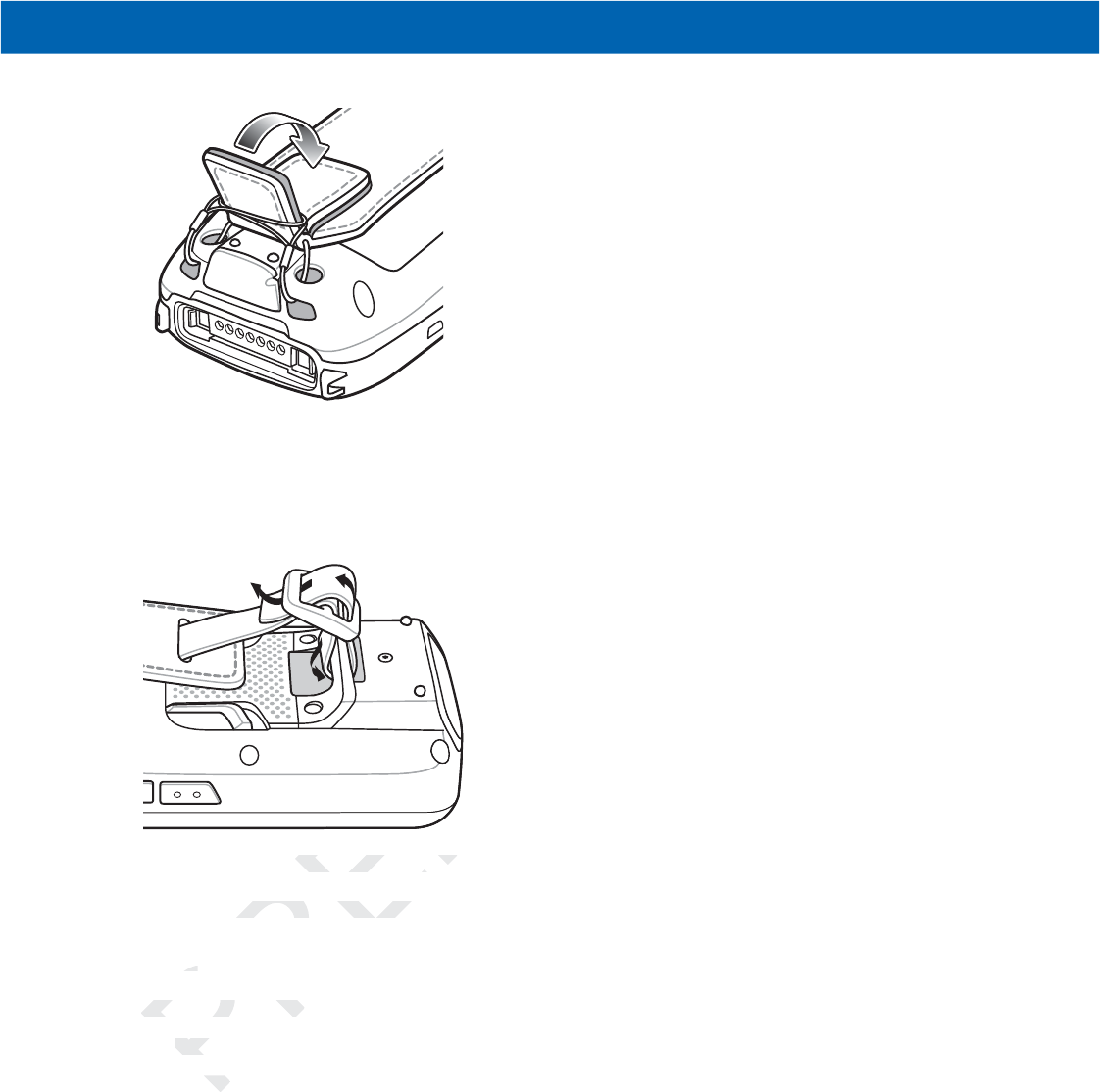
Accessories 6 - 15
Figure 6-13
Secure Tab
3. Press the tab down to secure.
4. Feed the belt through the handstrap bar.
Figure 6-14
Connect Handstrap to Handstrap Bar
5. Feed the belt through the buckle.
Removal
To remove the handstrap:
1. Pull the belt through the buckle.
2. Pull the belt through the handstrap bar.
3. Lift the strap tab.
4. Lift both loops off the strap tab.
5. Pull loops through the mounting slots.
PRELIMINARY
nect Handstrap to Hanct Handstrap to Han
he belt through the bu
he belt through the bu
alal
To remove the hands
To remove the hand
Pull the belt Pull
the the
ELIM
ELI
ELIM
ELI
I
LIM
LIM
LI
LI
I
LI
LI
LI
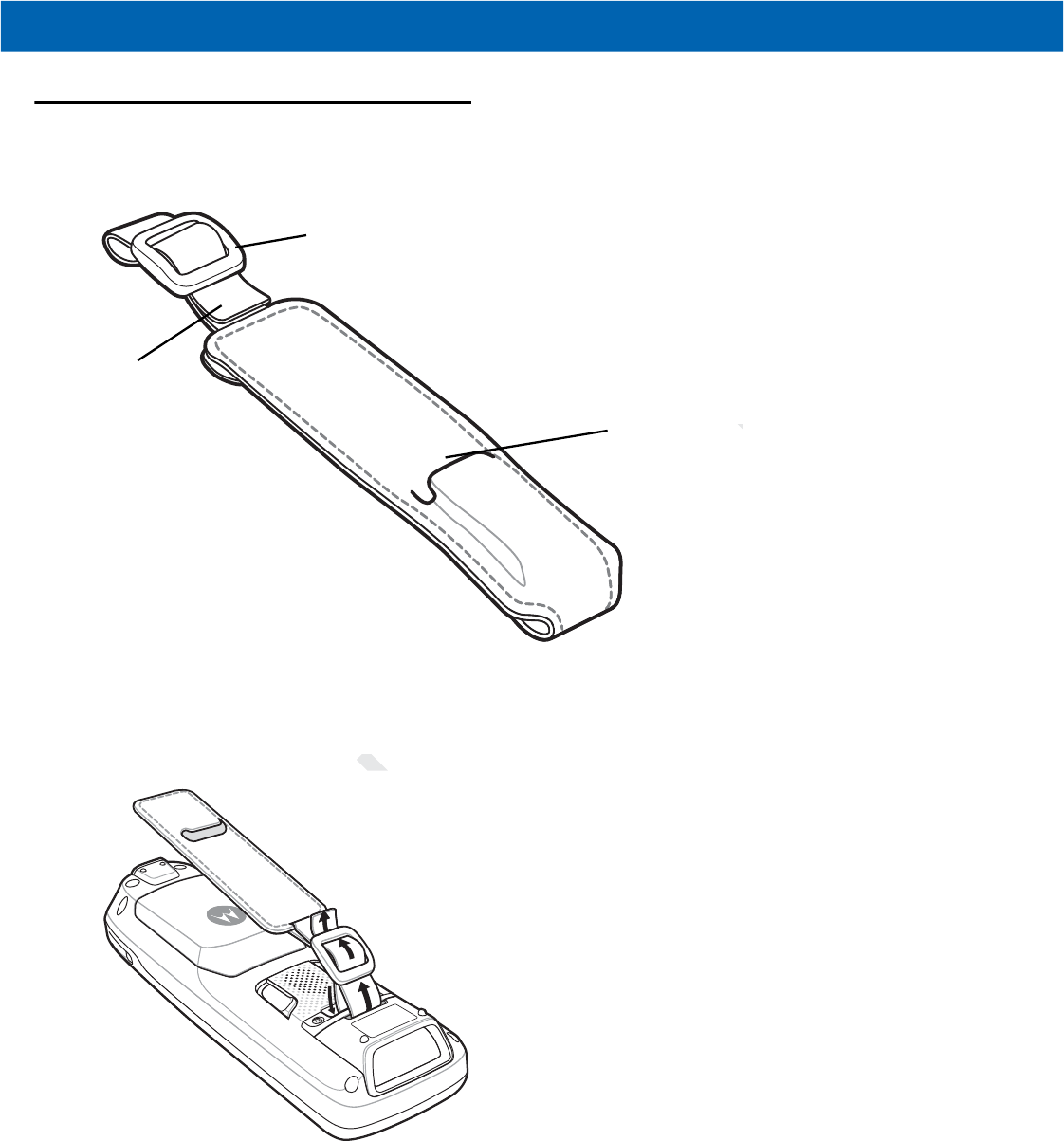
6 - 16 MC21XX Series User Guide
Lanyard
Figure 6-15
Lanyard
Installation
1. Feed the belt through the handstrap bar.
Figure 6-16
Lanyard Installation
2. Feed the belt through the buckle.
Removal
Mini Stylus Holder
Belt
Buckle
1
2
ELIMINARY
handstrap bar.
ands
MIN
MIN
MIN
MIN
MIN
IN
MI
MI
MI
MI
us Holder
er
PREL
PR
PRE
PR
PR
PR
R
PR
PR
PR
PR
PR
R
R
R
R
R
R
R
R
R
R
R
R
R
R
R
R
R
R
R
R
PR
P
P
P
P
PR
PR
PR
PR
PR
PR
PR
PRE
PRE
R
R
RE
R
R
R
R
R
R
R
R
R
R
R
R
R
R
R
R
R
PR
PRE
R
PRE
R
R
PR

Accessories 6 - 17
Tether Installation
Use the tether to attach the mini stylus or pen stylus to the MC21XX handstrap bar. To install the tether:
Insert loop into mounting hole on stylus.
Feed other end through loop and pull taught.
Feed loop into mounting hole on handstrap bar.
Feed stylus through loop and pull taught.
PRELIMINARY

6 - 18 MC21XX Series User Guide
PRELIMINARY
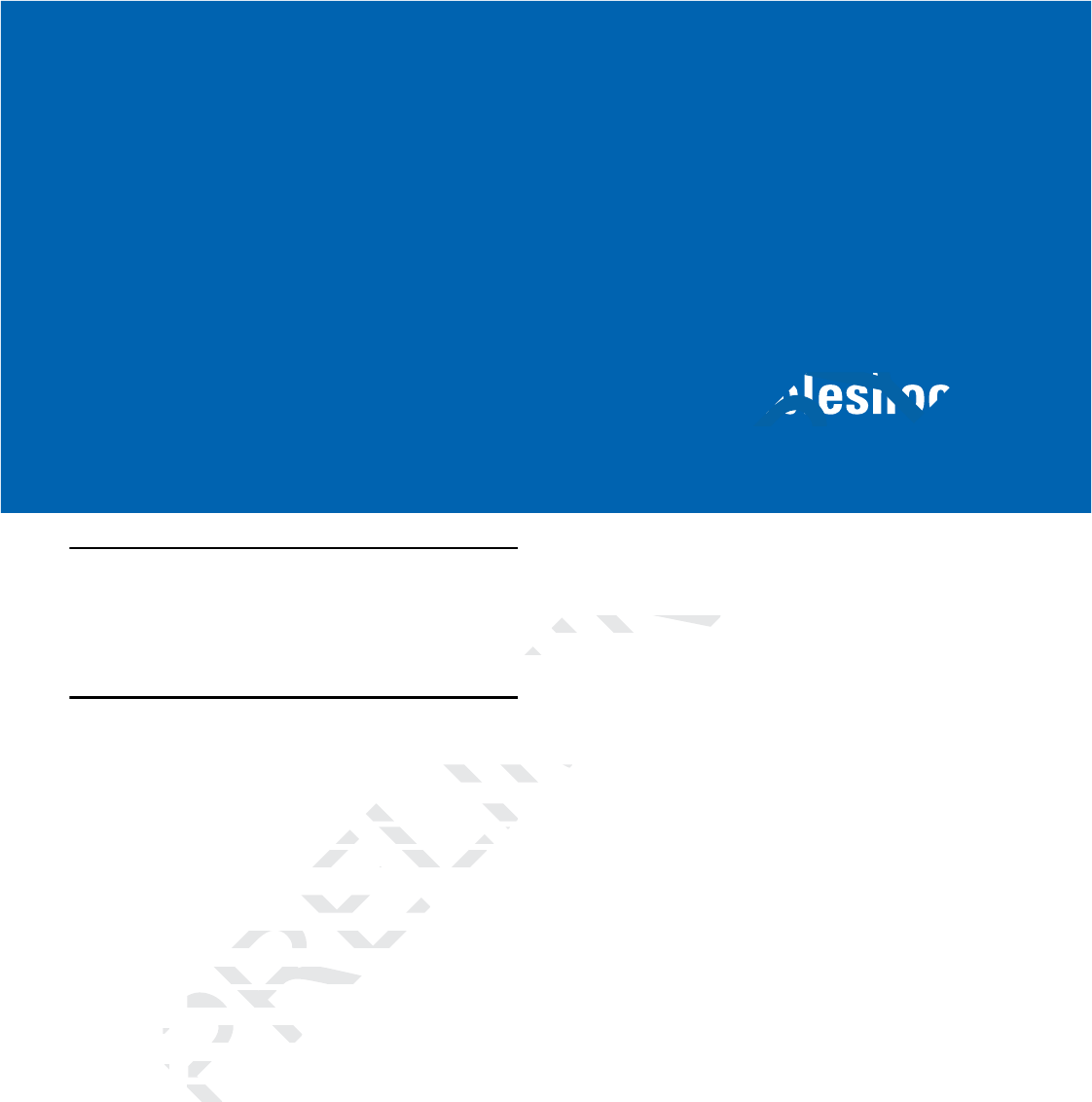
Chapter 7 Maintenance & Troubleshooting
Introduction
This chapter includes instructions on cleaning and storing the MC21XX, and provides troubleshooting solutions
for potential problems during MC21XX operation.
Maintaining the MC21XX
For trouble-free service, observe the following tips when using the MC21XX:
•
Do not scratch the screen of the MC21XX. When working with the MC21XX, use the supplied stylus or
plastic-tipped pens intended for use with a touch-sensitive screen. Never use an actual pen or pencil or
other sharp object on the surface of the MC21XX screen.
Motorola recommends using a screen protector, p/n TBS.
•
The screen of the MC21XX is glass. Do not to drop the MC21XX or subject it to strong impact.
•
Protect the MC21XX from temperature extremes. Do not leave it on the dashboard of a car on a hot day,
and keep it away from heat sources.
•
Do not store or use the MC21XX in any location that is dusty, damp, or wet.
•
Use a soft lens cloth to clean the MC21XX. If the surface of the MC21XX screen becomes soiled, clean it
with a soft cloth moistened with a diluted window-cleaning solution.
•
Periodically replace the rechargeable battery to ensure maximum battery life and product performance.
Battery life depends on individual usage patterns.
PRELIMINAR
ARY
AR
ublesho
d storing the MC21XX
storing the MC21XX
on.on
M
ve the following tips wfollowing tips w
creen of the MC21XXreen of the MC21X
s intended for use wit
s intended for use wit
ect on the surface of
ect on the surface of
recommends using a ommends using
screen of the MC21XXscreen of the MC21XX
Protect the MC21XX frotect the MC21XX
and keep it away froand keep it
•
•
Do not store or
not store o
••
Use a soft lUse
P
with a so
with
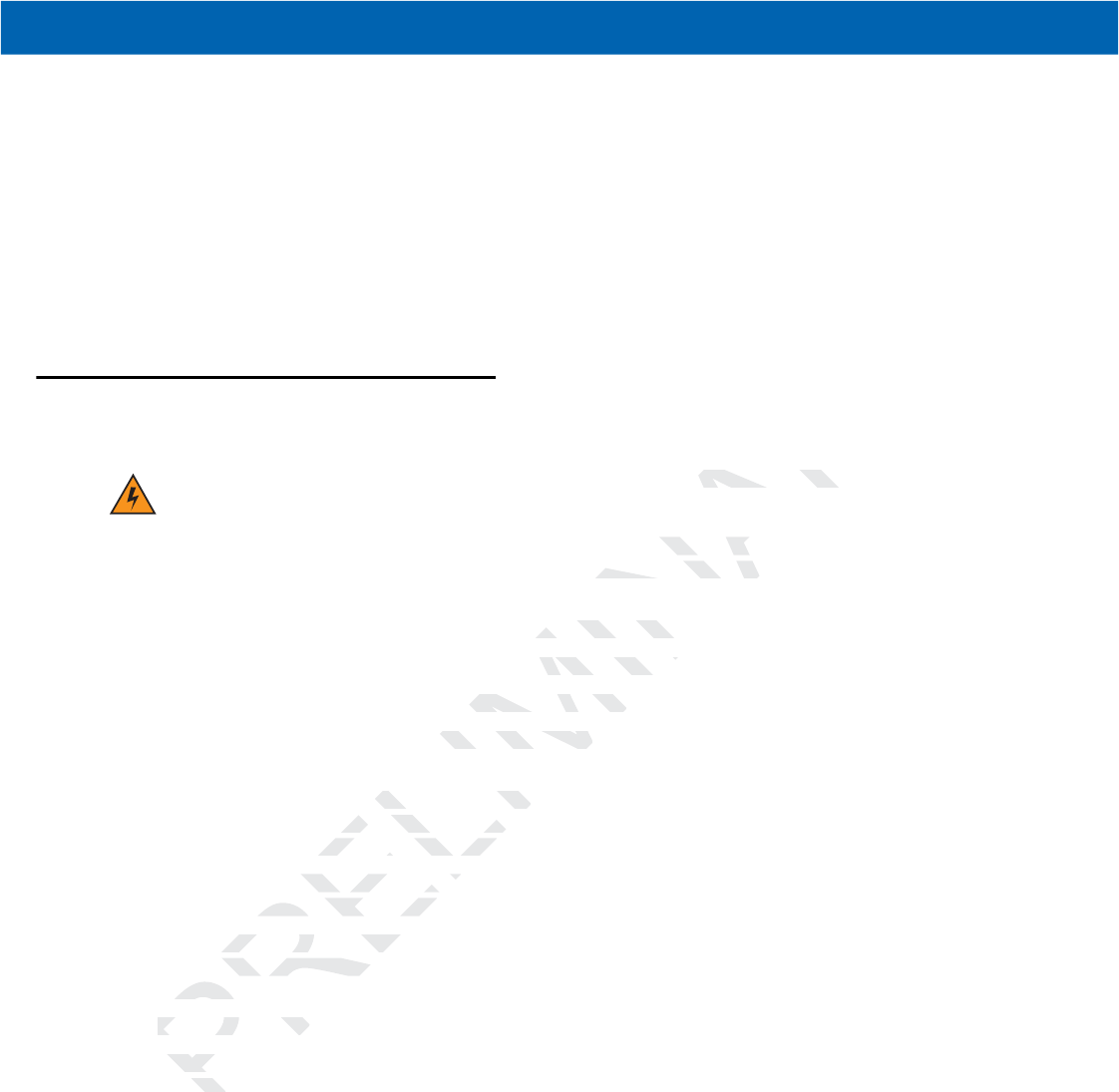
7 - 2 MC21XX Series User Guide
•
A screen protector is applied to the MC21XX. Motorola recommends using this to minimize wear and
tear. Screen protectors enhance the usability and durability of touch screen displays. Benefits include:
•Protection from scratches and gouges
•Durable writing and touch surface with tactile feel
•Abrasion and chemical resistance
•Glare reduction
•Keeping the device’s screen looking new
•Quick and easy installation.
Battery Safety Guidelines
•
The area in which the units are charged should be clear of debris and combustible materials or
chemicals. Particular care should be taken where the device is charged in a non commercial
environment.
•
Follow battery usage, storage, and charging guidelines found in the user's guide.
•
Improper battery use may result in a fire, explosion, or other hazard.
•
Do not use a tool to remove the battery from the MC21XX or battery charging accessory.
•
To charge the mobile device battery, the battery and charger temperatures must be between +32 ºF and
+104 ºF (0 ºC and +40 ºC)
•
Do not use incompatible batteries and chargers. Use of an incompatible battery or charger may present a
risk of fire, explosion, leakage, or other hazard. If you have any questions about the compatibility of a
battery or a charger, contact Motorola Enterprise Mobility support.
•
For devices that utilize a USB port as a charging source, the device shall only be connected to products
that bear the USB-IF logo or have completed the USB-IF compliance program.
•
To enable authentication of an approved battery, as required by IEEE1725 clause 10.2.1, all batteries will
carry a Motorola hologram. Do not fit any battery without checking it has the Motorola authentication
hologram.
•
Do not disassemble or open, crush, bend or deform, puncture, or shred.
•
Severe impact from dropping any battery-operated device on a hard surface could cause the battery to
overheat.
•
Do not short circuit a battery or allow metallic or conductive objects to contact the battery terminals.
•
Do not modify or remanufacture, attempt to insert foreign objects into the battery, immerse or expose to
water or other liquids, or expose to fire, explosion, or other hazard.
•
Do not leave or store the equipment in or near areas that might get very hot, such as in a parked vehicle
or near a radiator or other heat source. Do not place battery into a microwave oven or dryer.
•
Battery usage by children should be supervised.
•
Please follow local regulations to properly dispose of used re-chargeable batteries.
•
Do not dispose of batteries in fire.
WARNING!Failure to follow these guidelines may result in fire, explosion, or other hazard.
PRELIMINARY
ar of debris and comb
debris and
he device is charged i
he device is charged
guidelines found in th
guidelines found
, explosion, or other h
plosion, or other h
tery from the MC21XXery from the MC21X
ttery, the battery and
ery, the battery and
batteries and charger
batteries and charge
leakage, or other hazleakage, or other haz
er, contact Motorola E
er, contact Motorola E
at utilize a USB port a
utilize a USB port a
e USB-IF logo or havee USB-IF logo or have
ble authentication of able authentication of a
y a Motorola hologram
Motorola hologram
ologram.
ologram
Do not disassemble
Do not disassemb
P
Severe impact Severe
rheat.rhea
re, explosion, or othe
e, explosion, or ot
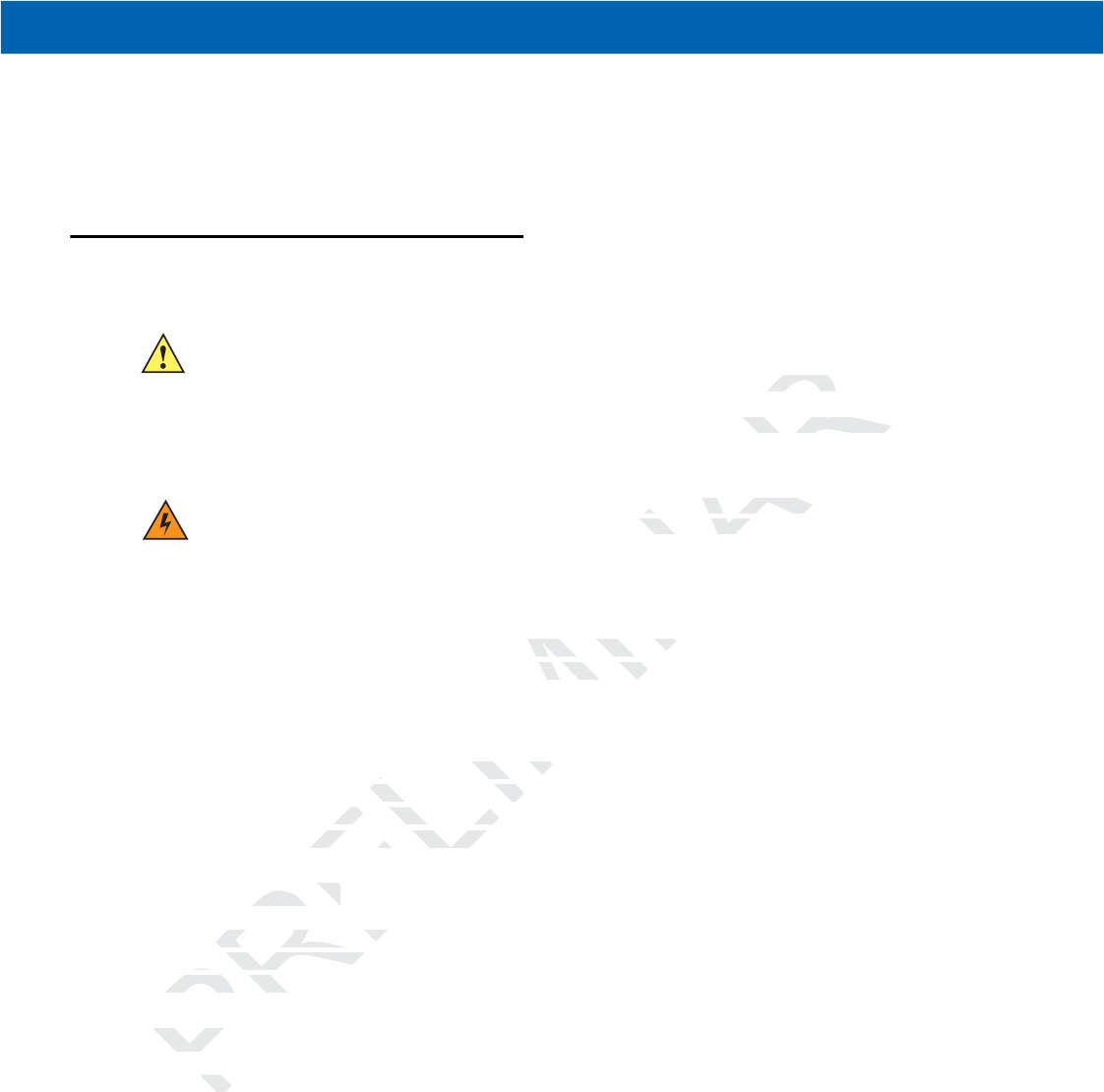
Maintenance & Troubleshooting 7 - 3
•
In the event of a battery leak, do not allow the liquid to come in contact with the skin or eyes. If contact
has been made, wash the affected area with large amounts of water and seek medical advice.
•
If you suspect damage to your equipment or battery, contact Motorola Enterprise Mobility support to
arrange for inspection.
Cleaning
Approved Cleanser Active Ingredients
100% of the active ingredients in any cleaner must consist of one or some combination of the following:
isopropyl alcohol, bleach/sodium hypochlorite, hydrogen peroxide or mild dish soap.
Harmful Ingredients
The following chemicals are known to damage the plastics on the MC21XX and should not come in contact
with the device: ammonia solutions, compounds of amines or ammonia; acetone; ketones; ethers; aromatic
and chlorinated hydrocarbons; acqueous or alcoholic alkaline solutions; ethanolamine; toluene;
trichloroethylene; benzene; carbolic acid and TB-lysoform.
Cleaning Instructions
Do not apply liquid directly to the MC21XX. Dampen a soft cloth or use pre-moistened wipes. Do not wrap the
device in the cloth or wipe, but gently wipe the unit. Be careful not to let liquid pool around the display window
or other places. Allow the unit to air dry before use.
Special Cleaning Notes
Many vinyl gloves contain phthalate additives, which are often not recommended for medical use and are
known to be harmful to the housing of the MC21XX. The MC21XX should not be handled while wearing vinyl
gloves containing phthalates, or before hands are washed to remove contaminant residue after gloves are
removed. If products containing any of the harmful ingredients listed above are used prior to handling the
MC21XX, such as hand sanitizer that contain ethanolamine, hands must be completely dry before handling the
MC21XX to prevent damage to the plastics.
Materials Required
•
Alcohol wipes
•
Lens tissue
CAUTION Always wear eye protection.
Read warning label on compressed air and alcohol product before using.
If you have to use any other solution for medical reasons please contact Motorola for more
information.
WARNING!Avoid exposing this product to contact with hot oil or other flammable liquids. If such
exposure occurs, unplug the device and clean the product immediately in accordance with
these guidelines.
NARY
fore using.
fore using
please contact Motorol
ease contact Motoro
ith hot oil or other flam
ith hot oil or other fla
PRELIMINA
ner must consist of onmust consist of on
hlorite, hydrogen perohlorite, hydrogen pero
known to damage theknown to damage th
solutions, compoundolutions, compoun
arbons; acqueous or
arbons; acqueous o
enzene; carbolic acid a
enzene; carbolic acid a
ructions
ructions
pply liquid directly to
pply liquid directly to
e in the cloth or wipe,
e in the cloth or wipe,
other places. Allow thother places. A
cial Cleaningcial Cle
vinyl gvinyl
d clean the product im
clean the prod

7 - 4 MC21XX Series User Guide
•
Cotton tipped applicators
•
Isopropyl alcohol
•
Can of compressed air with a tube.
Cleaning the MC21XX
Housing
Using the alcohol wipes, wipe the housing including keys and in-between keys.
Display
The display can be wiped down with the alcohol wipes, but care should be taken not to allow any pooling of
liquid around the edges of the display. Immediately dry the display with a soft, non-abrasive cloth to prevent
streaking.
Scanner Exit Window
Wipe the scanner exit window periodically with a lens tissue or other material suitable for cleaning optical
material such as eyeglasses.
Connector
1. Remove the main battery from MC21XX. See Main Battery Removal on page 1-8.
2. Dip the cotton portion of the cotton tipped applicator in isopropyl alcohol.
3. Rub the cotton portion of the cotton tipped applicator back-and-forth across the connector on the bottom of
the MC21XX. Do not leave any cotton residue on the connector.
4. Repeat at least three times.
5. Use the cotton tipped applicator dipped in alcohol to remove any grease and dirt near the connector area.
6. Use a dry cotton tipped applicator and repeat steps 4 through 6.
7. Spray compressed air on the connector area by pointing the tube/nozzle about ½ inch away from the
surface.
8. Inspect the area for any grease or dirt, repeat if required.
Cleaning Cradle Connectors
To clean the connectors on a cradle:
1. Remove the DC power cable from the cradle.
2. Dip the cotton portion of the cotton tipped applicator in isopropyl alcohol.
3. Rub the cotton portion of the cotton tipped applicator along the pins of the connector. Slowly move the
applicator back-and-forth from one side of the connector to the other. Do not let any cotton residue on the
connector.
CAUTION Do not point nozzle at yourself and others, ensure the nozzle or tube is away from your face.
e taken not to allow a
aken not to allow a
h a soft, non-abrasive
h a soft, non-a
sue or other material s
sue or other materia
X. See
X. S
Main Battery R
Main Battery R
tipped applicator in is
tipped applicator in is
otton tipped applicato
pped applica
any cotton residue onany cotton residue on
mes.
mes
ped applicator dipped
ped applicator dipped
on tipped applicator aon tipped applicator a
Spray compressed aSpray compressed a
urface.urface.
ct the act the
AUTION
ON
Do not point n
Do not point n
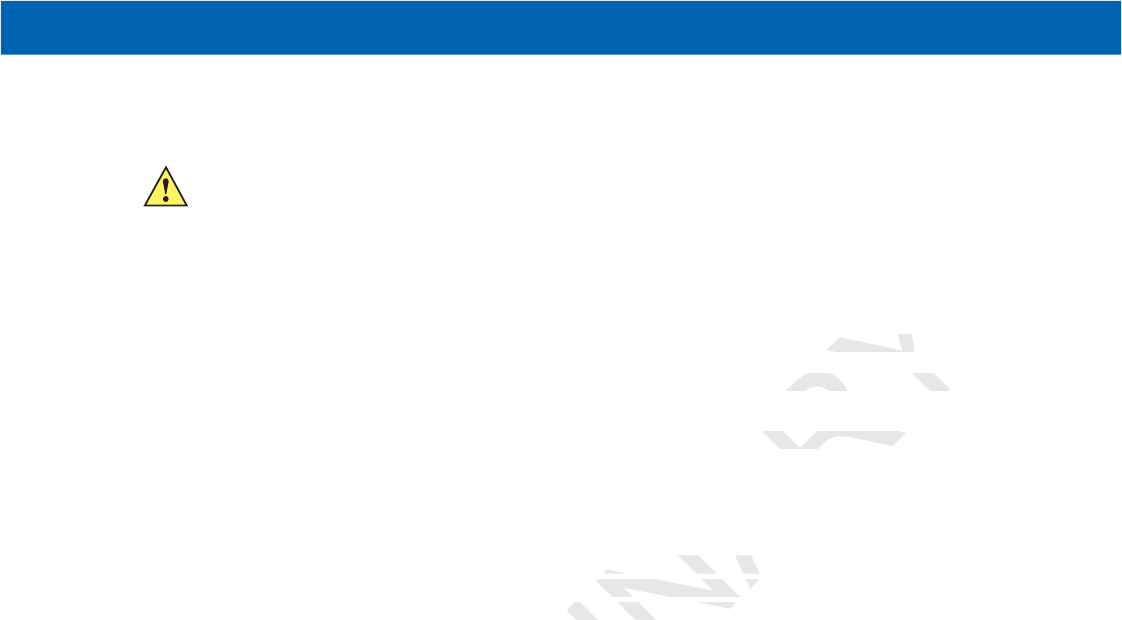
Maintenance & Troubleshooting 7 - 5
4. All sides of the connector should also be rubbed with the cotton tipped applicator.
5. Spray compressed air in the connector area by pointing the tube/nozzle about ½ inch away from the
surface.
6. Ensure that there is no lint left by the cotton tipped applicator, remove lint if found.
7. If grease and other dirt can be found on other areas of the cradle, use lint free cloth and alcohol to remove.
8. Allow at least 10 to 30 minutes (depending on ambient temperature and humidity) for the alcohol to air dry
before applying power to cradle.
If the temperature is low and humidity is high, longer drying time is required. Warm temperature and dry
humidity requires less drying time.
Cleaning Frequency
The cleaning frequency is up to the customer’s discretion due to the varied environments in which the mobile
devices are used. They may be cleaned as frequently as required. However when used in dirty environments it
may be advisable to periodically clean the scanner exit window to ensure optimum scanning performance.
CAUTION Do not point nozzle at yourself and others, ensure the nozzle or tube is away from your face.
PRELIMINARY
d.
ee cloth and alcoho
ee cloth and
d humidity) for the alco
d humidity) for the a
is required. Warm tem
equired. Warm te
tion due to the varied
tion due to the vari
tly as required. Howev
y as required. Howev
ner exit window to ens
er exit window to ens
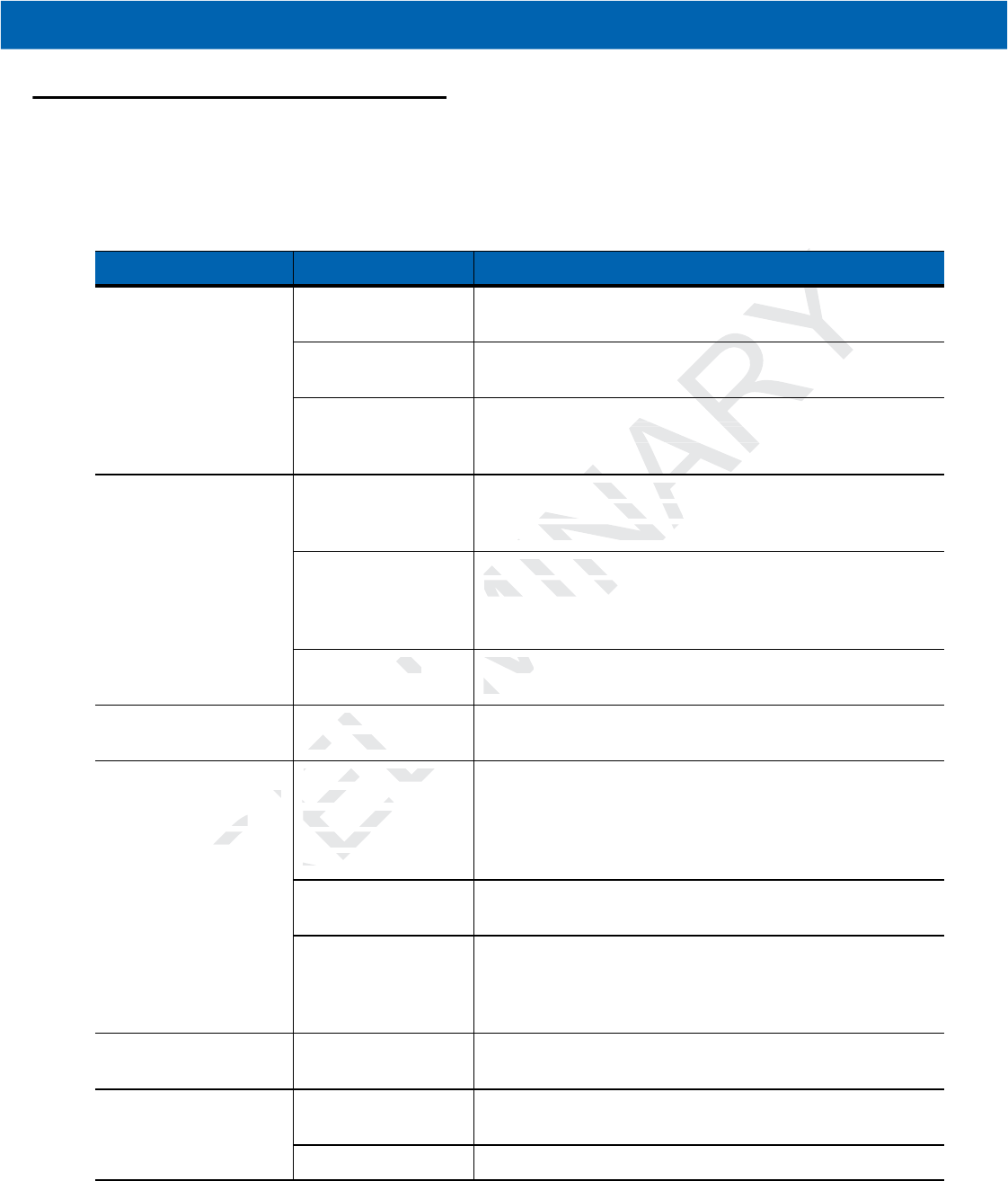
7 - 6 MC21XX Series User Guide
Troubleshooting
MC21XX
Table 7-1
Troubleshooting the MC21XX
Problem Cause Solution
MC21XX does not turn
on.
Main battery not
charged.
Charge or replace the main battery.
Main battery not
installed properly.
Ensure the battery is installed properly. See
Install Main
Battery on page 1-4
.
System crash. Perform a warm boot. If the MC21XX still does not turn on,
perform a cold boot. For more information see,
Resetting the
MC21XX on page 2-12
.
Battery did not charge. Battery failed. Replace battery. If the MC21XX still does not operate, try a
warm boot, then a cold boot. For more information see,
Resetting the MC21XX on page 2-12
.
MC21XX removed
from power source
while battery was
charging.
Connect power source and begin charging. The battery
requires up to four hours to recharge fully.
Extreme battery
temperature.
Battery does not charge if ambient temperature is below
32°F (0°C) or above 104°F (40°C).
Cannot see characters
on screen.
MC21XX not
powered on.
Press the Power button.
During data
communication, no data
was transmitted, or
transmitted data was
incomplete.
MC21XX removed
from cradle or
unplugged from host
computer during
communication.
Replace the MC21XX in the cradle, or reattach the cable and
re-transmit.
Incorrect cable
configuration.
See the system administrator or refer to the MC21XX Series
MC21XX Integrator Guide.
Communication
software was
incorrectly installed or
configured.
See the system administrator or refer to the MC21XX Series
MC21XX Integrator Guide.
MC21XX does not emit
sound.
Volume setting is low
or turned off.
Increase the volume. See
Adjusting the Volume on page
2-4
for more information.
MC21XX turns itself off. MC21XX is inactive. The MC21XX turns off after a period of inactivity. This period
can be set from one to five minutes, in one-minute intervals.
Battery is depleted. Recharge or replace the battery.
Y
ed properly. See
ed properly
Insta
sta
ot. If the MC21XX still d
ot. If the MC21X
ot. For more informatio
. For more informa
age 2-12
-12
.
Y
Y
RY
AR
INA
attery. If the MC21XX
ry. If the MC
oot, then a cold boot.
oot, then a cold boo
etting the MC21XX on
etting the MC21XX on
MIN
Connect power source
Connect power s
requires up to four
requires up to four
M
LIM
attery
tery
ature.
Battery d
Battery
32°F (32
IM
ELIM
21XX not 1XX
powered on.powered on
P
IM
NA
IN
M
LIM
PREL
data
a
or
or
ta was ta w
MC21XX removedMC21XX removed
from cradle or
from cradle o
unplugged fr
unplugged fr
computeromputer
commu
commu
In
RE
EL
R
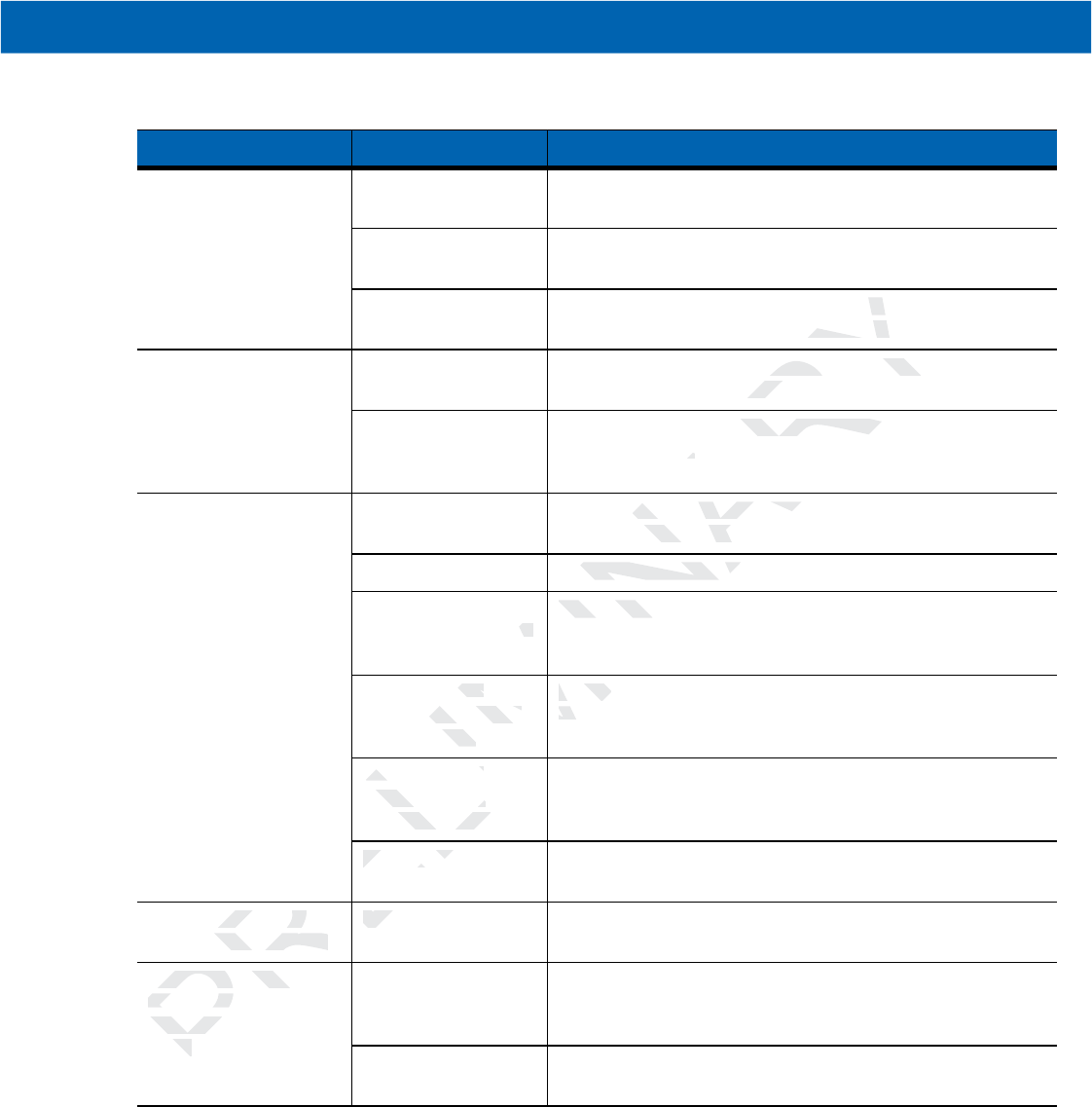
Maintenance & Troubleshooting 7 - 7
Tapping the window
buttons or icons does
not activate the
corresponding feature.
Touch screen not
calibrated correctly.
Re-calibrate the screen. Tap Start > Control Panel >Stylus
>Calibration tab. Tap the Recalibrate button.
MC2100 does not
have a touch screen.
Normal operation.
The system crashed. Warm boot the system. To perform a warm boot, see
Resetting the Mobile Computer on page 2-27
.
A message appears
stating that the
MC21XX memory is full.
Too many files stored
on the MC21XX.
Delete unused memos and records. If necessary, save these
records on the host computer.
Too many
applications installed
on the MC21XX.
Remove unused installed applications from the MC21XX to
recover memory.
The MC21XX does not
accept scan input.
Scanning application
is not loaded.
Verify that the MC21XX is loaded with a scanning
application. See the system administrator.
Unreadable bar code. Ensure the symbol is not defaced.
Distance between
scan window and bar
code is incorrect.
Ensure the MC21XX is within proper scanning range.
MC21XX is not
programmed for the
bar code type.
Ensure the MC21XX is programmed to accept the type of
bar code scanned.
MC21XX is not
programmed to
generate a beep.
If a beep on a good decode is expected and a beep is not
heard, check that the application is set to generate a beep
on good decode.
Battery is low. Check the battery level. When the battery is low, the
MC21XX automatically goes into suspend mode.
Warning appears on
screen during boot up.
Battery not removed
properly.
Follow Battery Swap procedure. See
Main Battery Removal
on page 1-8
.
MC21XX performs a
cold boot after
performing a Battery
Swap
Battery Swap
Procedure not
followed.
Follow Battery Swap procedure. See
Main Battery Removal
on page 1-8
.
Backup battery not
adequately charged.
Ensure backup battery charges fully. See
Battery Charging
on page 1-5
.
Table 7-1
Troubleshooting the MC21XX (Continued)
Problem Cause Solution
NARY
m a warm bo
wa
er on page 2-27
er on page
.
d records. If necessary
d records. If necessa
mputer.
mpute
stalled applications fro
led applications fr
y.
y.
at the MC21XX is load
at the MC21XX is load
cation. See the system
n. See the s
Y
RY
RY
A
INA
Ensure the symbol is n
sure the symbol is n
MIN
bar ar
ct.
Ensure the MC21X
Ensure the M
M
LIM
s not not
mmed for the
med for the
code type.
type.
Ensure Ensure
bar c
ba
M
RELIM
MC21XX is not MC21XX is not
programmed to
rogrammed to
generate a beep
erate a beep
Battery is lo
Battery is lo
RE
NA
IN
M
LIM
PRE
appears on
appears on
n during boot up.
during boot up.
Batt
Batt
p
RE
EL
RE
PR
MC21XX performs a MC21XX performs
cold boot after cold boot a
performing a Battperformin
apap
PR
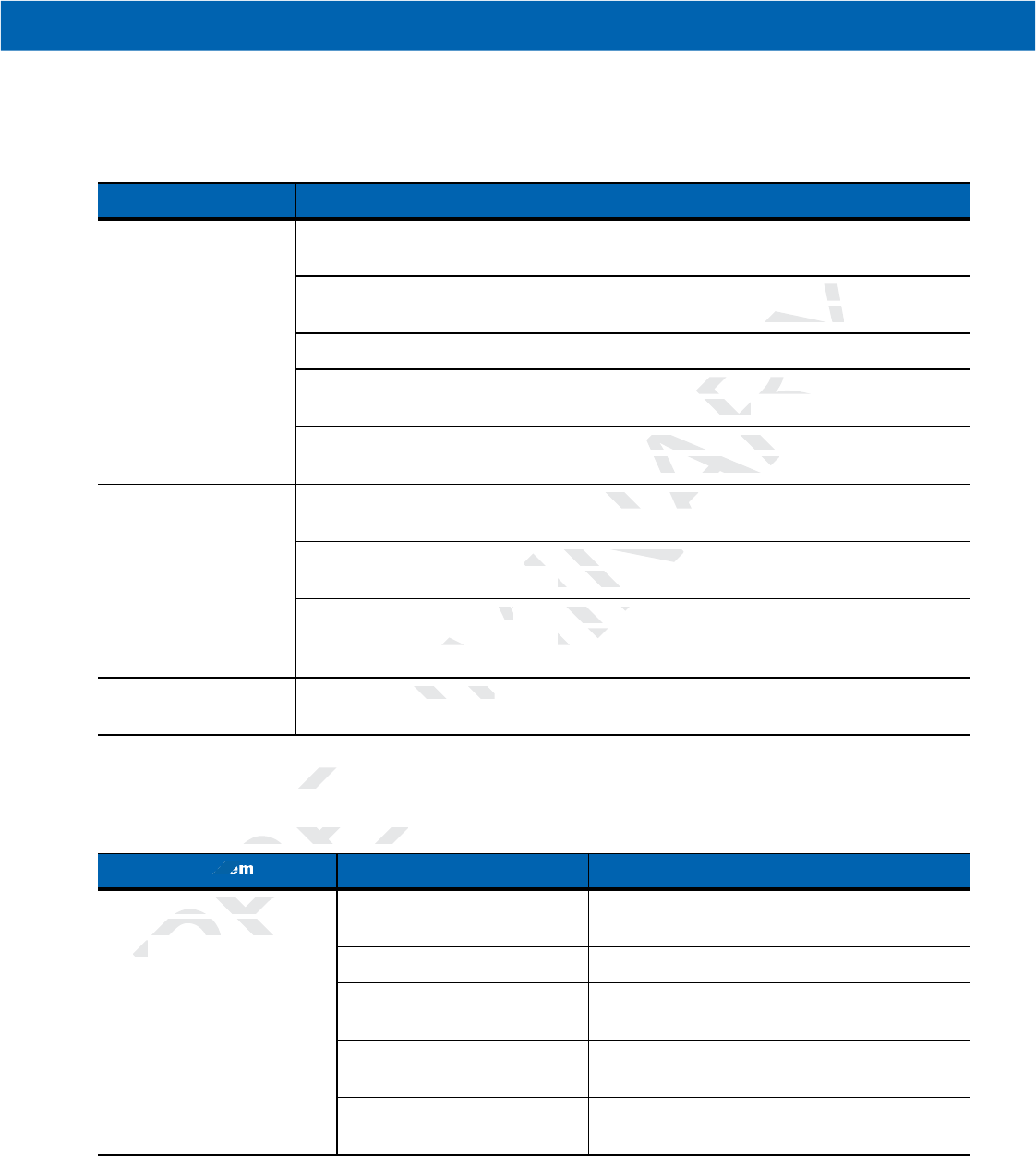
7 - 8 MC21XX Series User Guide
Single-slot USB Cradle
Four-slot Charge Only Cradle
Table 7-2
Troubleshooting the Single-slot USB Cradle
Symptom Possible Cause Solution
MC21XX battery is not
charging (LED
Indicator does not
light).
Cradle is not receiving power. Ensure the power cable is connected securely to
both the cradle and to AC power.
MC21XX was removed from
cradle too soon.
If the MC21XX battery is fully depleted, it can take up
to five hours to fully recharge a battery.
No battery installed. Install battery.
Battery is faulty. Verify that other batteries charge properly. If so,
replace the faulty battery.
The MC21XX is not fully
seated in the cradle.
Remove and re-insert the MC21XX into the cradle,
ensuring it is correctly seated.
During data
communication, no
data was transmitted,
or transmitted data was
incomplete.
MC21XX removed from cradle
during communication.
Replace MC21XX in cradle and retransmit.
Incorrect cable configuration. See the system administrator or refer to the
MC21XX Series Integrator Guide.
Communication software is
not installed or configured
properly.
See the system administrator or refer to the
MC21XX Series Integrator Guide.
Peripheral device not
working properly.
Incorrect communication
cable used.
Obtain correct cable from vendor. Cable should be
microUSB A to USB B.
Table 7-3
Troubleshooting the Four-slot Charge Only Cradle
Problem Cause Solution
MC21XX battery is not
charging (Indicator does not
light).
Cradle is not receiving power. Ensure the power cable is connected securely
to both the cradle and to AC power.
No battery installed. Install battery.
Battery is faulty. Verify that other batteries charge properly. If so,
replace the faulty battery.
MC21XX was removed from
cradle too soon.
If the MC21XX battery is fully depleted, it can
take up to five hours to fully recharge a battery.
The MC21XX is not fully
seated in the cradle.
Remove and re-insert the MC21XX into the
cradle, ensuring it is correctly seated.
NARY
depleted, it c
ted
ge a battery.
ge a batter
batteries charge prope
atteries charge
lty battery.
attery.
nd re-insert the MC21
d re-insert the MC
g it is correctly seated
s correctly seated
Y
RY
RY
AR
NA
eplace MC21XX in crad
ce MC21XX
MINA
n. See the system a
. See the system a
MC21XX Serie
MC21XX
MI
IMIN
ware is
is
nfigured
nfig
See the s
See the s
MC21X
MC21X
MI
LIM
ommunication
munication
sed.
M
RELI
CradleCradle
RE
NA
NA
MIN
IM
LI
shooting the Four-sloshooting the Four-slo
RE
RE
blem
RE
RE
PR
X battery is not X battery is no
ing (Indicator does noing (Indicator do
ht).ht).
R
R
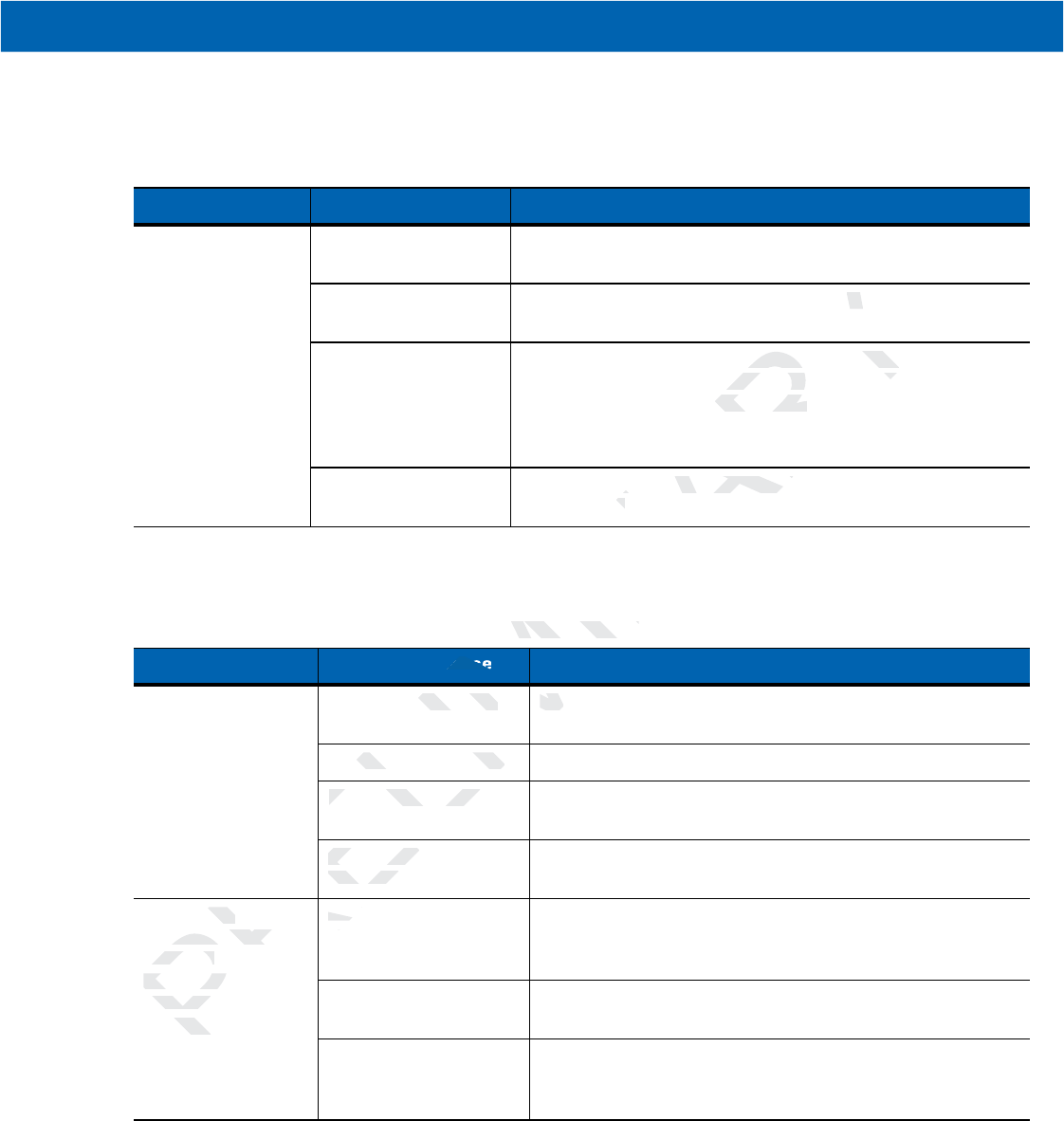
Maintenance & Troubleshooting 7 - 9
Four-slot Spare Battery Charger
USB ActiveSync/Charge Cable
Table 7-4
Troubleshooting the Four-slot Spare Battery Charger
Symptom Possible Cause Solution
Spare battery is not
charging (Spare
Battery Charging
LED does not light).
Charger is not
receiving power.
Ensure the power cable is connected securely to both the
charger and to AC power.
Spare battery is not
correctly seated.
Remove and re-insert the battery into the charger, ensuring it is
correctly seated.
Spare battery was
removed from charger
or charger was
unplugged from AC
power too soon.
Ensure charger is receiving power. Ensure the spare battery is
seated correctly. If a battery is fully depleted, it can take up to
five hours to fully recharge a battery.
Spare battery is faulty. Verify that other batteries charge properly. If so, replace the
faulty battery.
Table 7-5
Troubleshooting the USB ActiveSync/Charge Cable
Symptom Possible Cause Solution
MC21XX battery is
not charging (LED
Indicator does not
light).
Cable is not receiving
power.
Ensure the power cable is connected securely to both the
cable and to AC power.
No battery installed. Install battery.
Battery is faulty. Verify that other batteries charge properly. If so, replace the
faulty battery.
The MC21XX is not fully
seated in the cable.
Remove and re-attach the MC21XX to the cable, ensuring it
is correctly seated.
During data
communication, no
data was
transmitted, or
transmitted data was
incomplete.
Cable removed from
MC21XX during
communication.
Reattach cable to MC21XX and retransmit.
Incorrect cable
configuration.
See the system administrator or refer to the MC21XX Series
MC21XX Integrator Guide.
Communication
software is not installed
or configured properly.
See the system administrator or refer to the MC21XX Series
MC21XX Integrator Guide.
RELIMINARY
o the charge
ch
power. Ensure the spa
power. Ensure the s
ry is fully depleted, it c
ry is fully depleted, it c
rge a battery.
ge a battery.
her batteries charge p
her batteries charge p
ery.
y
Y
RY
AR
NA
eSync/Charge Cable
c/Charge Cable
M
Cause
MI
not receiving
t receiving
Ensu
Ens
ca
o battery installed.battery installed.
Battery is faulty.Battery is faulty.
The MC21XThe MC21X
seated inseated in
RE
M
MI
M
LIM
EL
RE
PRE
g data data
mmunication, no mmunication,
data was
data was
transmitted, or transmitted
ransmitted data wransmitt
omplete.omple
CablCabl
MM
RE
RE

7 - 10 MC21XX Series User Guide
PRELIMINARY
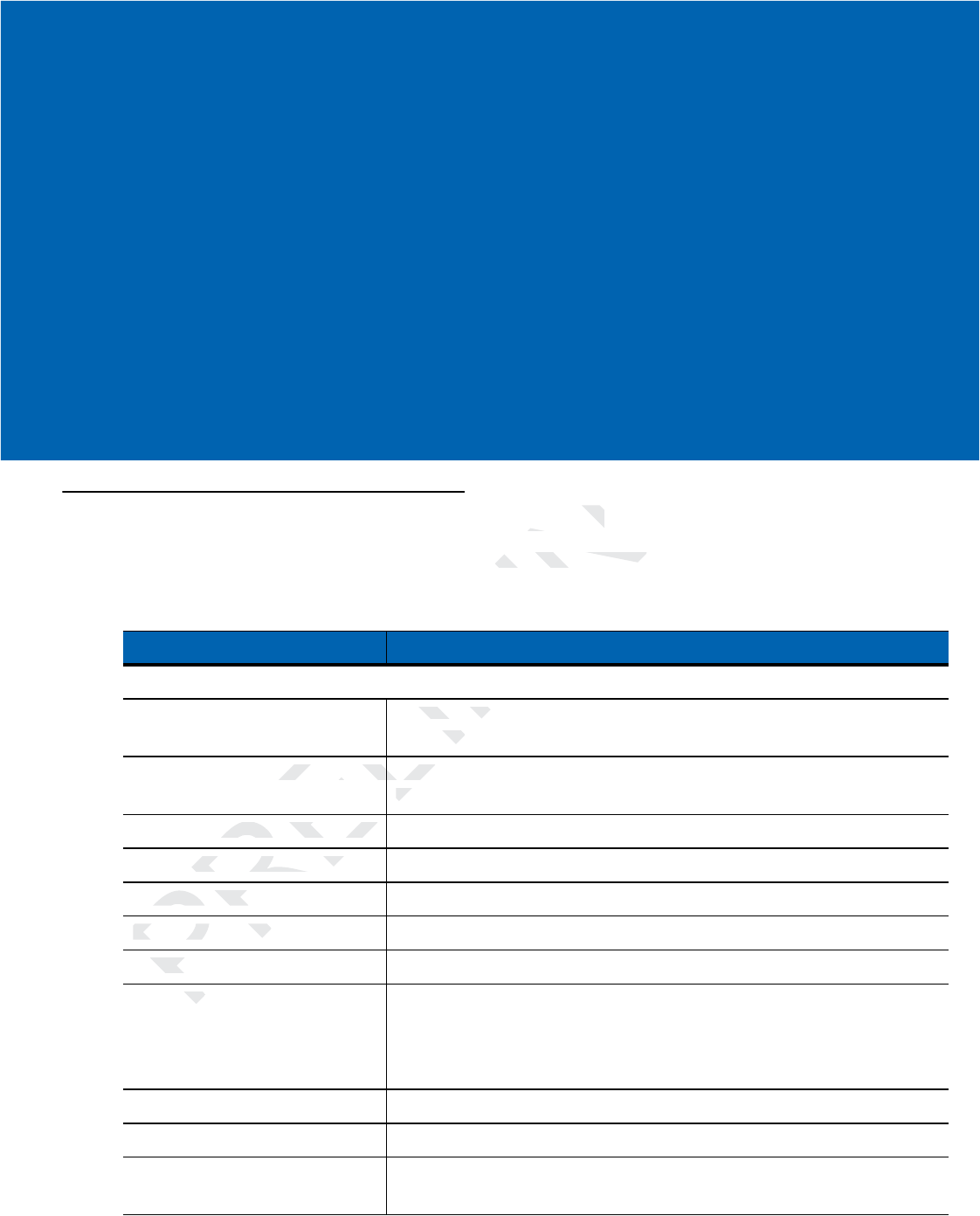
Appendix A Specifications
MC21XX and Accessory Technical Specifications
Table A-1 summarizes the MC21XX technical specifications and intended operating environments.
Table A-1
MC21XX Technical Specifications
Item Description
Physical Characteristics
Dimensions 171.7 mm L x 60.9 mm W x 34.1 mm D
(6.76 in L x 2.40 in W x 1.24 in D)
Weight (including battery) MC2100: 228 g (8.04 oz)
MC2180: 236 g (8.32 oz)
Display 2.8 inch TFT Color QVGA (240 x 320) display with backlight
Touch Panel Analog resistive touch (MC2180 only)
Backlight LED backlight
Battery Rechargeable Lithium-ion 2400 mAh minimum (3.7V)
Expansion Slot User accessible microUSB slot (located under battery); up to 32 GB.
Network Connections Full-speed USB (host or client)*
Bluetooth (MC2180 only)
WLAN (MC2180 only)
*USB available with appropriate cables only
Notification LED and audible alert
Keypad Options 27-key Numeric
Audio Speaker and microphone (MC2180 only)
Beeper (MC2100 only)
RELIMINAR
ARY
AR
cations
cations
ecifications and intend
ecifications and inten
ons
MI
171.7 mm L x1.7 mm L x
(6.76 in L xn L
attery) MC21
attery) MC21
MC
MC
ELI
MI
IM
LIM
EL
RE
PRE
Panel
Panel
PR
cklight
cklight
PR
Battery
Battery
RE
RE
PR
PR
P
xpansion Slotxpans
P
rk Crk C
P
P
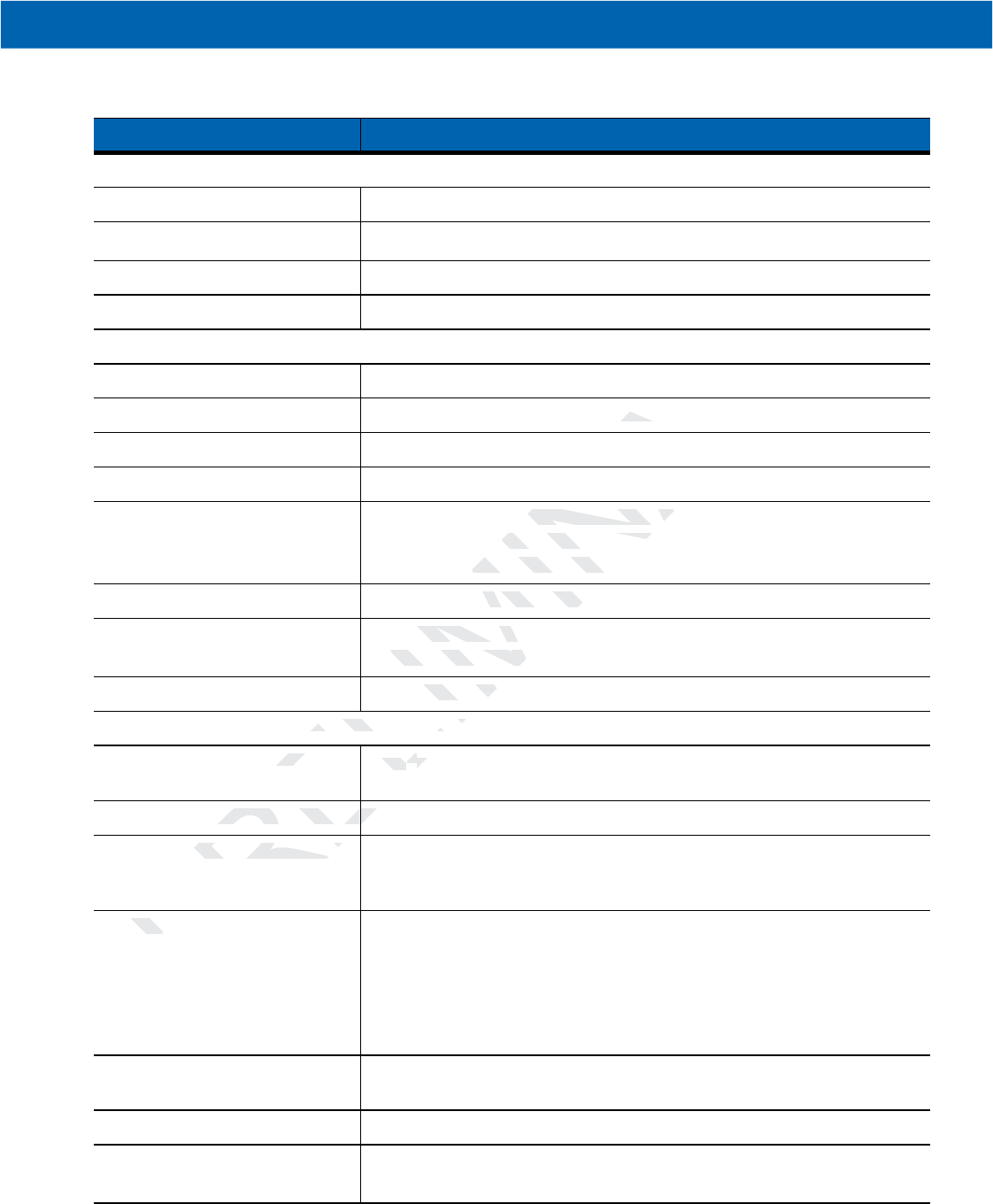
A - 2 MC21XX Series User Guide
Performance Characteristics
CPU Marvell PXA320 processor at 624 MHz
Operating System Microsoft
®
Embedded CE 6.0 Core
Memory 128 MB RAM/256 MB Flash
Output Power USB: 5 VDC @ 300 mA max.
User Environment
Operating Temperature -10°C to 50°C (-14°F to 122°F)
Storage Temperature -40° to 70°C (-40° to 158°F) without battery
Charging Temperature 0° C to 40° C (32°F to 104°F)
Humidity 5 to 95% non-condensing
Drop Specification Multiple 1.2 m (4 ft.) to concrete at room temperature
Multiple 0.9 m (3 ft.) to concrete across the operating temperature
Multiple 1.2 m (4 ft.) MIL-STD 810G specifications
Tumble 500 0.5 m (1.6 ft.) tumbles per IEC tumble specifications.
Electrostatic Discharge (ESD) +/-15 kV air discharge
+/- 8 kV direct discharge
Sealing IP54 per IEC sealing specifications.
Wireless LAN Data and Voice Communications
Wireless Local Area Network
(WLAN) radio IEEE
®
802.11b/g/n
Data Rates Supported 1, 2, 5.5, 6, 9, 11, 12, 18, 24, 36, 48, and 54 Mbps
Operating Channels Channel 1-13 (2412-2472 MHz), Channel 14 (2484 MHz) Japan only;
actual operating channels/frequencies depend on regulatory rules and
certification agency
Security Security Modes: Legacy, WPA and WPA2
Encryption: WEP (40 or 128 bit), TKIP and AES
Authentication: TLS, TTLS (MS-CHAP), TTLS (MS-CHAP v2), TTLS
(CHAP), TTLS (MD5), TTLS (PAP), PEAP-TLS, PEAP (MS-CHAP v2),
PEAP (EAP-GTC), EAP-FAST-TLS, EAP-FAST (MS-CHAP v2), EAP-FAST
(EAP-GTC) and LEAP
Spreading Technique Direct Sequence Spread Spectrum (DSSS) and Orthogonal Frequency
Division Multiplexing (OFDM)
Antenna Internal
Voice Communication TEAM Express push-to-talk over WLAN
Wi-Fi Multimedia (WMM)
Table A-1
MC21XX Technical Specifications (Continued)
Item Description
ARY
ut battery
ut ba
NAR
g
MINA
to concrete at room te
o concrete at room t
ft.) to concrete across
ft.) to concrete across
m (4 ft.) MIL-STD 810Gm (4 ft.) MIL-STD 81
Y
Y
RY
RY
AR
AR
NA
NA
MIN
m (1.6 ft.) tumbles per ft.) tumbles pe
LIM
5 kV air discharge 5 kV air discharg
+/- 8 kV direct discharg
8 kV direct discha
LIM
IP54 per IEC seal
IP54 per IEC sea
L
ELI
oice Communicationsoice Communications
MIN
M
LIM
LI
REL
etwork etwor
IEEEEEE
®®
88
®®
EL
RE
pported 1pported 1
E
EL
RE
PRE
Channelshannels
RE
PR
curity
curity
PR
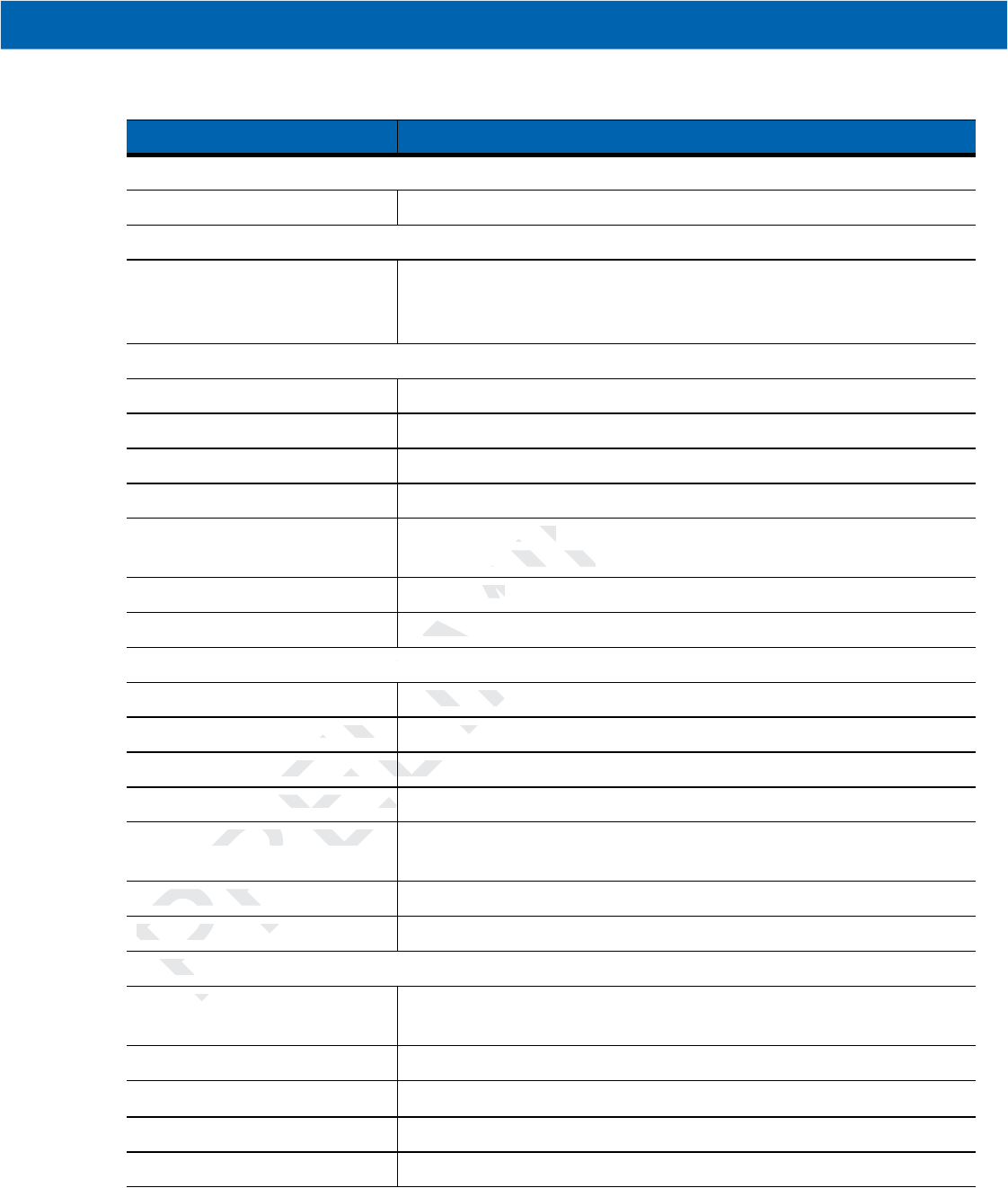
Specifications A - 3
Wireless PAN (MC2180 only)
Bluetooth v2.0 with Enhanced Data Rate (EDR); integrated antenna
Data Capture Specifications
Options Linear imager
1D laser scanner
2D imager
Linear Imager Specifications
Optical Resolution 5 mil minimum element width
Roll ± 25° from vertical
Pitch Angle ± 65° from normal
Skew Tolerance ± 50° from normal
Ambient Light Sunlight - 9,690 Lux
Artificial Light - 4,845 Lux
Scan Rate 50 scans/sec
Scan Angle 53.3° ± 3°
1D Laser Scanner Specifications
Optical Resolution 5 mil minimum element width
Roll ± 35° from vertical
Pitch Angle ± 65° from normal
Skew Tolerance ± 40° from normal
Ambient Light Sunlight - 107,640 Lux
Artificial Light - 4,844 Lux
Scan Rate 104 (± 12) scans/sec (bidirectional)
Scan Angle 47° (typical)
2D Imager Engine Specifications
Field of View Horizontal: 39.2°
Vertical: 25.4°
Optical Resolution 752 H x 480 V pixels (gray scale)
Roll
360°
Pitch Angle ± 60° from normal
Skew Tolerance ± 60° from normal
Table A-1
MC21XX Technical Specifications (Continued)
Item Description
PRELIMINARY
0 Lux
0 Lux
ght - 4,845 Lux
ght - 4,845 Lux
ns/sec
sec
3.3° ± 3°
3.3° ± 3
ns
s
5 mil minimummil minimum
± 35° from± 35° from
± 65°± 65°
e±
ightight
ELI
Y
RY
RY
AR
AR
NA
NA
MIN
MI
M
LIM
LI
EL
EL
RE
PR
can Ratecan Rate
PR
Scan AngleScan Angle
PR
PR
P
Imager EnImag
P
P
ViVi
P

A - 4 MC21XX Series User Guide
Ambient Light Sunlight - 96,900 Lux
Aiming Element (VLD) 655 nm ± 10 nm Laser
Illumination Element (LED) 625 nm ± 5 nm LEDs (2x)
Table A-1
MC21XX Technical Specifications (Continued)
Item Description
PRELIMINARY
Y

Appendix B Keypad
Introduction
The MC21XX is available with a 27-key keypad.
27-Key Keypad
The 27-key keypad contains a Power button, application keys, navigation pad and function keys. The keypad
is color-coded to indicate the alternate function key (blue) values and the alternate ALPHA key (orange)
values. Note that keypad functions can be changed by an application so the MC21XX keypad may not function
as described. See Table B-1 on page B-2 for key and button descriptions and Table B-2 on page B-4 for the
keypad alternate functions.
NOTE For information about using the soft keyboard input panel. For more information, see Entering Information
Using the Keyboard Input Panel on page 2-12.
MINAR
ARY
AR
ELIMI
ns as a
Power
button, aptton, ap
r
e the alternate functio
e the alternate functio
PREL
pad functions can be c
pad functions can be c
Table B-1 on page B-
Table B-1 on page B-
e functions.nctions.
e soft keyboard input pa
keyboard input
Panel on page 2-12Panel on page 2-12
.
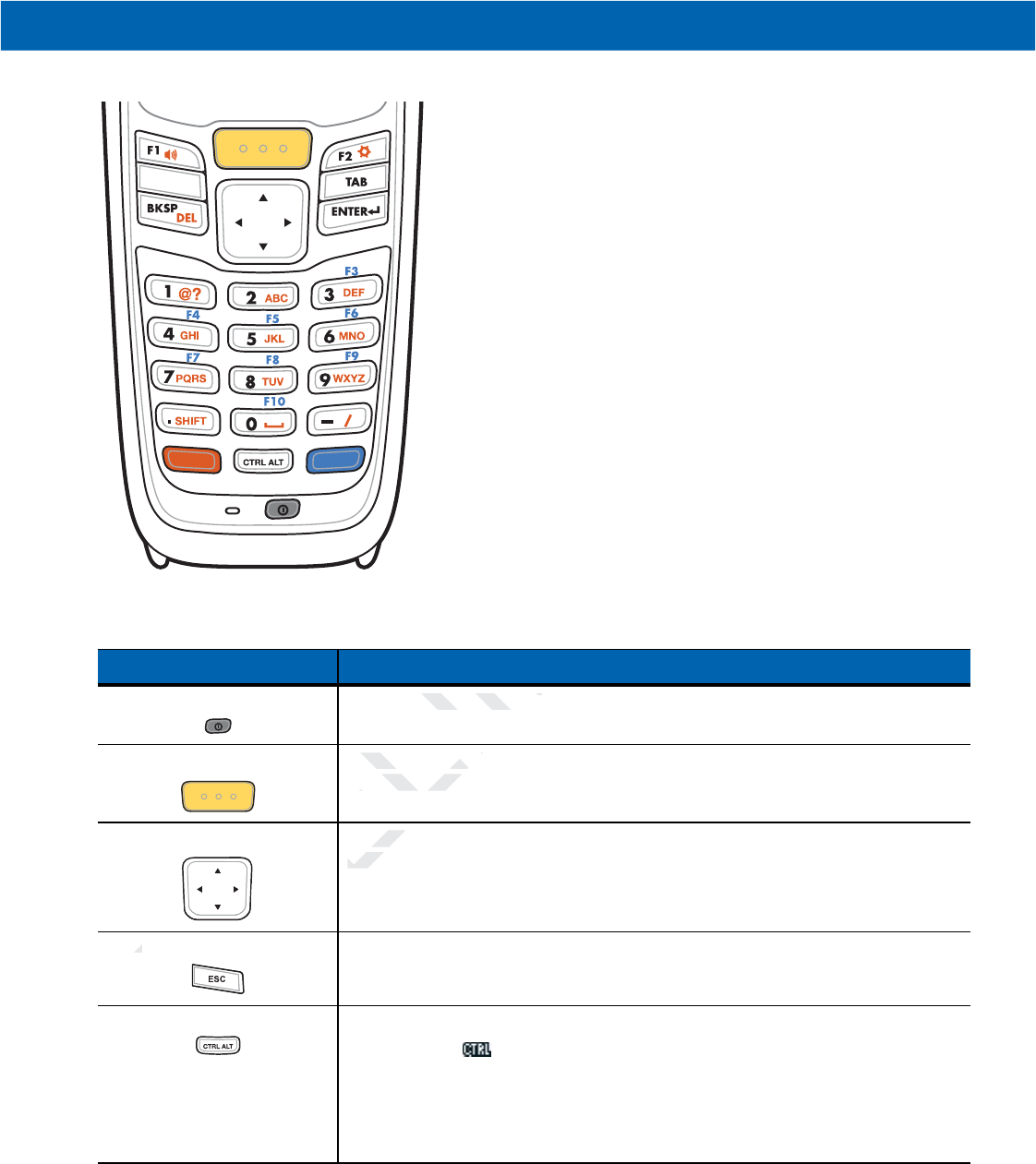
B - 2 MC21XX Series User Guide
Figure B-1
27-Key Keypad
Table B-1
27-Key Descriptions
Key Description
Power (red) Powers the MC21XX screen on and off (resume and suspend).
Scan (yellow) Used in scanning applications, press to scan a bar code. This key has the same
function as activating the side mounted scan buttons.
Navigation Pad Moves up, down, left and right from one item to another. Increases/decreases
specified values.
ESC Produces the ESC function by default.
CTRL Press and release the CTRL key to activate the keypad alternate CTRL
functions. The icon appears on the taskbar. Press and release the CTRL
key again to return to the default keypad functions.
Press and release the blue FUNC key and then the CTRL key to activate the
ALT functions. The icon appears on the taskbar. Press and release the
CTRL key two times to return to the default keypad functions.
ESC
ESC
ALT
PRELIMINARY
IM
wers the MC21XX scre
he MC21XX scre
Used in scanning sed in scanning
function as actiunction as acti
Moves u
ves u
spec
spec
CC
RE
M
IM
LI
RE
PR
P
PR
PR
PR
R
PR
R
P
P
P
P
P
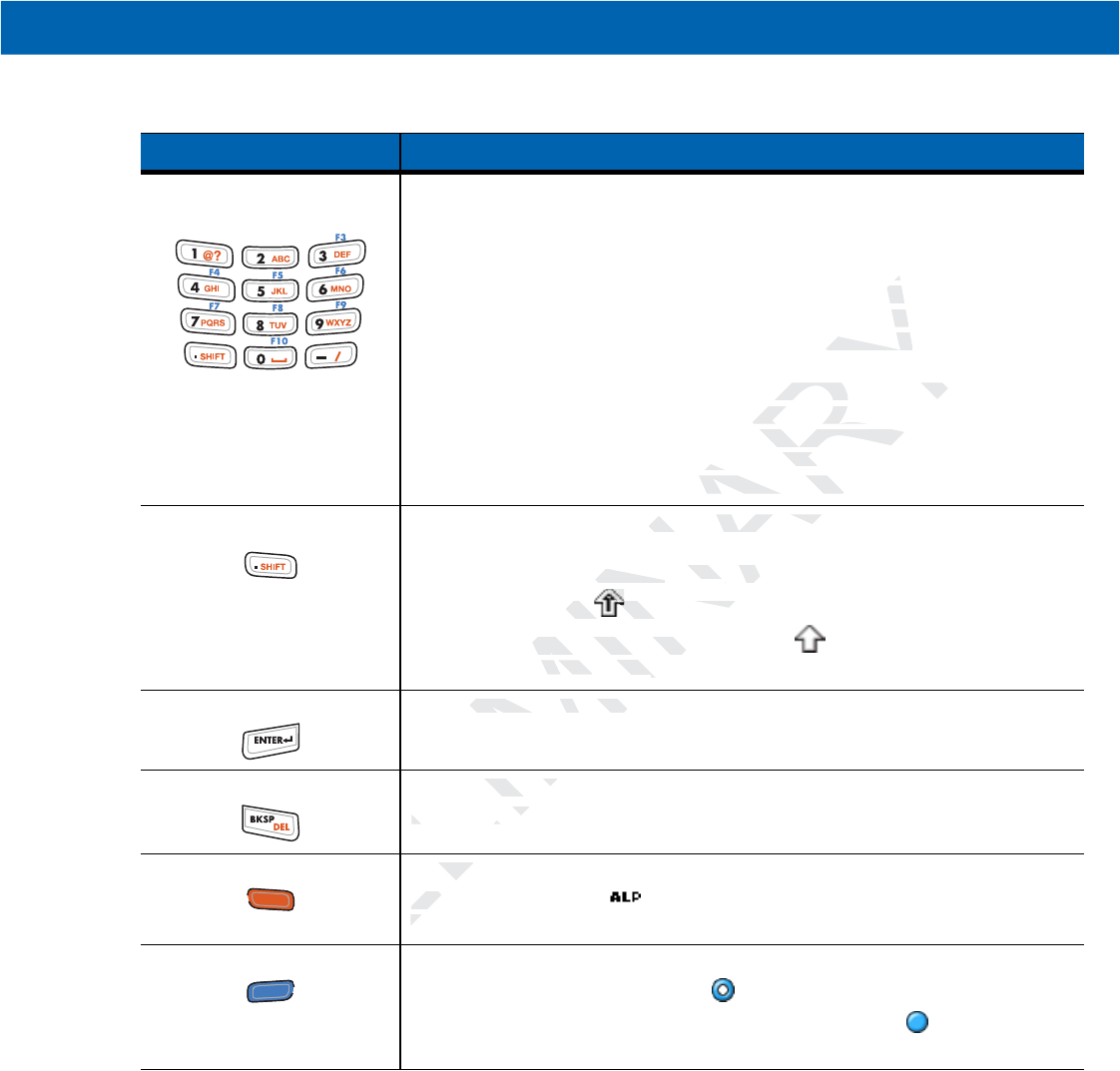
Keypads B - 3
Numeric/Alpha/Special
Function
Numeric, alpha or special function keys. Numeric by default.
Produces a special function when the blue FUNC key is activated.
Produces alpha values when the orange ALPHA key is activated.
In Alpha state, produces the lower case alphabetic characters on the key. Each
key press produces the next alphabetic character in sequence. For example,
press and release the ALPHA key and then press the 4 key once to produce the
letter ‘g’; press and release the ALPHA key and then press the 4 key three times
to produce the letter ‘i’.
When the SHIFT key is pressed in Alpha state, the upper case alphabetic
characters on the key are produced. For example, press and release the
ALPHA key, press and hold the SHIFT key and then press the 4 key once to
produce the letter ‘G’; press and release the ALPHA key, press and hold the
SHIFT key and then press the 4 key three times to produce the letter ‘I’.
Period/Decimal Point Produces a period for alpha entries and a decimal point for numeric entries by
default.
Press the Orange key then the SHIFT key to activate the keypad alternate
SHIFT functions. The icon appears on the taskbar. Press the SHIFT key a
second time to enable Shift-Lock feature. The icon appears on the taskbar.
Press and release the SHIFT key again to return to the default keypad functions.
Enter Executes a selected item or function.
BKSP Backspace function by default.
Decreases brightness when the blue FUNC key is activated.
Orange Press the orange key to access the alternate ALPHA characters (shown on the
keypad in orange). The icon appears on the taskbar. Press and release the
orange key again to return to the default keypad functions.
Blue Press and release the blue key to activate the keypad alternate functions
(shown on the keypad in blue). The icon appears on the taskbar. Press and
release the blue key a second time to lock the function. The icon appears on
the taskbar. Press and release again to return to the default keypad functions.
Table B-1
27-Key Descriptions (Continued)
Key Description
PRELIMINARY
te
te
quence
en
4
key once t
y o
en press the
en press th
4
key
ate, the upper case alp
ate, the upper case al
example, press and re
example, pres
T
key and then press t
y and then press t
ease the
ea
ALPHA
ALP
key,
key three times to pro
ey three times to p
entries and a decima
entries and a decima
y then the
then the
SHIFT
HIFT
key to
key
The icon appears
The icon appears
to enable Shift-Lock fe
enable Shift-Lock
release the
se the
SHIFT
HIFT
key
key
tes a selected item or
es a selected item o
Backspace functio
ce functio
Decreases brig
Decreases brig
Press th
ess th
keyp
keyp
or
or
EL
A
MI
LIM
EL
RE
P
R
R
R
R
R
PR
PR
PR
PR
PR
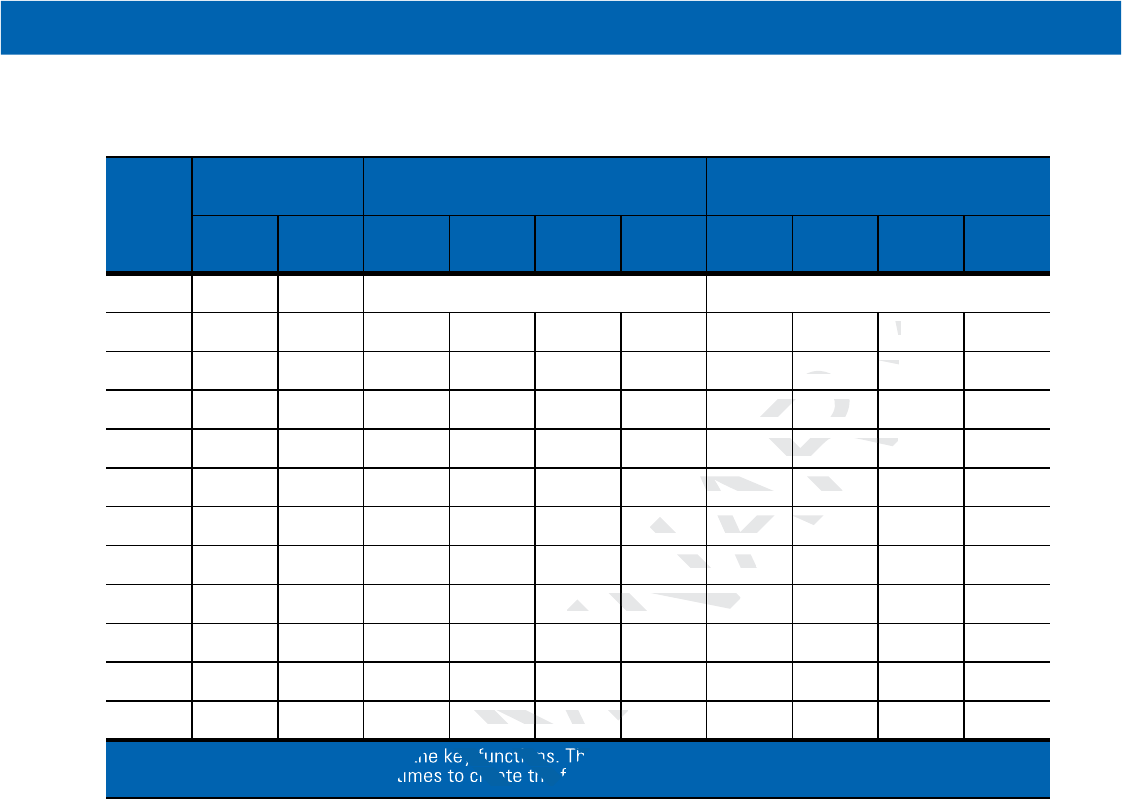
B - 4 MC21XX Series User Guide
Table B-2
27-key Keypad Input Modes
Key
Numeric Mode Orange Key
(Alpha Lowercase Mode)
Orange + Shift Keys
(Alpha Uppercase Mode)
SHIFT
+ Key
1st
Press
2nd
Press
3rd
Press
4th
Press
1st
Press
2nd
Press
3rd
Press
4th
Press
1 1 1 See Note 2 See Note 2
222abc ABC
333def DEF
444ghi GHI
555j kl JKL
666mno MNO
777pqr sPQRS
888t uv TUV
999wxyzWXYZ
0 0 0 space 0
..>. .
-/ ?
Note 1: An application can change the key functions. The keypad may not function exactly as described.
Note 2: Press the 1 key up to ten times to create the following characters: @ ? #$%^&*()
INARY
C
C
EF
EF
HI
H
JKL
KL
MN
MN
PQ
PQ
T
T
zW
zW
IN
NA
AR
RY
Y
Y
RY
RY
RY
AR
A
NA
NA
MIN
M
MIN
N
MI
M
MI
IM
I
M
M
LIM
ey functions. The
create the f
IN
MIN
M
IM
PRELI
LI

Keypads B - 5
PRELIMINARY

B - 6 MC21XX Series User Guide
PRELIMINARY

GLOSSARY
A
API. An interface by means of which one software component communicates with or controls another. Usually used to
refer to services provided by one software component to another, usually via software interrupts or function calls
Aperture. The opening in an optical system defined by a lens or baffle that establishes the field of view.
Application Programming Interface. See API.
ANSI Terminal. A display terminal that follows commands in the ANSI standard terminal language. For example, it uses
escape sequences to control the cursor, clear the screen and set colors. Communications programs support the
ANSI terminal mode and often default to this terminal emulation for dial-up connections to online services.
ASCII. American Standard Code for Information Interchange. A 7 bit-plus-parity code representing 128 letters,
numerals, punctuation marks and control characters. It is a standard data transmission code in the U.S.
Autodiscrimination. The ability of an interface controller to determine the code type of a scanned bar code. After this
determination is made, the information content is decoded.
B
Bar. The dark element in a printed bar code symbol.
Bar Code. A pattern of variable-width bars and spaces which represents numeric or alphanumeric data in
machine-readable form. The general format of a bar code symbol consists of a leading margin, start character, data
or message character, check character (if any), stop character, and trailing margin. Within this framework, each
recognizable symbology uses its own unique format. See Symbology.
Bar Code Density. The number of characters represented per unit of measurement (e.g., characters per inch).
Bar Height. The dimension of a bar measured perpendicular to the bar width.
RELIMINAR
ARY
AR
onent communicates w
nent communicates w
nent to another, usual
nent to another, u
ned by a lens or bafflea lens or baff
API
A
.
t follows commands in
commands
he cursor, clear the sc
e cursor, clear the sc
en default to this term
en default to this term
d Code for Informationd Code for Information
on marks and control
marks and control
n.n.
The ability of an inThe ability of an in
PR
on is made, the inform
n is made, the inform
PR
emem
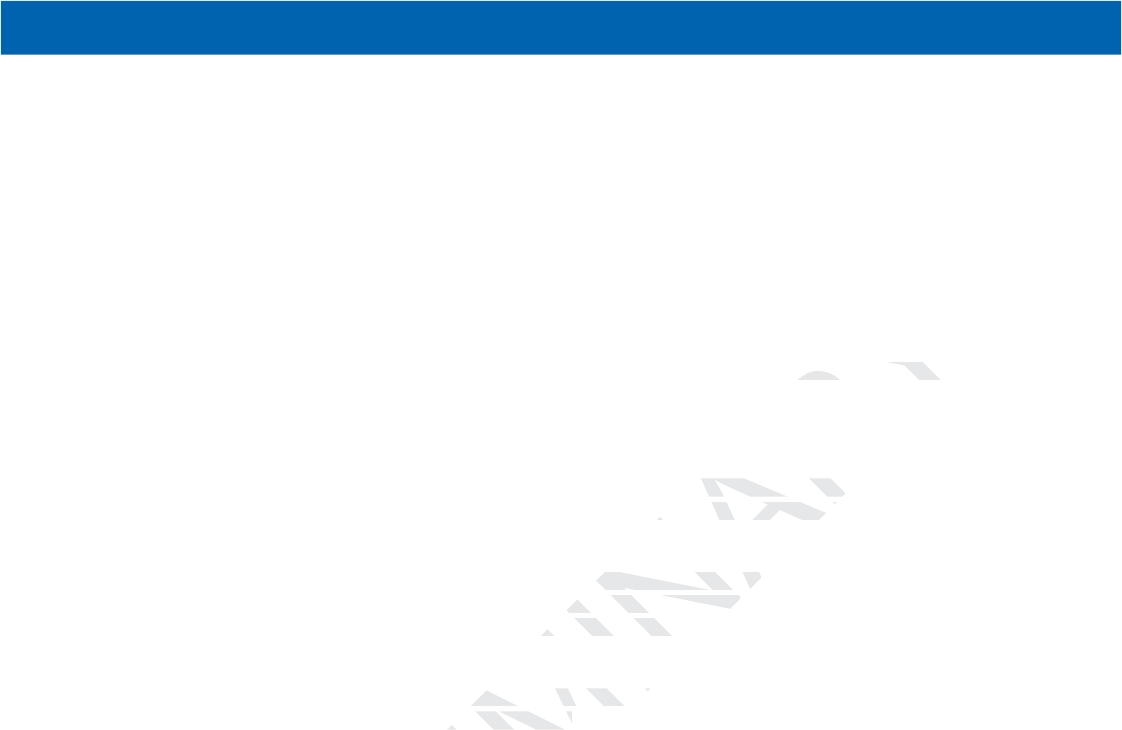
Glossary - 2 Enter Book Name Here
Bar Width. Thickness of a bar measured from the edge closest to the symbol start character to the trailing edge of the
same bar.
BIOS. Basic Input Output System. A collection of ROM-based code with a standard API used to interface with standard
PC hardware.
Bit. Binary digit. One bit is the basic unit of binary information. Generally, eight consecutive bits compose one byte of
data. The pattern of 0 and 1 values within the byte determines its meaning.
Bits per Second (bps). Bits transmitted or received.
Bit. Binary digit. One bit is the basic unit of binary information. Generally, eight consecutive bits compose one byte of
data. The pattern of 0 and 1 values within the byte determines its meaning.
bps. See Bits Per Second.
Byte. On an addressable boundary, eight adjacent binary digits (0 and 1) combined in a pattern to represent a specific
character or numeric value. Bits are numbered from the right, 0 through 7, with bit 0 the low-order bit. One byte in
memory is used to store one ASCII character.
BOOTP. A protocol for remote booting of diskless devices. Assigns an IP address to a machine and may specify a boot
file. The client sends a bootp request as a broadcast to the bootp server port (67) and the bootp server responds
using the bootp client port (68). The bootp server must have a table of all devices, associated MAC addresses and
IP addresses.
boot or boot-up. The process a computer goes through when it starts. During boot-up, the computer can run
self-diagnostic tests and configure hardware and software.
PRELIMINARY
ve bits compose one
ve bits compose
ombined in a pattern t
mbined in a pattern
ugh 7, with bit 0 the lo
ugh 7, with bit 0 the lo
ns an IP address to a
s an IP address to a
he bootp server port (6
e bootp server port (6
have a table of all dev
have a table of a
rough when it starts.
rough when it starts.
e and software.e and software.

INDEX
Numerics
27-key keypad . . . . . . . . . . . . . . . . . . . . . . . . . . . . . . B-1
2-D bar codes . . . . . . . . . . . . . . . . . . . . . . . . . . . . . . 3-1
A
accessories . . . . . . . . . . . . . . . . . . . . . . . . . . . . . . . . 1-2
four-slot charge only cradle . . . . . . . . . . . . . . . . 6-4
four-slot cradles
battery charging . . . . . . . . . . . . . . . . . . . . . . 6-4
four-slot spare battery charger
battery charging . . . . . . . . . . . . . . . . . . . . . . 6-7
LED indicators . . . . . . . . . . . . . . . . . . . . . . . 6-7
MC21XX charge cables
LED indicators . . . . . . . . . . . . . . . . . . . . . . 6-12
SD card . . . . . . . . . . . . . . . . . . . . . . . . . . . . . . . . 1-3
single-slot USB cradle . . . . . . . . . . . . . . . . . . . . 6-3
battery charging . . . . . . . . . . . . . . . . . . . . . . 6-3
stylus . . . . . . . . . . . . . . . . . . . . . . . . . . . . . . . . . 6-2
active and indicate programs . . . . . . . . . . . . . . . . . . 2-5
active tasks . . . . . . . . . . . . . . . . . . . . . . . . . . . . . . . . 2-9
ActiveSync . . . . . . . . . . . . . . . . . . . . . . . . . . . . . . . . . . iv
adaptive frequency hopping . . . . . . . . . . . . . . . . . . . 4-1
AFH . . . . . . . . . . . . . . . . . . . . . . . . . . . . . . . . . . . . . . 4-1
B
bar codes
two dimensional . . . . . . . . . . . . . . . . . . . . . . . . . 3-1
battery
charging . . . . . . . . . . . . . . . . . . . . . . . . . . . . . . . 1-5
install . . . . . . . . . . . . . . . . . . . . . . . . . . . . . . . . . 1-4
battery charge status . . . . . . . . . . . . . . . . . . . . . . . . 2-5
battery chargers
four slot-spare battery charger
battery charging . . . . . . . . . . . . . . . . . . . . . . 6-7
four-slot spare battery charger
LED indicators . . . . . . . . . . . . . . . . . . . . . . . . 6-7
MC21XX charge cables
LED indicators . . . . . . . . . . . . . . . . . . . . . . . 6-12
battery charging
backup battery . . . . . . . . . . . . . . . . . . . . . . . . . . . 1-5
four-slot cradles . . . . . . . . . . . . . . . . . . . . . . 6-4, 6-5
four-slot spare battery charger . . . . . . . . . . . . . . 6-7
main battery . . . . . . . . . . . . . . . . . . . . . . . . . . . . . 1-5
temperature range . . . . . . . . . . . . . . . . . . . . . . . . 1-5
battery icon . . . . . . . . . . . . . . . . . . . . . . . . . . . . . . . . 2-5
battery status . . . . . . . . . . . . . . . . . . . . . . . . . . . . . . . 2-5
Bluetooth . . . . . . . . . . . . . . . . . . . . . . . . . . . . . . . . . . 4-1
adaptive frequency hopping . . . . . . . . . . . . . . . . 4-1
security . . . . . . . . . . . . . . . . . . . . . . . . . . . . . . . . 4-2
bluetooth
discovering devices . . . . . . . . . . . . . . . . . . . . . . . 4-4
boot
cold . . . . . . . . . . . . . . . . . . . . . . . . . . . . . . . . . . . 4-3
warm . . . . . . . . . . . . . . . . . . . . . . . . . . . . . . . . . . 4-3
bullets . . . . . . . . . . . . . . . . . . . . . . . . . . . . . . . . . . . . . . iv
C
calibration screen . . . . . . . . . . . . . . . . . . . . . . . . . . . . 1-7
charge LED indicator . . . . . . . . . . . . . . . . . . . . . . . . . 1-2
charging
spare batteries . . . . . . . . . . . . . . . . . . . . . . . . . . . 1-7
charging battery . . . . . . . . . . . . . . . . . . . . . . . . . . . . . 1-5
charging, temperature range . . . . . . . . . . . . . . . . . . . 1-5
cleaning . . . . . . . . . . . . . . . . . . . . . . . . . . . . . . . . . . . 7-1
clock, display . . . . . . . . . . . . . . . . . . . . . . . . . . . . . . 2-10
cold boot . . . . . . . . . . . . . . . . . . . . . . . . . . . . . 2-13, 4-3
configuration . . . . . . . . . . . . . . . . . . . . . . . . . . . . . . . . . ii
conventions
notational . . . . . . . . . . . . . . . . . . . . . . . . . . . . . . . . iii
cradles
NAR
ARY
AR
PRELIMINA
. . . . 1-2
. . . . 1-2
. . . . . . . 6-4
. . . . . . . 6-4
. . . . . . . . . . . 6-4. . . . . . 6-4
. . . . . . . . . . . . . . . . 6. . . . . . . . . . . . . . . .
. . . . . . . . . . . . . . . .
. . . . . . . . . . . . . . .
. . . . . . . . . . . . . . . . .. . . . . . . . . . . . . . . .
. . . . . . . . . . . . . . . . .. . . . . . . . . . . . . . . .
cradle . . . . . . . . . . cradle . . . . . . . . . .
harging . . . . . . . . . . harging . . . . . . . . . .
. . . . . . . . . . . . . . . . .
. . . . . . . . . . . . . .
ndicate programs . .
ndicate progra
sks . . . . . . . . . . . . . .sks . . . . . . . . . . . .
P
ync . . . . . . . . . . . .ync . . . . . . . . . . . .
equency hoppequen
. . . . . . . . .
four-slot spare battery
ur-slot spare battery
LED indicators
LED indica
MC21XX charge
MC21XX charg
LED indic
LED indic
battery chargin
battery ch
backup
backup
four-s
fou
fou

Index - 2 MC21XX Series User Guide
four-slot charge only cradle . . . . . . . . . . . . . . . . . 6-4
four-slot cradles
battery charging . . . . . . . . . . . . . . . . . . . . . . 6-4
single-slot USB cradle
battery charging . . . . . . . . . . . . . . . . . . . . . . 6-3
troubleshooting . . . . . . . . . . . . . . . . . . . . . . . . . . 7-9
current time . . . . . . . . . . . . . . . . . . . . . . . . . . . . . . . . 2-5
D
data capture . . . . . . . . . . . . . . . . . . . . . . . . . . . . . . . . . . ii
dot aiming . . . . . . . . . . . . . . . . . . . . . . . . . . . . . . 3-4
imager operational modes
decode mode . . . . . . . . . . . . . . . . . . . . . . . . 3-2
image capture mode . . . . . . . . . . . . . . . . . . . 3-2
pick list mode . . . . . . . . . . . . . . . . . . . . . . . . 3-2
imaging . . . . . . . . . . . . . . . . . . . . . . . . . . . . . . . . 3-1
scanning . . . . . . . . . . . . . . . . . . . . . . . . . . . . . . . 3-4
two dimensional bar codes . . . . . . . . . . . . . . . . . 3-1
date/time . . . . . . . . . . . . . . . . . . . . . . . . . . . . . . . . . . 2-5
demo window . . . . . . . . . . . . . . . . . . . . . . . . . . . . . . . 2-2
desktop window . . . . . . . . . . . . . . . . . . . . . . . . . . . . . 2-2
display . . . . . . . . . . . . . . . . . . . . . . . . . . . . . . . . . . . . . . ii
display clock . . . . . . . . . . . . . . . . . . . . . . . . . . . . . . 2-10
documentation updates . . . . . . . . . . . . . . . . . . . . . . . . .iv
documents . . . . . . . . . . . . . . . . . . . . . . . . . . . . . . . . . 2-6
E
electro-static discharge
end task . . . . . . . . . . . . . . . . . . . . . . . . . . . . . . . . . . . 2-9
entering data with scanner . . . . . . . . . . . . . . . . . . . 2-12
entering information . . . . . . . . . . . . . . . . . . . . . . . . . 2-11
scanning . . . . . . . . . . . . . . . . . . . . . . . . . . . . . . 2-12
Enterprise Mobility Developer Kit for .NET, see EMDK
ESD . . . . . . . . . . . . . . . . . . . . . . . . . . . . . . . . . . . . . . 1-3
F
favorites . . . . . . . . . . . . . . . . . . . . . . . . . . . . . . . . . . . 2-6
four-slot charge only cradle . . . . . . . . . . . . . 1-6, 6-1, 6-4
four-slot cradles
battery charging . . . . . . . . . . . . . . . . . . . . . . . . . 6-4
four-slot spare battery charger . . . . . . . . . . . . . .1-6, 6-1
battery charging . . . . . . . . . . . . . . . . . . . . . . . . . 6-7
LED indicators . . . . . . . . . . . . . . . . . . . . . . . . . . . 6-7
troubleshooting . . . . . . . . . . . . . . . . . . . . . . . . . . 7-9
function status . . . . . . . . . . . . . . . . . . . . . . . . . . . . . . 2-5
H
hard reset . . . . . . . . . . . . . . . . . . . . . . . . 2-12, 2-13, 4-3
I
icons
alpha mode . . . . . . . . . . . . . . . . . . . . . . . . . . . . . 2-6
ALT . . . . . . . . . . . . . . . . . . . . . . . . . . . . . . . . . . . 2-6
CTRL . . . . . . . . . . . . . . . . . . . . . . . . . . . . . . . . . . 2-6
function . . . . . . . . . . . . . . . . . . . . . . . . . . . . . . . . 2-6
shift . . . . . . . . . . . . . . . . . . . . . . . . . . . . . . . . . . . 2-6
imager. See data capture, imaging
imaging . . . . . . . . . . . . . . . . . . . . . . . . . . . . . . . . . . . . 3-2
indicator LED bar . . . . . . . . . . . . . . . . . . . . . . . . . . . . 6-3
information, service . . . . . . . . . . . . . . . . . . . . . . . . . . . iv
Internet Explorer Mobile . . . . . . . . . . . . . . . . . . . . . . . 2-7
K
key combinations
using the keypad . . . . . . . . . . . . . . . . . . . . . . . . . 2-2
keypad . . . . . . . . . . . . . . . . . . . . . . . . . . . . . . . . . . . . 2-3
27-key . . . . . . . . . . . . . . . . . . . . . . . . . . . . . . . . .B-1
28-key . . . . . . . . . . . . . . . . . . . . . . . . . . . . . . . . .B-1
keypads
input modes . . . . . . . . . . . . . . . . . . . . . . . . . . . . .B-4
L
laser scanning . . . . . . . . . . . . . . . . . . . . . . . . . . . . . . 3-3
LEDs
scan and decode . . . . . . . . . . . . . . . . . . . . . . . . . 3-4
M
main battery . . . . . . . . . . . . . . . . . . . . . . . . . . . . . . . . 1-5
charging . . . . . . . . . . . . . . . . . . . . . . . . . . . . . . . . 1-3
inserting . . . . . . . . . . . . . . . . . . . . . . . . . . . . . . . . 1-3
maintenance . . . . . . . . . . . . . . . . . . . . . . . . . . . . . . . . 7-1
MC21XX charge cables
LED indicators . . . . . . . . . . . . . . . . . . . . . . . . . . 6-12
MC21XX parts . . . . . . . . . . . . . . . . . . . . . . . . . . . . . . 1-3
memory . . . . . . . . . . . . . . . . . . . . . . . . . . . . . . . . . . . . .ii
microphone . . . . . . . . . . . . . . . . . . . . . . . . . . . . . . . . . 1-2
mobile computer
cold boot . . . . . . . . . . . . . . . . . . . . . . . . . . . . . . 2-13
hard reset . . . . . . . . . . . . . . . . . . . . . . . . . 2-12, 2-13
power on . . . . . . . . . . . . . . . . . . . . . . . . . . . . . . . 2-1
reset . . . . . . . . . . . . . . . . . . . . . . . . . . . . . . . . . . 2-12
scanning . . . . . . . . . . . . . . . . . . . . . . . . . . . . . . . . 3-1
soft reset . . . . . . . . . . . . . . . . . . . . . . . . . . . . . . 2-12
warm boot . . . . . . . . . . . . . . . . . . . . . . . . . . . . . 2-12
MSP Agent . . . . . . . . . . . . . . . . . . . . . . . . . . . . . . . . . 2-7
N
navigating software . . . . . . . . . . . . . . . . . . . . . . . . . . 2-1
Y
.
.
. . . . .
.
g
PRELIMINARY
ii
2-10
. . . .iv
. . . .iv
. . . . 2-6. . . . 2-6
. . . . . . . . . . . . . . . 2. . . . . . . . . . . . . . . 2
. . . . . . . . . . . . . . . . . . . . . . . . . . . . . . . . . .
. . . . . . . . . . . . . . . . .
. . . . . . . . . . . . . . .
. . . . . . . . . . . . . . . . .
. . . . . . . . . . . . . . . . .
veloper Kit for .NET, sveloper Kit for .NET, s
. . . . . . . . . . . . . . . . . . . . . . . . . . . . . . .
. . . . . . . . . . . . . . . . . . . .
only cradleonly
. . . . . . . . . . . . . .
. . . . . . . .
. . . . . . . . . . . . . . . .
. . . . . . . . . . . .
. . . . . . . . . . . . . . . . .
. . . . . . . . . . . . . . . .
le . . . . . . . . . . . . . . .
le . . . . . . .
ations
ations
g the keypad . . . . . .
the keypad . . . . . .
d . . . . . . . . . . . . . . .
. . . . . . . .
27-key . . . . . . . . . .27-key . . . . . . . . .
28-key . . . . . . . .
8-key . . . . . . .
keypads
eypads
input modes
input mode
L
L
laser
lase
LE
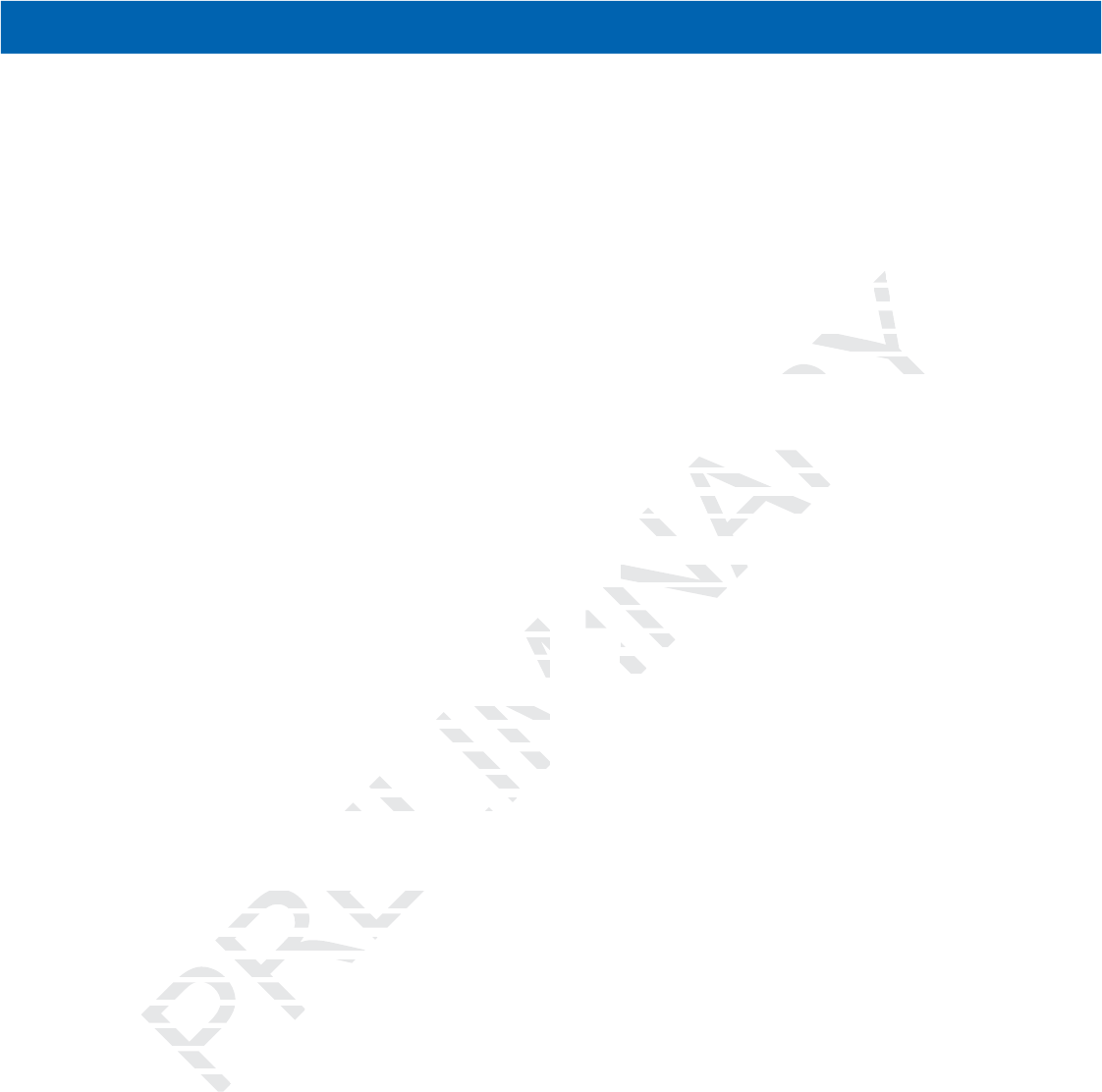
Index - 3
numeric keypad
input modes . . . . . . . . . . . . . . . . . . . . . . . . . . . . B-4
O
operating
environment . . . . . . . . . . . . . . . . . . . . . . . . . . . . A-1
operating system . . . . . . . . . . . . . . . . . . . . . . . . . . . . . . ii
P
parts . . . . . . . . . . . . . . . . . . . . . . . . . . . . . 1-2, 1-3, 2-17
platform SDK . . . . . . . . . . . . . . . . . . . . . . . . . . . . . . . . . iv
power button . . . . . . . . . . . . . . . . . . . . . . . . . . . . . . . 2-1
power supply . . . . . . . . . . . . . . . . . . . . . . . . . . . . . . . 6-1
program menu . . . . . . . . . . . . . . . . . . . . . . . . . . . . . . 2-7
properties . . . . . . . . . . . . . . . . . . . . . . . . . . . . . . . . . 2-9
R
radios . . . . . . . . . . . . . . . . . . . . . . . . . . . . . . . . . . . . . . ii
rapid deployment . . . . . . . . . . . . . . . . . . . . . . . . . . . 2-7
remove battery . . . . . . . . . . . . . . . . . . . . . . . . . . . . . 1-8
remove the handstrap . . . . . . . . . . . . . . . . . . . . . . . 6-15
reset
hard . . . . . . . . . . . . . . . . . . . . . . . . . . . . . . . . . . 4-3
soft . . . . . . . . . . . . . . . . . . . . . . . . . . . . . . . . . . . 4-3
resetting . . . . . . . . . . . . . . . . . . . . . . . . . . . . . . . . . 2-12
resume . . . . . . . . . . . . . . . . . . . . . . . . . . . . . . . . . . . 4-3
run . . . . . . . . . . . . . . . . . . . . . . . . . . . . . . . . . . . . . . . 2-7
S
sample applications demo window . . . . . . . . . . . . . . 2-1
scan . . . . . . . . . . . . . . . . . . . . . . . . . . . . . . . . . . . . 2-12
scan buttons . . . . . . . . . . . . . . . . . . . . . . . . . . . . . . . 1-2
scanning . . . . . . . . . . . . . . . . . . . . . . . . . . . . . . . . . 2-12
adjusting the distance . . . . . . . . . . . . . . . . . . . . . 3-3
angle . . . . . . . . . . . . . . . . . . . . . . . . . . . . . . . . . . 3-2
imaging . . . . . . . . . . . . . . . . . . . . . . . . . . . . . . . . 3-1
range . . . . . . . . . . . . . . . . . . . . . . . . . . . . . . . . . 3-2
scanning considerations . . . . . . . . . . . . . . . . . . . . . . 3-2
screen
calibration . . . . . . . . . . . . . . . . . . . . . . . . . . . . . . 1-7
screen contrast . . . . . . . . . . . . . . . . . . . . . . . . . . . . . 2-4
SD card . . . . . . . . . . . . . . . . . . . . . . . . . . . . . . . . . . . 1-3
installation . . . . . . . . . . . . . . . . . . . . . . . . . . . . . . 1-4
secure device card . . . . . . . . . . . . . . . . . . . . . . . . . . 1-3
security
Bluetooth . . . . . . . . . . . . . . . . . . . . . . . . . . . . . . 4-2
selecting items using the keypad . . . . . . . . . . . . . . . 2-3
settings . . . . . . . . . . . . . . . . . . . . . . . . . . . . . . . . . . . 2-7
show clock . . . . . . . . . . . . . . . . . . . . . . . . . . . . . . . 2-10
single-slot USB cradle . . . . . . . . . . . . . . . . . 1-6, 6-1, 6-3
battery charging . . . . . . . . . . . . . . . . . . . . . . . . . . 6-3
soft reset . . . . . . . . . . . . . . . . . . . . . . . . . . . . . 2-12, 4-3
spare battery
charging . . . . . . . . . . . . . . . . . . . . . . . . . . . . . . . . 1-7
start menu . . . . . . . . . . . . . . . . . . . . . . . . . . . . . . . . . 2-6
starting the mobile computer . . . . . . . . . . . . . . . 1-3, 1-7
startup . . . . . . . . . . . . . . . . . . . . . . . . . . . . . . . . . . . . 1-3
status icon . . . . . . . . . . . . . . . . . . . . . . . . . . . . . . . . . 2-5
storing . . . . . . . . . . . . . . . . . . . . . . . . . . . . . . . . . . . . 7-1
stylus . . . . . . . . . . . . . . . . . . . . . . . . . . . . 2-10, 2-11, 6-2
suspend . . . . . . . . . . . . . . . . . . . . . . . . . . . . . . . 2-7, 4-3
T
task manager . . . . . . . . . . . . . . . . . . . . . . . . . . . . . . . 2-9
taskbar . . . . . . . . . . . . . . . . . . . . . . . . . . . . . . . . . . . . 2-5
technical specifications . . . . . . . . . . . . . . . . . . . . . . . A-1
temperature . . . . . . . . . . . . . . . . . . . . . . . . . . . . . . . . A-2
terminal
charging . . . . . . . . . . . . . . . . . . . . . . . . . . . . . . . . 2-5
terminal charging . . . . . . . . . . . . . . . . . . . . . . . . . . . . 2-5
troubleshooting . . . . . . . . . . . . . . . . . . . . . . . . . . . . . 7-6
cables . . . . . . . . . . . . . . . . . . . . . . . . . . . . . . . . . 7-9
four-slot charge only cradle . . . . . . . . . . . . . . . . . 7-8
four-slot spare battery charger . . . . . . . . . . . . . . 7-9
mobile computer . . . . . . . . . . . . . . . . . . . . . . . . . 7-6
single-slot USB cradle . . . . . . . . . . . . . . . . . . . . . 7-8
turning the radios off
WLAN . . . . . . . . . . . . . . . . . . . . . . . . . . . . . . . . . 1-9
U
unpacking . . . . . . . . . . . . . . . . . . . . . . . . . . . . . . . . . . 1-1
updates, documentation . . . . . . . . . . . . . . . . . . . . . . . . iv
USB charging Cable . . . . . . . . . . . . . . . . . . . . . . . . . 6-2
USB charging cable . . . . . . . . . . . . . . . . . . . . . . . . . . 1-6
using stylus . . . . . . . . . . . . . . . . . . . . . . . . . . . . . . . 2-10
W
wakeup conditions . . . . . . . . . . . . . . . . . . . . . . . . . . 2-13
warm boot . . . . . . . . . . . . . . . . . . . . . . . . . . . . 2-12, 4-3
Windows CE .NET 6.0 Professional . . . . . . . . . 2-2, 2-7
wireless status icon . . . . . . . . . . . . . . . . . . . . . . . . . . 2-6
WLAN status . . . . . . . . . . . . . . . . . . . . . . . . . . . . . . . 2-6
WPAN Bluetooth . . . . . . . . . . . . . . . . . . . . . . . . . . . . . . ii
PRELIMINARY
2-7
2-7
. . 1-8
1-8
. . . 6-15
5
. . . . . . . . 4-3. . . . . . . . 4-3
. . . . . . . . . . 4-3 . . . . . . . 4
. . . . . . . . . . . 2-12
. . . . 2-12
. . . . . . . . . . . . . . 4-
. . . . . . . . . . . . . .
. . . . . . . . . . . . . . . .
. . . . . . . . . . . . . . . .
demo window . . . . . demo window . . . . .
. . . . . . . . . . . . . . . . . . . . . . . . . . . . . . . .
. . . . . . . . . . . . . . . . . . . . . . . . . . . . . . .
. . . . . . . . . . . . . . . . . . . . . . . . . . . . . . . . . .
ing the distance . . . .ing the distance
e . . . . . . . . . . . . . . .
e . . . . . . . . . . . . . .
ng . . . . . . . . . . ng . . . .
. . . . . . . . . . . .
deratdera
. .
.
. . . . . .
.
. . . . . . . . . . .
. .
. . . . . . . . . . . . . 2-1
. . . . . . . .
. . . . . . . . . . . . . . . . .
. . . . . . . . . . . . . .
er . . . . . . . . . . . . . . .
er . . . . . . . . . .
. . . . . . . . . . . . . . . . .
. . . . . . . . . . . . . .
cal specifications . . .
cal specifications . .
perature . . . . . . . . .
rature . . . . .
erminal
charging . . . . . charging . . . . .
terminal charging
rminal charging
troubleshootin
troublesh
cables
cables
four-
fou
fo

Index - 4 MC21XX Series User Guide
PRELIMINARY
PRELIMINARY
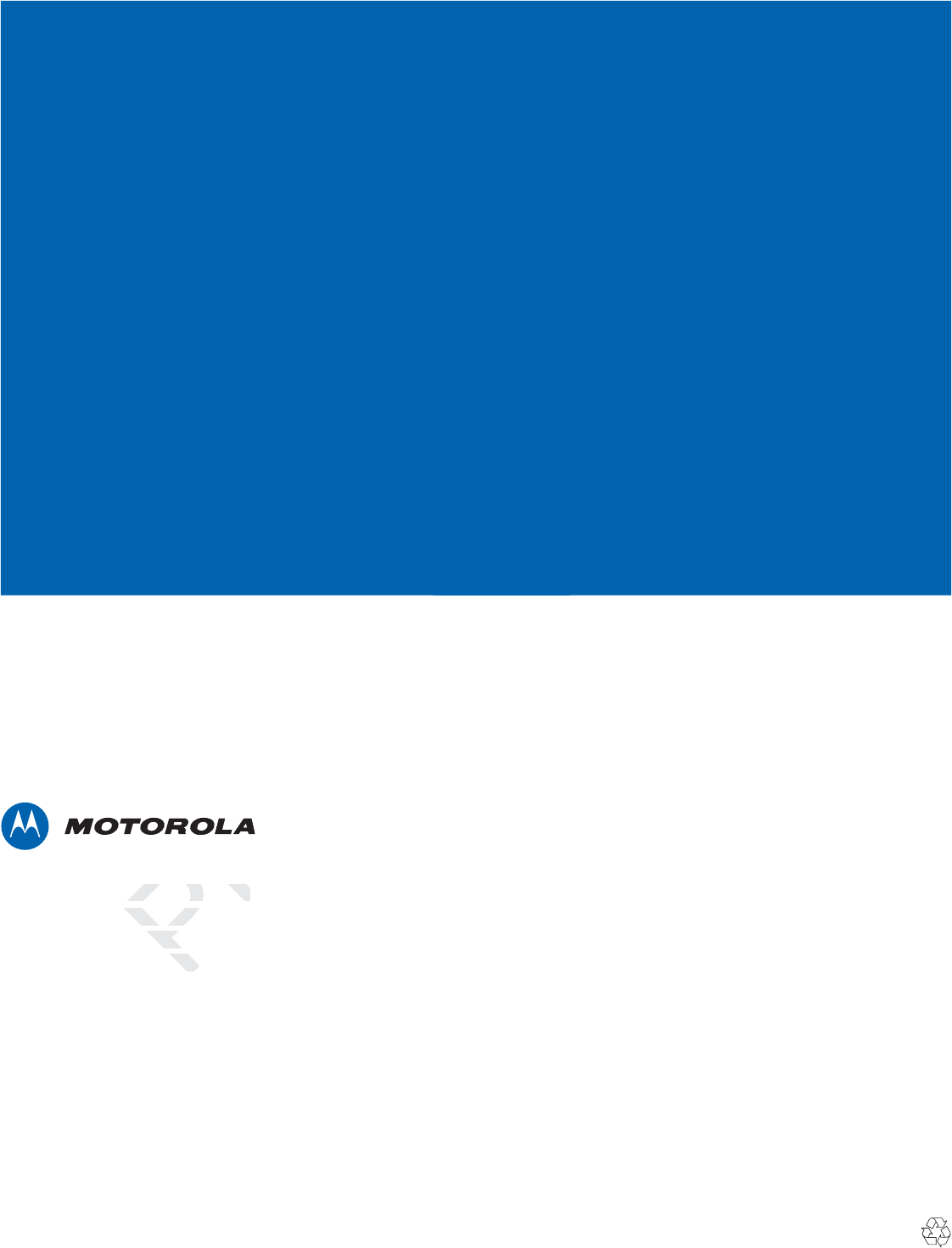
72E-155020-01 Revision 091111 - September 2011
Motorola Solutions, Inc.
1301 E. Algonquin Rd.
Schaumburg, IL 60196-1078, U.S.A.
http://www.motorolasolutions.com
MOTOROLA, MOTO, MOTOROLA SOLUTIONS and the Stylized M Logo are trademarks or registered
trademarks of Motorola Trademark Holdings, LLC and are used under license. All other trademarks are
the property of their respective owners.
© 2011 Motorola Solutions, Inc. All Rights Reserved.
PRELIMI
MINARY
MI
R
R
R
R
P
a Solutions, Inc.a Solutions, Inc.
Algonquin Rd.
Algonquin
urg, IL 60196urg, IL
motoro
motor